GUIDELINES FOR BUSINESSES
Legislative decree dated 3 September 2020 has made environmental labelling compulsory, introducing new rules that need to be clarified. In order to provide companies with useful information on this subject, CONAI had drawn up its own Guidelines and an interactive online tool called e-tichetta.
Letter from President of CONAI
There has long been a growing demand for information on environmental sustainability, particularly when it comes to packaging.
As far back as 1997, when this issue was not so “fashionable”, the European lawmakers had already set up an environmental labelling system for packaging, and this, although voluntary, was adopted by most companies.
Recent regulatory developments have made environmental labelling mandatory, but this has raised many doubts of interpretation as to what information the labels should in fact contain.
Over the years, CONAI has developed unique experience in sustainable packaging design. Through collaboration with its member companies, over ten years ago the Consortium kicked off Pensare Futuro, a container of tools, guidelines and initiatives dedicated to this issue.
This project resulted, among other things, in Epack, CONAI’s information desk on sustainable packaging design, which has been offering companies significant support since 2013.
Increase in demand over the last year has led CONAI to start working on its e-tichetta tool, dedicated exclusively to the environmental labelling of packaging so as to share its long-standing experience in this field.
The hope is that these Guidelines and the e-tichetta tool may clarify any doubts over the interpretation of the new regulations and direct companies towards their correct application.
The document clearly identifies the information to be reported on the environmental label, along with practical examples arising from the experience of numerous companies.
Given the above, I have considered it important to make these Guidelines available for public consultation.
More than 300 users have registered for the public consultation platform Design for Recycling , which has received over one hundred comments.
More than 1000 emails have been sent by companies and associations through the epack channel, asking us to handle certain issues, requesting clarifications, and highlighting the various problems this new obligation has generated.
Such feedback has helped to make the document more comprehensive and complete.
But in addition to the Guidelines and the e-tichetta tool, I also think it is important to create fertile ground for a virtuous contamination of good practices - which is why we are pursuing our call to action aimed at collecting and promoting virtuous environmental labels, so that they can be an example and inspiration for all companies, especially small and medium-sized ones.
To conclude, I would like to thank all those who have worked to produce this document, with competence and commitment.
Milan, October 2020
Luca Ruini
President of CONAI
Introduction
On 11 September 2020, issue no. 116 of the Official Journal of the Italian Republic published Legislative Decree no. 3 of September 2020, which implements EU Directive 2018/851 on waste and EU Directive 2018/852 on packaging and packaging waste.
Art. 3, paragraph 3, letter c) of said decree introduces amendments to art. 219, paragraph 5 (Criteria inspiring the management of packaging waste) of Legislative Decree no. 152 (“Environmental regulations”) dated 3 April 2006, as updated and amended.
The wording of the labelling requirement introduced by the new regulations leaves room for interpretation, particularly as regards the content of the labels, the parties to whom the obligation applies and its scope, as well as generating great concern among companies as to the time frame granted in which to comply with the obligation.
It is for this reason that CONAI has organised a working table tasked with analysing and managing the numerous reports made by individual companies and associations of producers and industrial/commercial users, with the involvement of UNI, Confindustria and FederDistribuzione, with a view to obtaining a clearer reading of the new obligation imposed at the national level. As a result of this meeting, the document entitled “Environmental labelling of packaging” was drawn up. This guide aims to offer a clearer interpretation of the regulations, enabling companies to resolve their main doubts and address the main problems relating to the application of art. 219, paragraph 5. This Guideline is periodically updated in the light of ongoing dialogue and discussions with companies and associations, as well as of regulatory developments.
CONAI has also developed a tool, made available through its website, entitled e-tichetta. This support tool has been designed to help businesses create their environmental labels independently. Moreover, it allows users to simulate different, recommended labelling models based on the specific needs of the company and its products.
Approach to environmental labelling
Legislative Decree no. 116 of 3 September 2020 states that all packaging shall be “appropriately labelled in accordance with the procedures laid down in the applicable UNI technical standards and in compliance with the decisions of the European Commission, in order to facilitate the collection, reuse, recovery and recycling of packaging, and to provide consumers with proper information on the final destination of packaging. For the purposes of identifying and classifying packaging, producers are also required to indicate the nature of the packaging materials used, on the basis of Commission Decision 97/129/EC.”
The subject of Article 219, paragraph 5 is the environmental labelling of packaging, and does not take into consideration any other product label to be displayed on the packaging.
Below is our interpretation of the various passages of the article, on which we have based the explanations and insights provided herein, supported by concrete examples. Let's see them together.
All packaging must be appropriately labelled in accordance with the procedures laid down in the applicable UNI technical standards.
- All packaging must be labelled “appropriately”, and therefore in the form and manner that the company considers most suitable and effective for achieving the goal.
- The reference to UNI standards is generic, especially if we consider their voluntary nature. Therefore, the regulations imply that, if a company wishes to state certain contents on the environmental label, then the reference UNI standards should be adopted. But what information can be communicated through the UNI standards to which the regulations refer?
- Identification of packaging materials for plastic packaging. When Decision 129/1997 does not include a specific identification code for a specific polymer, the applicable standards are UNI 1043-1 for the identification of plastics not included in Decision 129/1997 and UNI 10667-1 for the identification and recognition of recycled polymers.
- Identification of packaging materials for multi-layer plastic packaging. Also in these cases, Decision 129/97/EC does not include specific identification codes: the UNI 11469 standard lends a helping hand in communicating the composition of structures made up of several polymers.
- Environmental self-declarations. Where additional voluntary information concerning the environmental qualities of the packaging is to be provided (inscriptions, symbols/pictograms or other similar messages, environmental claims), reference should be made to UNI EN 14021.
and in compliance with the decisions of the European Commission, in order to facilitate the collection, reuse, recovery and recycling of packaging
At present, among the “decisions” adopted by the European Commission in relation to environmental labelling, we find only Decision 129/1997/EC, which is later mentioned specifically.
and to provide consumers with proper information on the final destination of packaging.
Who are consumers?
According to the Consumer Code (art. 3, paragraph 1), the consumer or user is a “natural person who acts for purposes extraneous to any business, commercial, artisanal or professional activity carried out…”
In a similar fashion, art. 218, paragraph 1, letter v) of Legislative Decree 152/2006 refers to the consumer as the party who, acting outside the exercise of a professional activity, buys or imports packaging or packaged articles or goods for his or her own use.
What is the information on the final destination of packaging?
Information on the final destination of packaging is that which communicates its correct disposal at the end of its useful life (e.g. separate waste collection. Check your local municipal guidelines).
So, what packaging should be covered?
Said information should cover:
- packaging offered to the end consumer as is, for sale or even free of charge;
- packaging offered to the end consumer in the form of a pre-packaged product, for sale or even free of charge.
Instead, said information should exclude packaging destined for the B2B channel (packaging assigned, as is or in the form of a pre-packaged product, to a “professional”, i.e. a “natural or legal person, or an intermediary thereof, acting in the exercise of his business, commercial, artisanal or professional activity” (art. 3, paragraph 1 of the Consumer Code).
For the purposes of identifying and classifying packaging, producers are also required to indicate the nature of the packaging materials used, on the basis of Commission Decision 97/129/EC.
- In their breakdown of identification codes per material, the lawmakers did not make explicit reference to packaging destined for the use of the “consumer”, therefore there is no evidence to exclude packaging destined for professional use from the process of identification and classification under Decision 129/97/EC. All packaging, therefore, is subject to identification and classification.
- Only with regard to affixing identification codes of materials on the basis of Decision 97/129/EC is the obligation expressly imposed on producers.
- If Decision 129/97/EC does not require specific identification of plastic polymers in the packaging’s composition, voluntary use may be made of the UNI standards described above.
TO RECAP
This interpretation of the decree gives rise to important observations:
- Producers must indicate the alphanumeric code provided for in Decision 97/129/EC on all packaging (primary, secondary and tertiary);
- All packaging must be labelled in the form and manner that the company considers most suitable and effective for achieving the goal;
- Packaging destined for the consumer must also bear suitable inscriptions aiding its disposal;
- For plastic packaging made from polymers or polymer combinations not expressly provided for in Decision 97/129/EC, reference may be made to the UNI 1043-1 standards for the identification of plastics not included in said Decision, and to the UNI 10667-1 standards for the identification and recognition of recycled polymers.
APPLICABLE LEGISLATION AND REFERENCE GUIDELINES
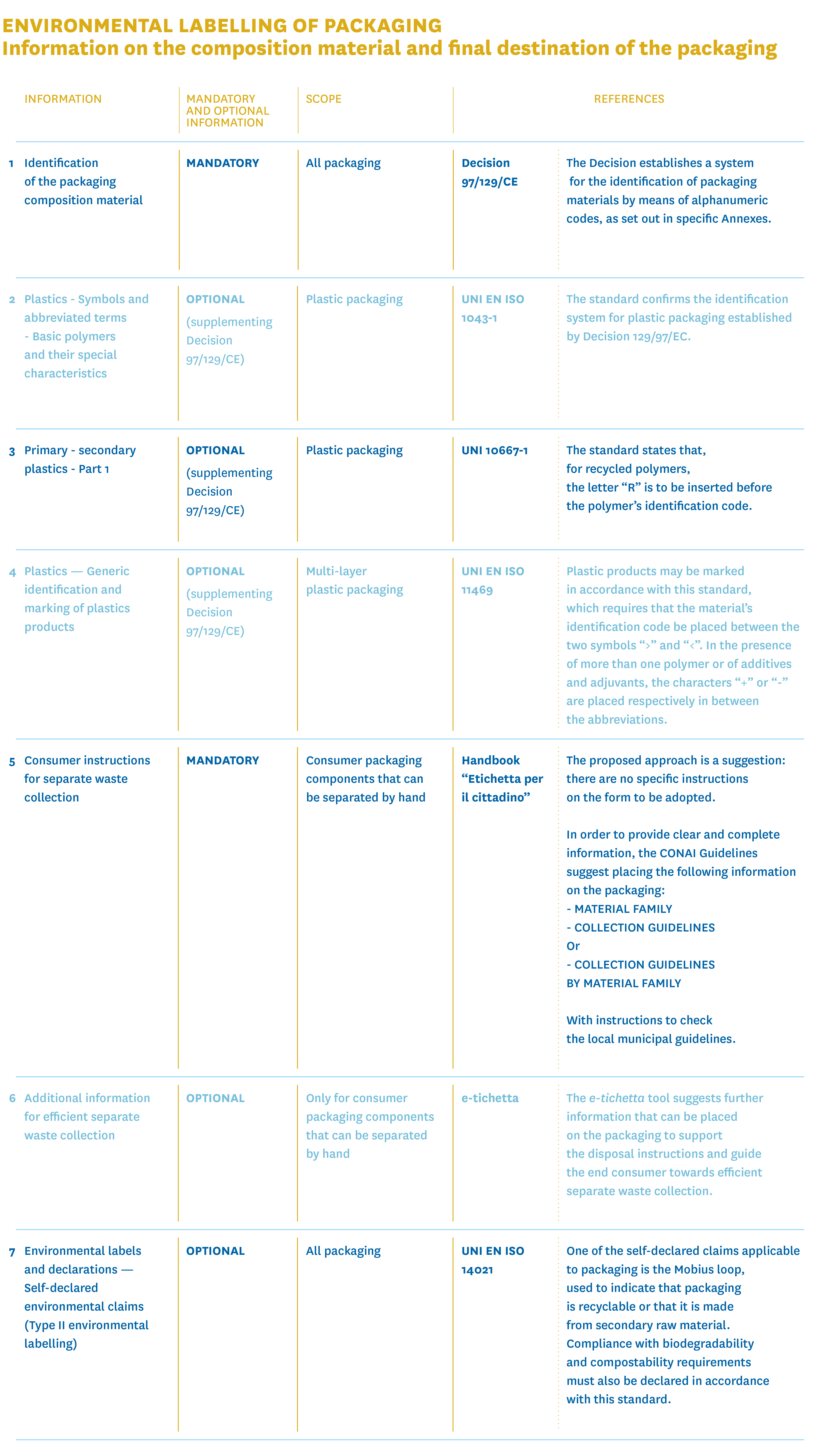
To be clear
When is packaging considered recyclable?
Packaging considered recyclable in accordance with the technical standard UNI EN ISO 13430 meets the criteria of eligibility for existing recycling technologies, namely:
- existence of an efficient recycling technology for the type of packaging;
- existence of a critical mass so that an efficient recycling process may be managed;
- existence of a market for recycled materials.
These criteria must be assessed via specific surveys and studies.
(For more information, see the Design for Recycling Guidelines).
When is packaging considered compostable?
An item of packaging is considered to be biodegradable and compostable when it complies with technical standard UNI EN ISO 13432.This is the harmonised European standard which, within the framework of packaging directive 94/62, sets out the “Requirements for packaging recoverable through composting (...)”. Biodegradability and compostability certifications are issued by accredited third-party bodies. The accreditation of these bodies takes the form of a procedure for certifying their independence and impartiality by the Single National Accreditation Body, which in Italy is Accredia. On the Accredia website it is possible to consult a database in which the accredited bodies and laboratories for issuing these certifications of compliance are listed.
What packaging can be collected separately?
Packaging can be placed in separated waste collection, whether or not it is recyclable using existing technologies, provided it is separated efficiently (primarily, always emptying the packaging of its contents). In fact, through CONAI’s system – Supply Chain Consortia, recyclable packaging will be recycled; otherwise it will be destined for energy recovery.
An evaluation of the packaging's recyclability is one of the additional pieces of information that a company may choose to display on the packaging, but this is independent of the information regarding the correct disposal of the packaging.
The only exception to this rule concerns mainly paper-based composite packaging (and/or with non-manually separable components of different materials), with a percentage of cellulose material less than 60% of the total weight, a percentage that compromises the recyclability of the packaging, making it impossible, with obvious consequences in terms of environmental impact. In the recycling process, in fact, 100 kg of this packaging produces more than 85 kg of dry waste and almost 150 kg of wet waste to be disposed of in landfills, after consuming water and electricity. Therefore, since this packaging is not recyclable with paper and cardboard, the companies that produce and use it are asked to advise on the labelling that it is put in the mixed waste collection, in order to minimise the environmental impact linked to its end-of-life management.
The content of environmental labels: some examples
Our interpretation of the decree gives rise to two different scenarios regarding the minimum content to be stated on the environmental label, based on the packaging’s destination circuit: B2B (professional) or B2C (consumer). Starting from this assumption, in addition to including distinct diagrams for B2B or B2C destinations, these guidelines also address different packaging structures: single-component and multi-component packaging/packaging systems.
The following diagrams include 3 levels of information:
- Mandatory, to comply with the regulations
- Highly recommended, to make communication more effective
- Recommend, to provide additional information for efficient separate waste collection
ENVIRONMENTALLABELLING OF SINGLE-COMPONENT B2C PACKAGING
For single-component packaging destined for the end consumer, the following information should be given:
- The packaging material’s identification code under Decision 129/97/EC;
- Collection guidelines. It is advisable:
- to specify the wording “Collection (main material family by weight)”
or
-
to indicate the main material family by weight, accompanied by the wording “Separate collection”, and invite the consumer to check the provisions of his or her Municipality.
- to specify the wording “Collection (main material family by weight)”
These are the wordings suggested by CONAI; nevertheless, the legislation does not stipulate precise wordings but recommends that packaging is appropriately labelled, with a view to achieving the objective.
Other information that may be voluntarily added to environmental labels relates to the type of packaging and instructions that will guide the consumer towards efficient separate waste collection.
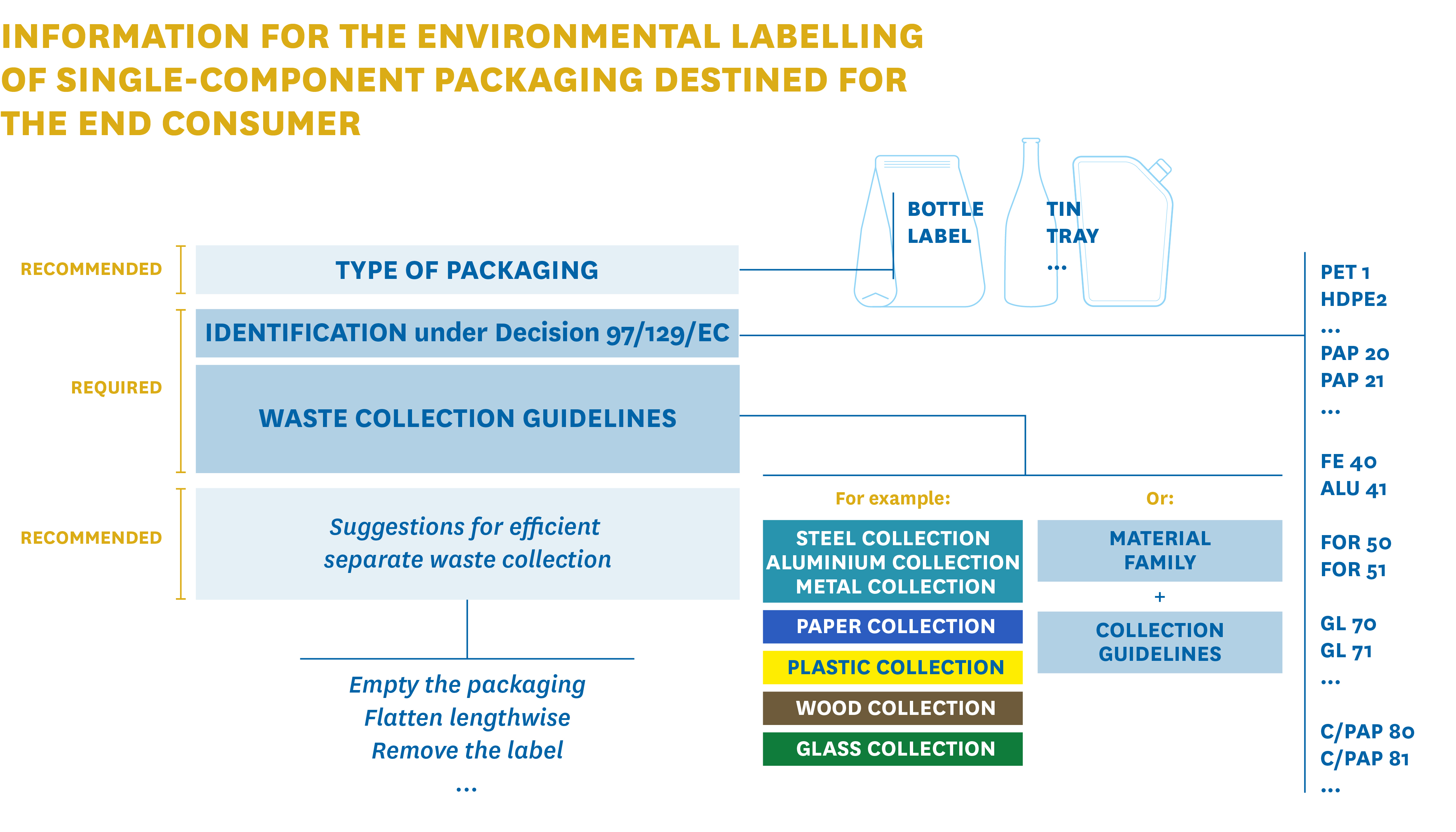
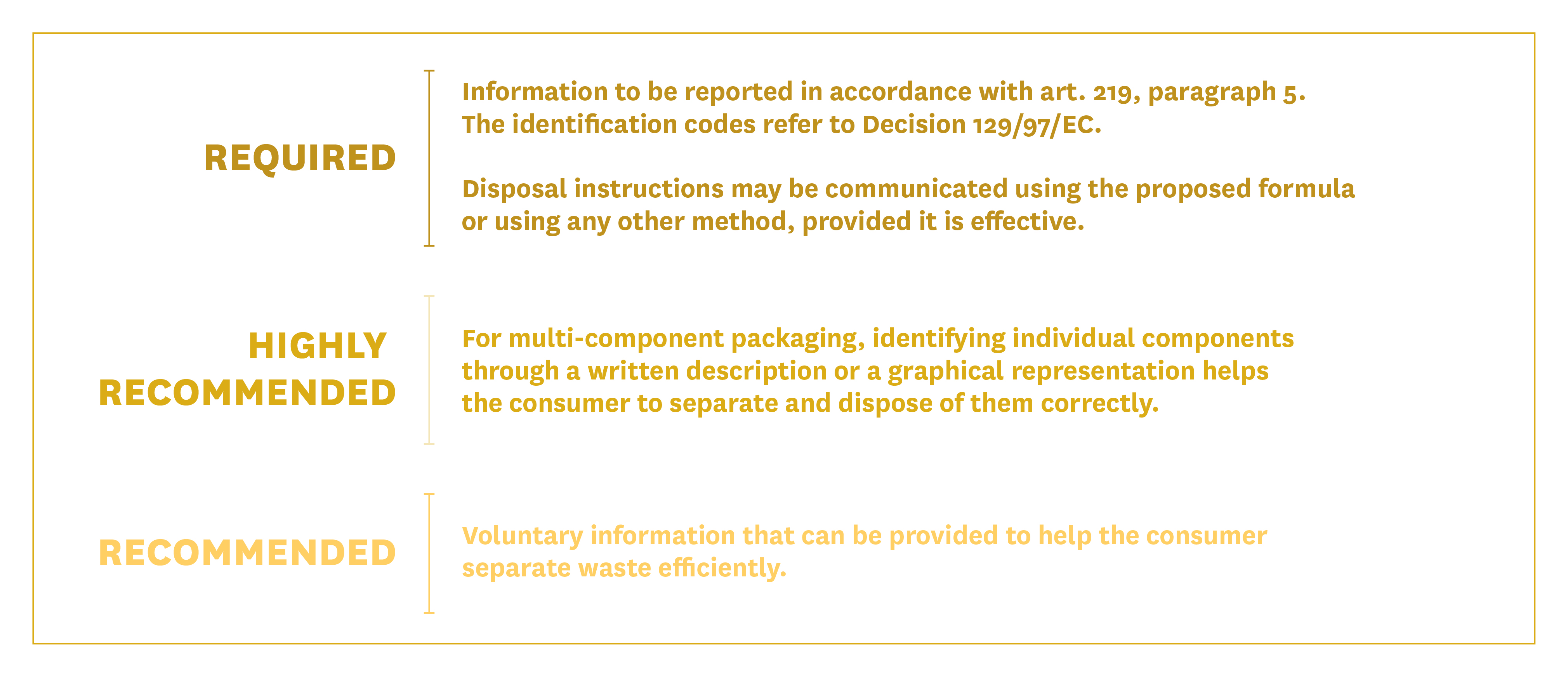
ENVIRONMENTAL LABELLING OF MULTI-COMPONENT B2C PACKAGING
For packaging consisting of several components, it is important to distinguish between components which cannot be separated by hand (for example, a paper label attached to a glass bottle) and components that can be separated by hand by the end consumer (for example, a snack multipack). This is because identification and classification under Decision 129/97/EC are envisaged for packaging components that can be separated by hand.
To be clear
What are packaging components that can be separated by hand?
A component may be separated by hand when the user can separate it completely (except for any minimal material residue that might remain stuck after separation), without any risk to his health or safety; from the main body, with the sole use of the hands and without the need for additional tools or instruments.
This means that each packaging component that can be separated by hand must bear at least:
- The packaging material’s identification code under Decision 129/97/EC
- Information on separate waste collection when this is not indicated on the outer presentation packaging. It is advisable:
- to specify the wording “Collection (main material family by weight)”
or
- to indicate the main material family by weight, accompanied by the wording “Separate collection”, and invite the consumer to check the provisions of his or her Municipality.
These are the wordings suggested by CONAI; nevertheless, the legislation does not stipulate precise wordings but recommends that packaging is appropriately labelled, with a view to achieving the objective.
When it is not possible to indicate the relevant identification code on each individual component, for example due to a lack of space or other technological constraints, this may be stated on the main body or on the presentation packaging.
In the event of placing all the environmental labels on the outer presentation packaging, we recommend using the following format:
- Type of packaging (full written description or graphic representation) of the various components that can be separated by hand;
- Identification code of the packaging material of each component that can be separated by hand under Decision 129/97/EC;
- Collection guidelines, clearly specifying the material family of each component.
Also in this case, voluntary information may be provided to help the consumer separate waste efficiently.
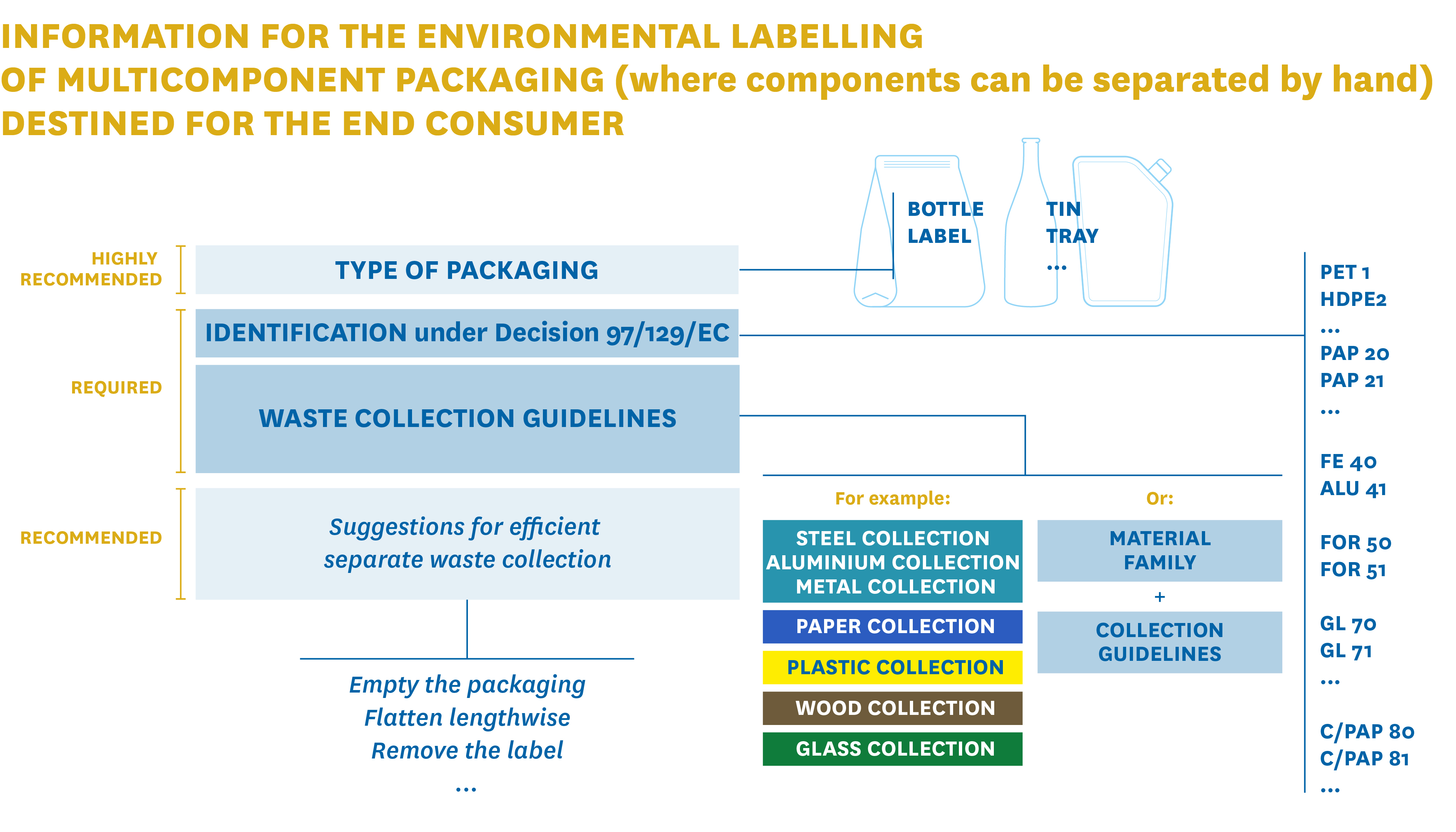

To be clear
What to do with components that cannot be separated manually?
Packaging systems that envisage a main body and other ancillary components that cannot be separated manually (e.g. adhesive labels, non-separable caps and closures, windows), must indicate the identification coding of the main body material, and collection instructions (which follow the main body material).
Where possible, only the identification coding of the material can be affixed to the components that cannot be separated manually, as per Decision 129/97/EC, but the collection instructions must not be indicated on them.
If the packaging system envisages components that can be separated manually from the main body, each of these must indicate the alphanumeric code as per Decision 129/97/EC and the collection instructions.
ENVIRONMENTAL LABELLING OF B2B PACKAGING
From our reading of the decree, B2B packaging - for example packaging destined for professionals, or transport packaging, or packaging related to logistics or exhibition activities - do not need to provide information on the final destination of the packaging, but must mandatorily bear the code of the composition materials in accordance with Decision 129/97/EC.
Every other information, instead, remains voluntary.
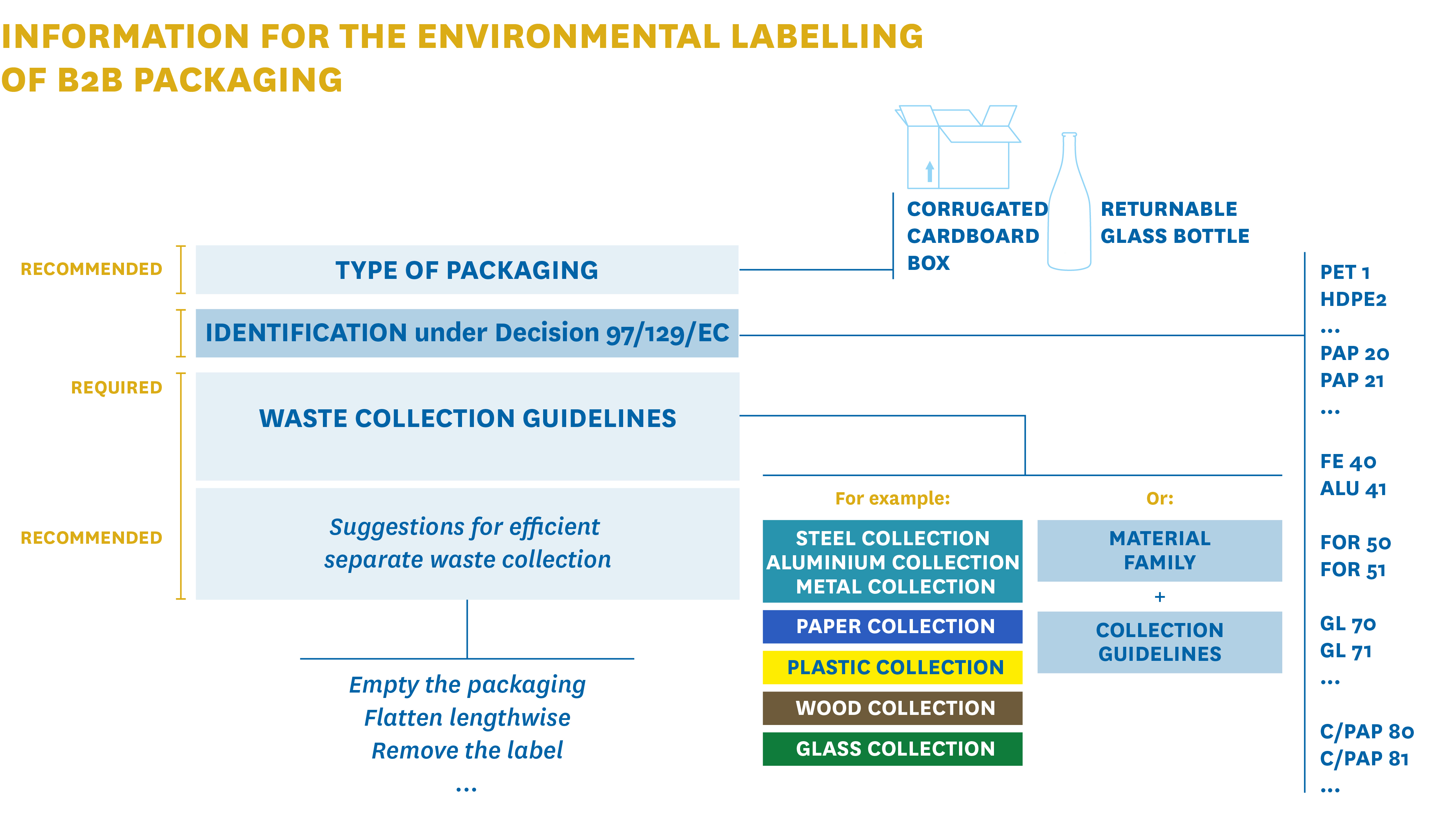

How do you create an environmental label?
Based on the above, this section of the Guidelines sets out the information that may contribute to the contents of the environmental label:
- Alphanumeric code under Decision 129/97/EC
- Material family
- Collection guidelines
Below are the Annexes to Decision 129/97/EC, for every material and for polylaminates, inclusive of the codes to be used for identification of the material making up the packaging, together with examples of complete environmental labels containing both the minimum information required by the lawmakers and additional optional information.
The examples provided are merely indicative of the type of labelling solutions that companies can adopt, and do not include every possible type of voluntary information. Companies may use graphic and presentation methods of their own choice, provided these are effective and consistent with the goals set forth in art. 219, paragraph 5.
For the graphic rendering of wordings and symbols, we suggest using the colour coding set forth by the UNI 11686 standard - Waste management - Waste visual elements.
In the following examples, we have adopted the colour coding provided for by said technical standard.
UNI 11686 standard
The standard defines specific colours and other visual elements for waste bins so that the end consumer may easily identify the correct bin, thereby facilitating waste collection.
Increasingly often, citizens find themselves having to separate waste in different cities and municipalities: colour coding helps them to identify bins correctly, thus facilitating separate waste collection even outside their own home town.
By adopting the following specific colour codes, the standard allows for instant visual recognition on the part of consumers:

To be clear
Laminating or processing: the > 5% rule
For the purposes of Decision 129/97/EC, “composite” packaging means packaging made up of different materials, which cannot be separated by hand.
Such packaging may be the result of processing (e.g. coating, metallic treatment, rolling, lacquering) or laminating techniques.
For such packaging, the alphanumeric coding of Decision 129/97/EC is provided in Annex VII, which includes different codes depending on the material family prevailing in weight and the secondary material family.
The 5% threshold
For the proper identification of composite or multilayer packaging materials, when the weight of the secondary material(s) is less than 5% of the total weight of the packaging, it is considered single-material packing and labelled based on the material prevailing in terms of weight. Otherwise it is classified as set out in Annex VII of Decision 129/97/EC if it is composite packaging, or as category “7” as per Annex I if it is multilayer plastic packaging. This specification also applies in the case of packaging containing several secondary materials and one of these weighs < 5%. Such material is not considered for the purposes of identification.
This simplification is based on the approach adopted in COMMISSION IMPLEMENTING DECISION (EU) 2019/665, according to which, for the purposes of calculating and verifying attainment of recycling targets, Member States are required to report composite packaging and other packaging composed of more than one material, but may “derogate from this requirement where a given material constitutes an insignificant part of the packaging unit, and in no case more than 5 % of the total mass of the packaging unit”.
How should glues, adhesives, ceramic, rubber and inks be treated?
If packaging is made up of one packaging material (steel, aluminium, paper, wood, plastic, glass), laminated or processed with a material other than the packaging material (e.g. glue, adhesive, ink, ceramic, rubber), it is to be considered as single-material packaging.
For example, HDPE packaging with a layer of ink and the use of glues weighing more than 5% of the total weight of the packaging will display the code for HDPE single-material packaging.
STEEL PACKAGING
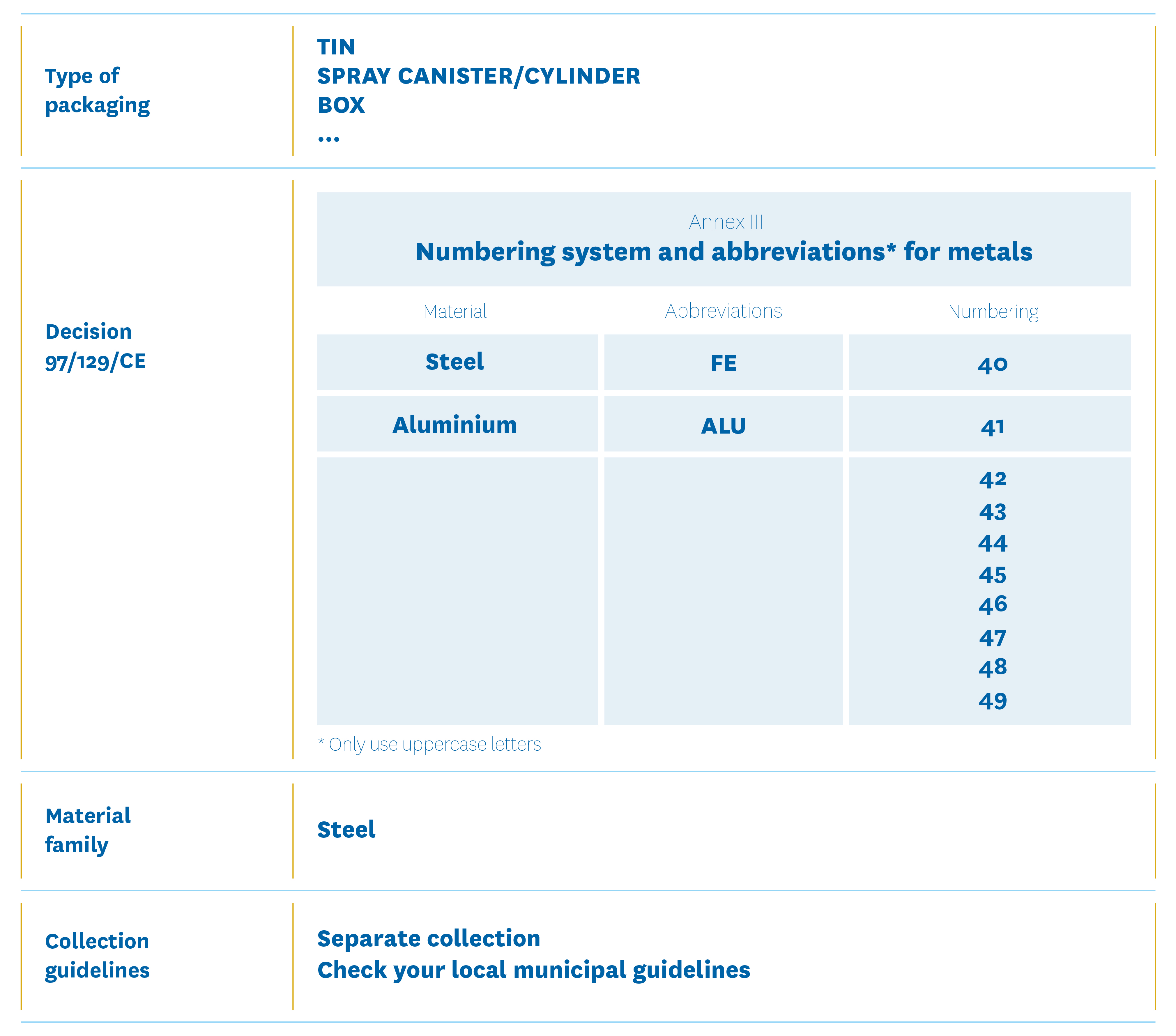
Examples
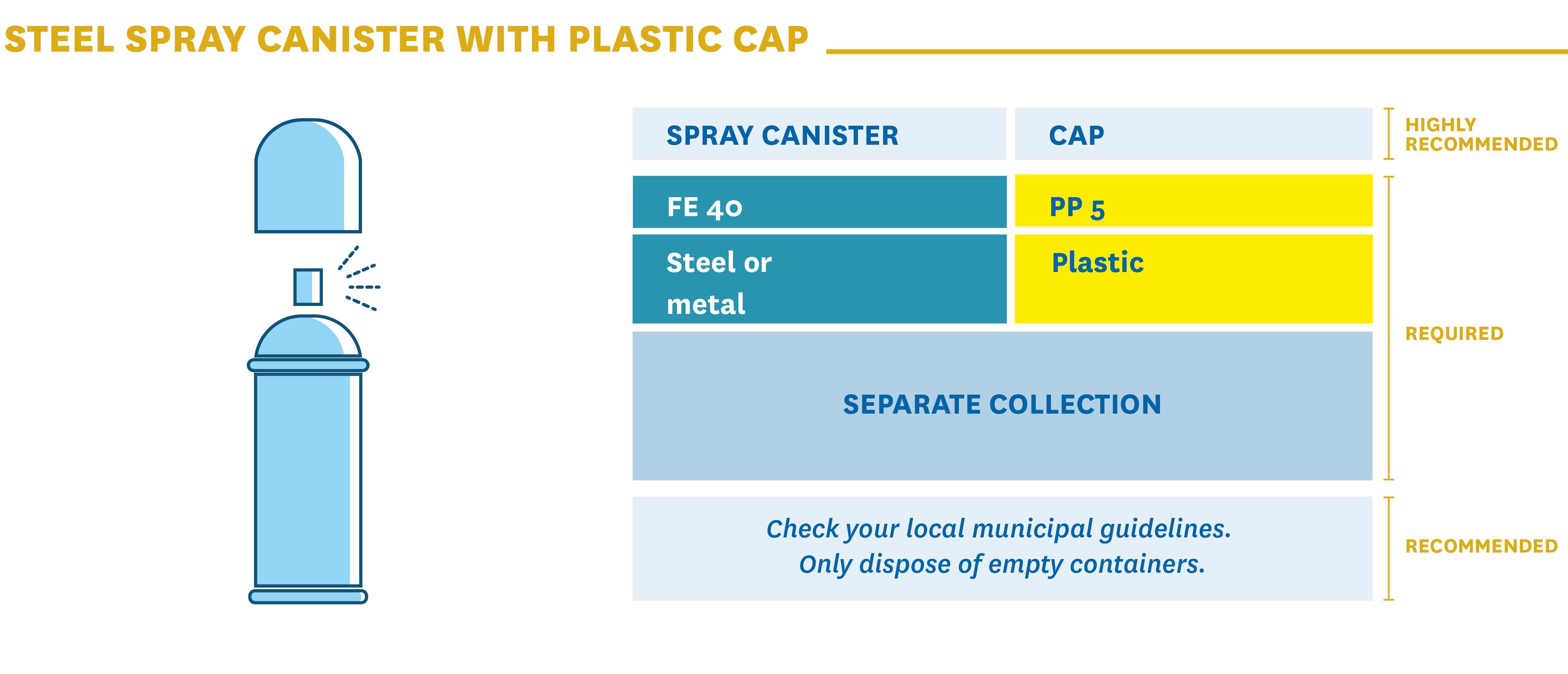
ALUMINIUM PACKAGING
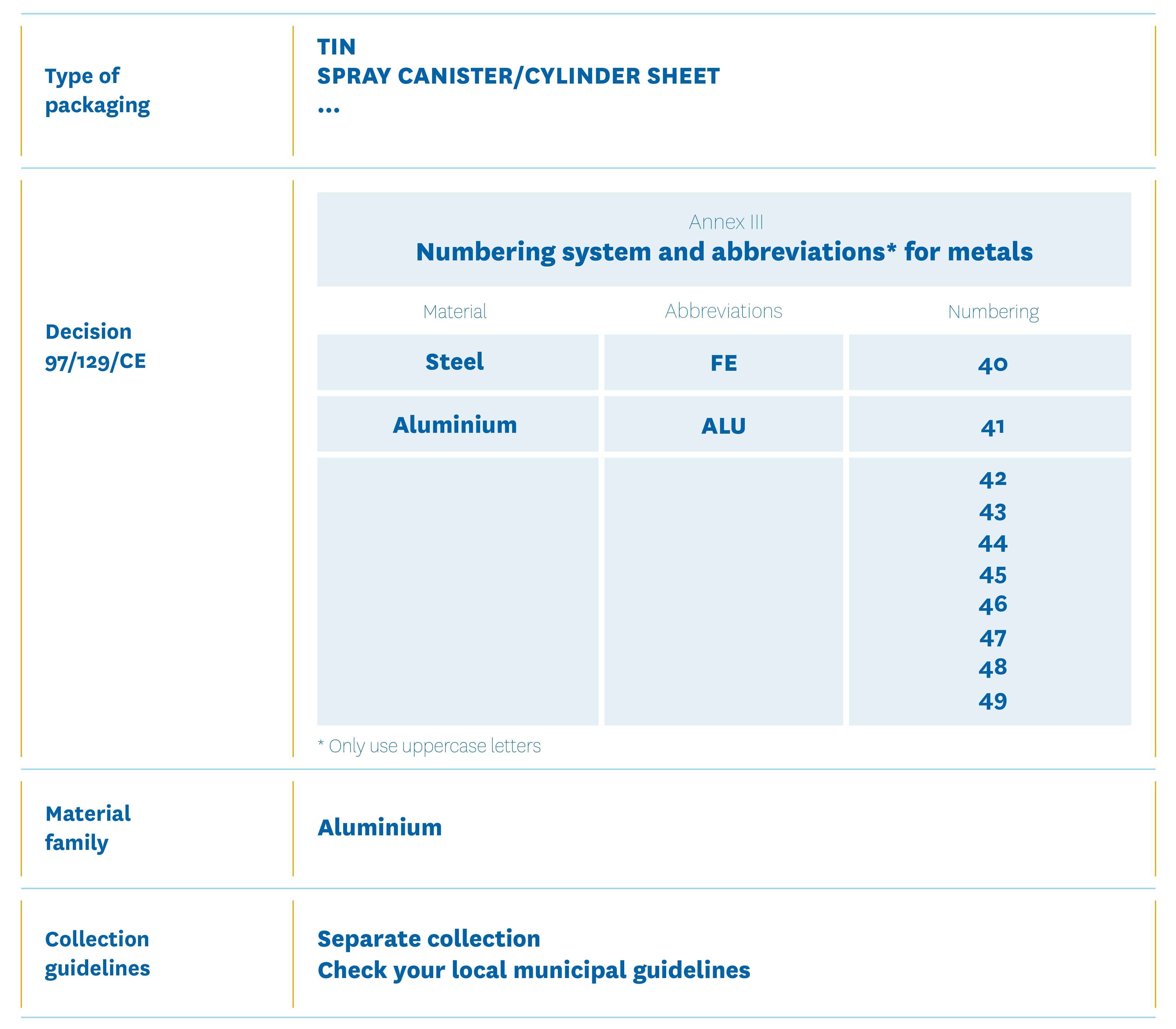
Examples
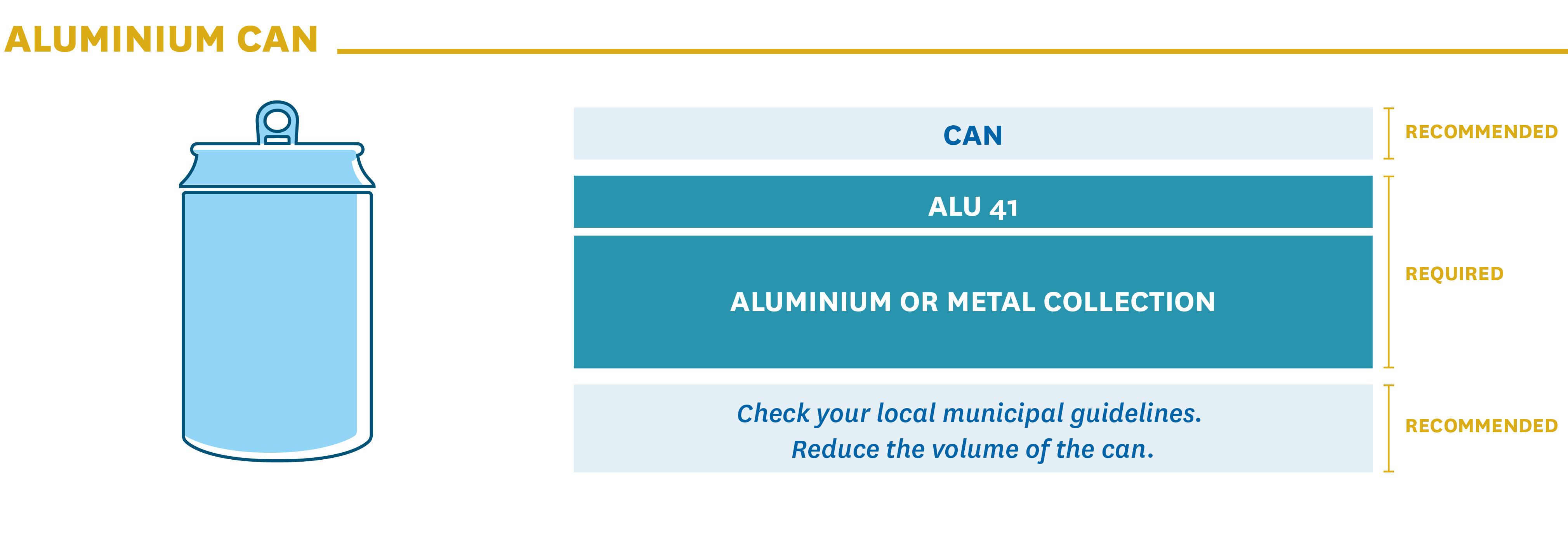
Code 42: when the metal in neither steel nor aliminium
Whenever packaging consists of metal other than steel or aluminium, not associated with any specific code in Annex III to Decision 129/97/EC, we suggest adopting the number “42”, i.e. the first code in the table to which no material is associated, and therefore “available” for other types of metals not foreseen.
PAPER PACKAGING
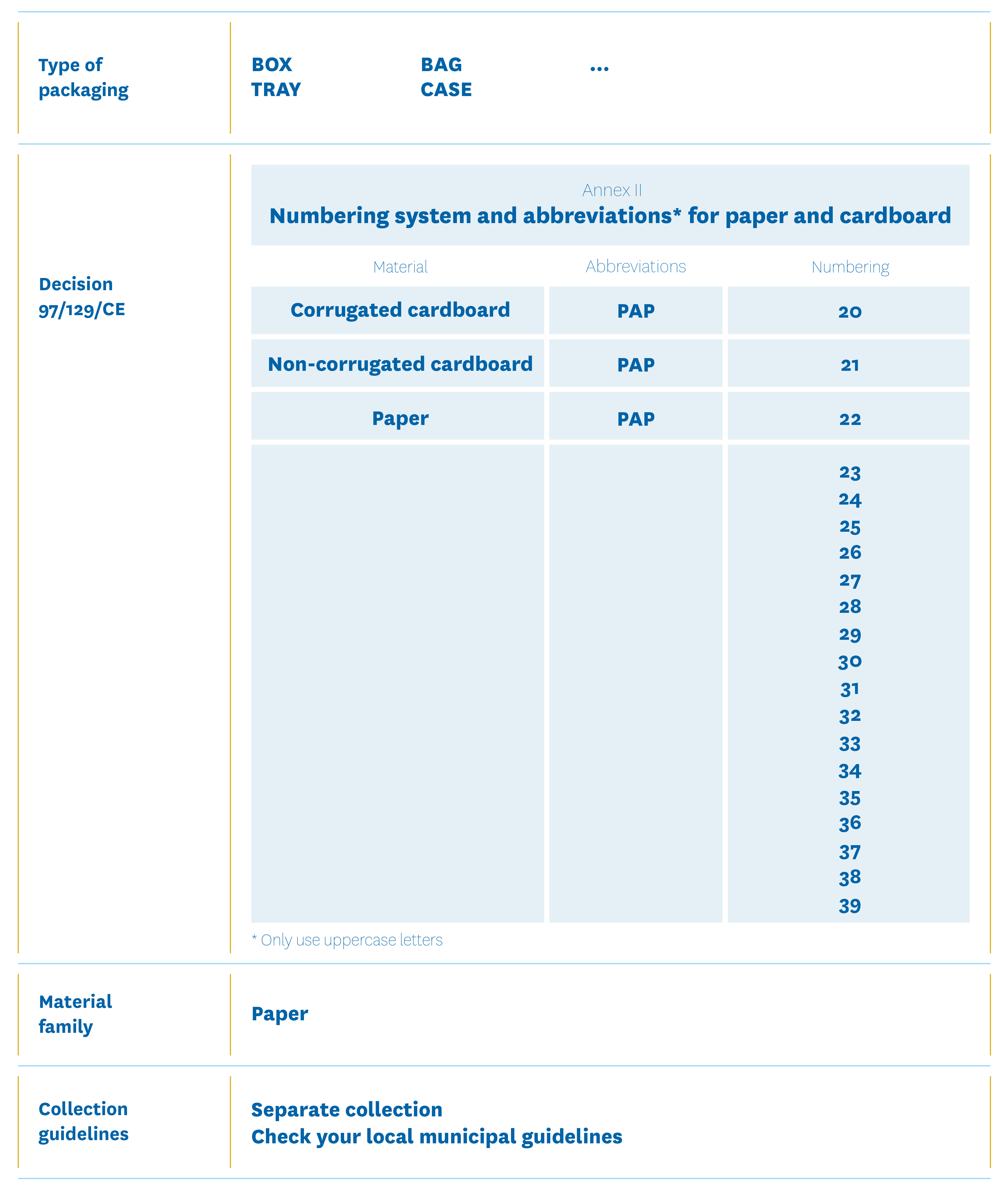
Paper, paperboard or corrugated cardboard?
Proper paper has a grammage of up to 150 g/m2, while cardboard features a grammage in excess of 600 g/m2, and as high as 1100 g/m2. Paperboard, on the other hand, is a paper-based material with a grammage that lies between paper and cardboard, identified by a grammage in the 250 to 450 g/m2 range. If we look at the above figures, we can see that there are two apparently undefined ranges, namely between 150 and 250 g/m2, and between 450 and 600 g/m2: within these ranges, the line between paper and paperboard (in the case of the former range) and between paperboard and cardboard (in the case of the latter) is a little blurred.

Examples
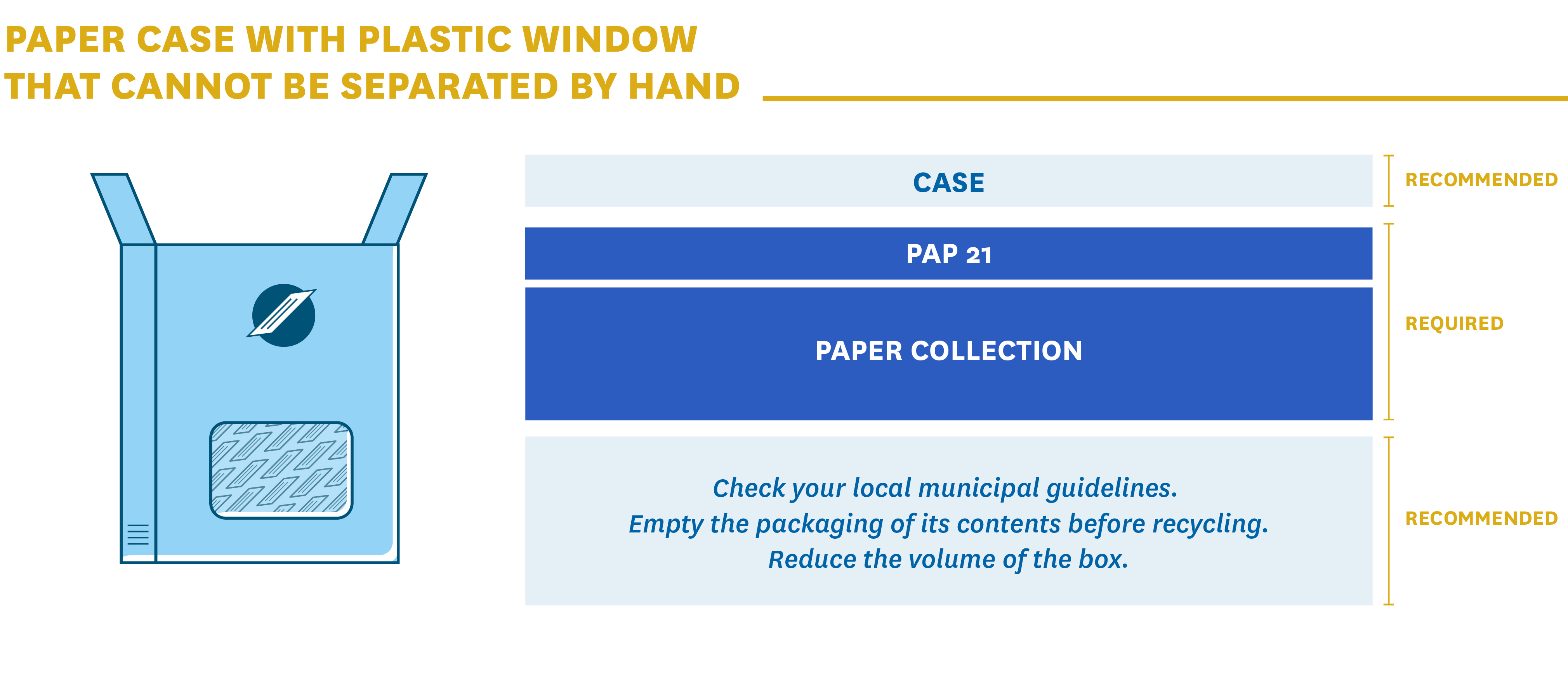
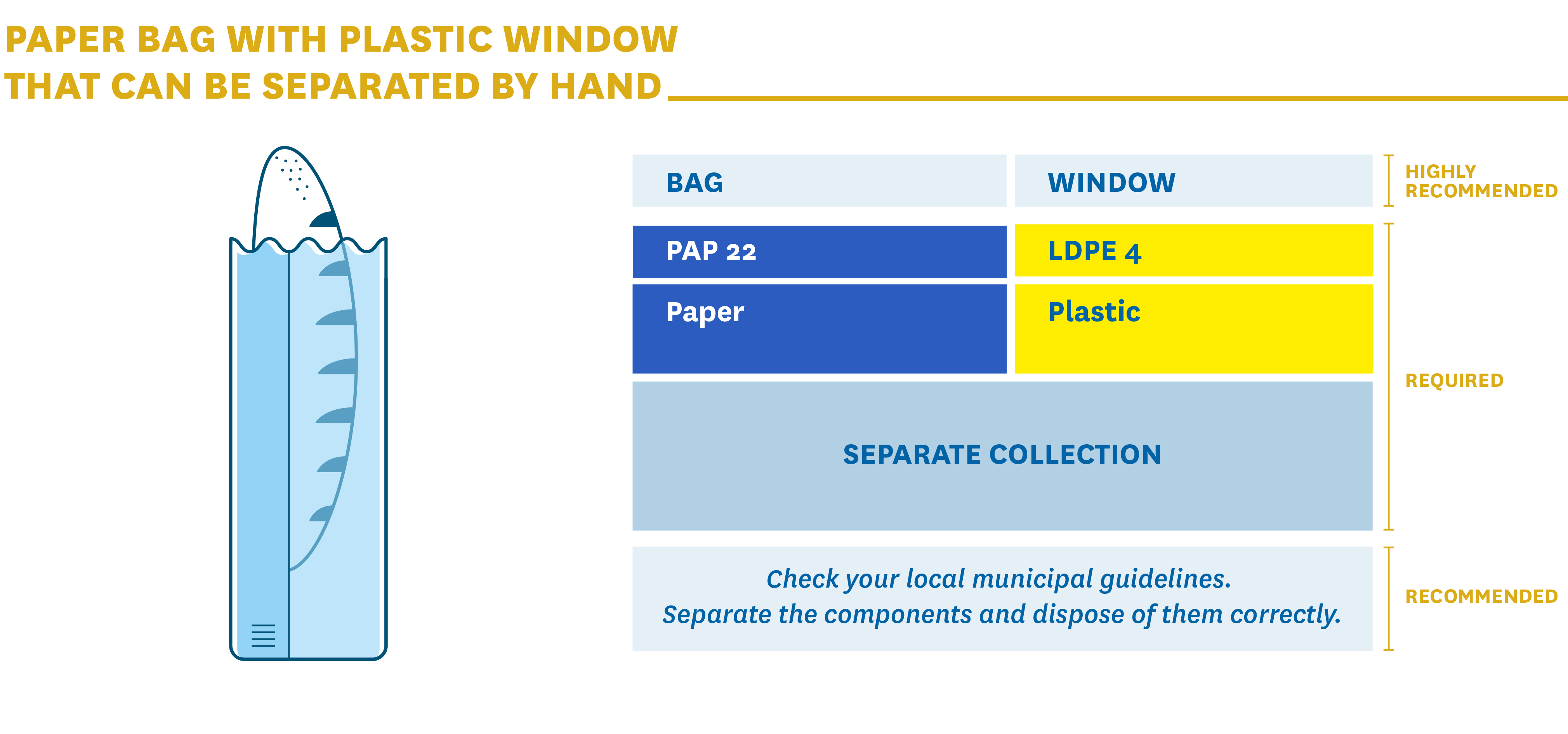
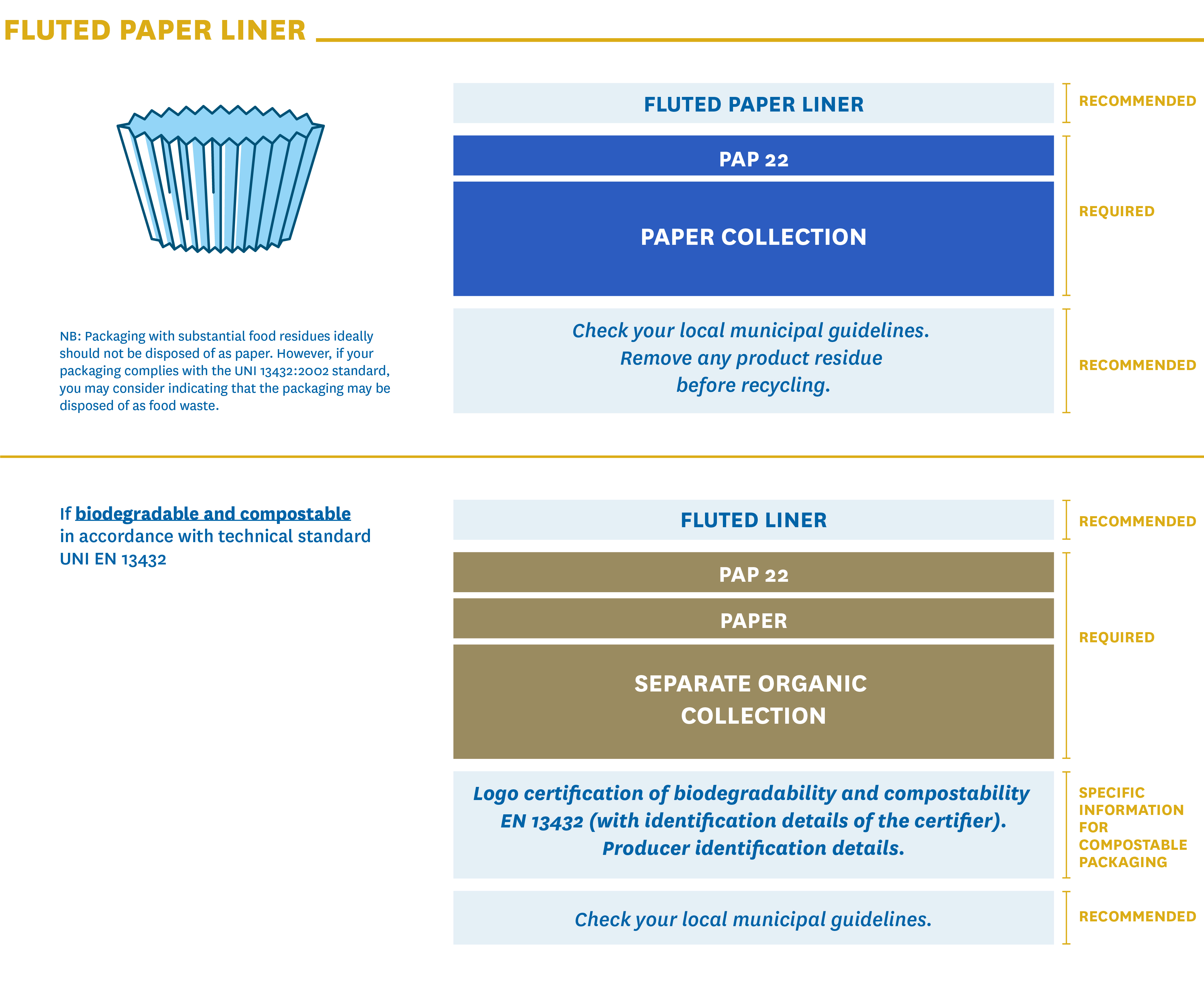
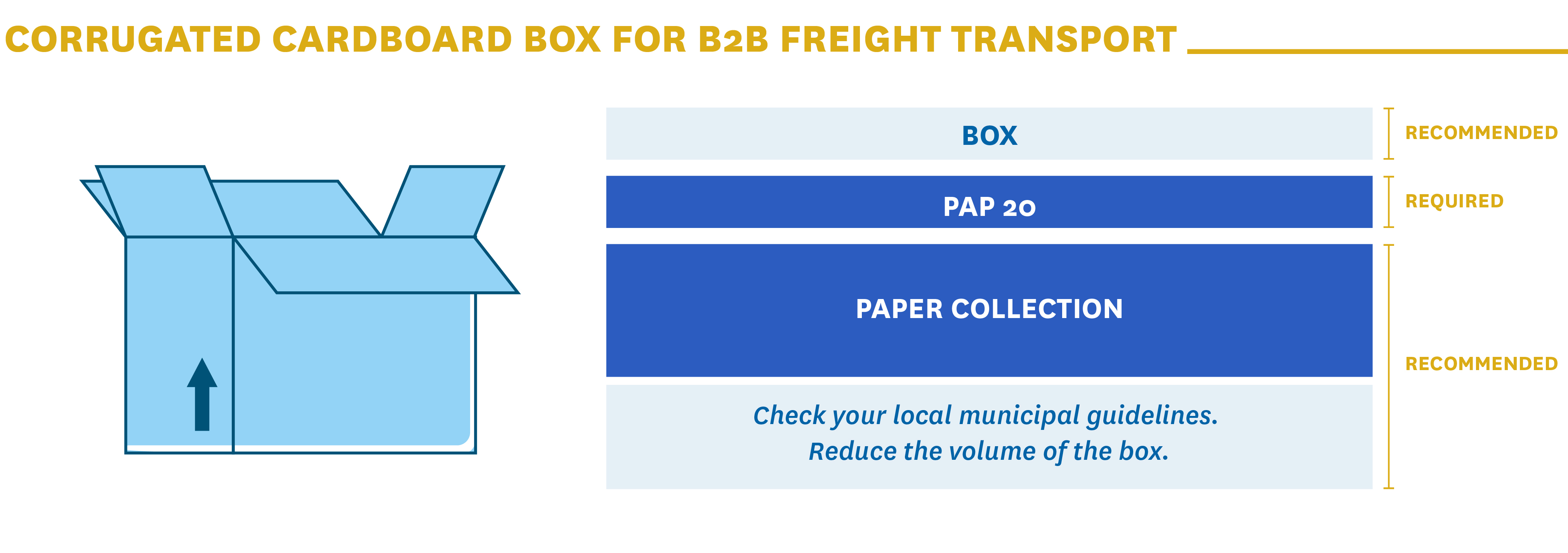
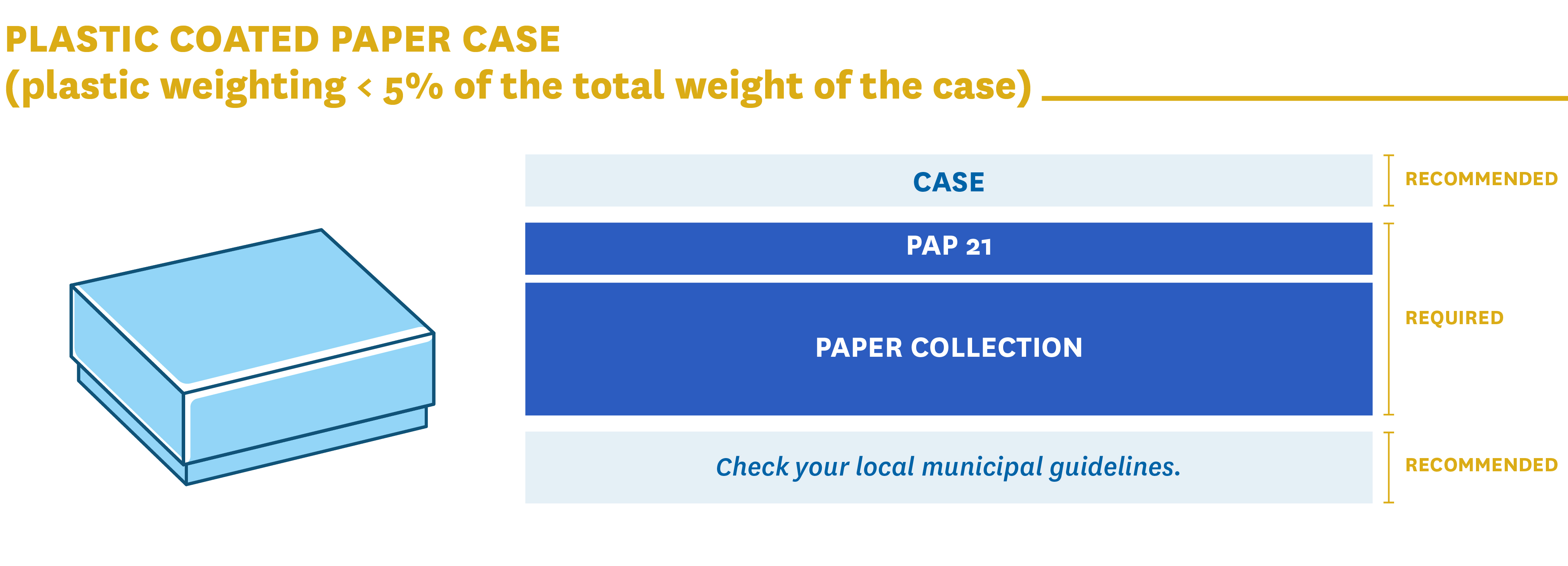
WOODEN PACKAGING
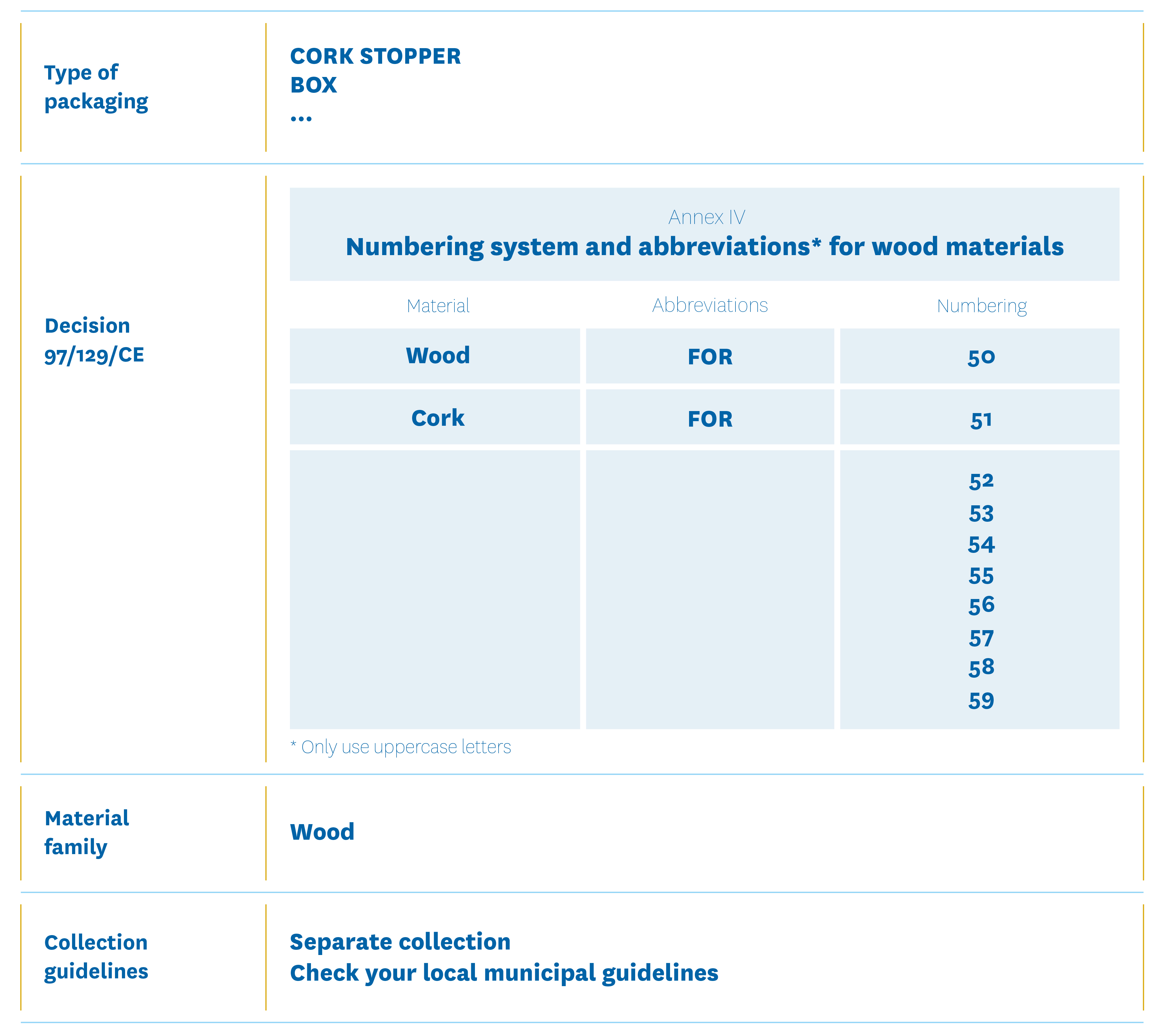
Examples
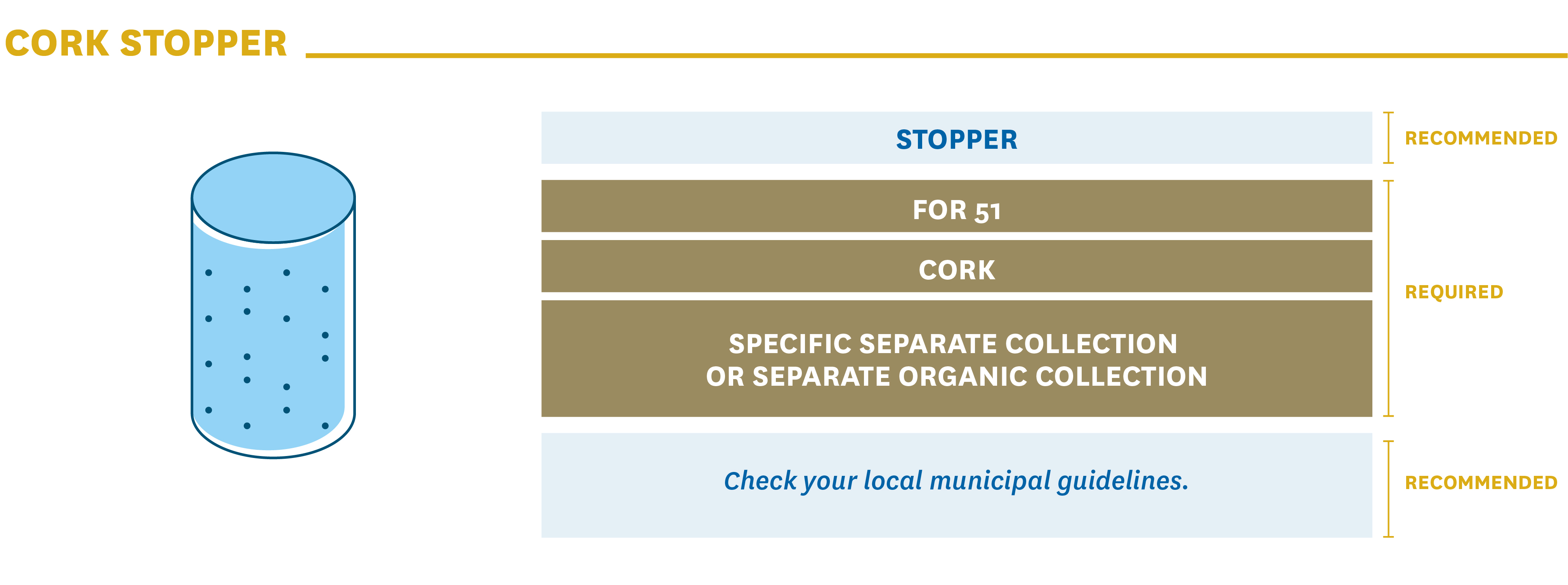
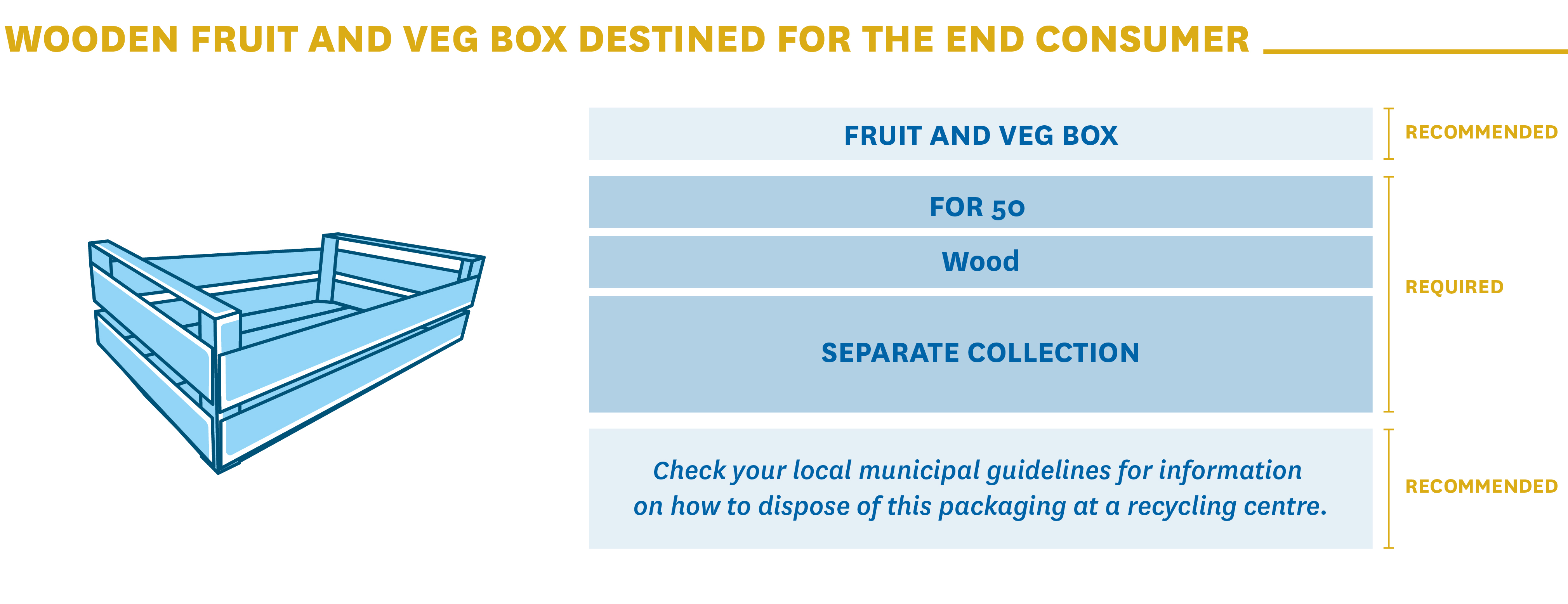
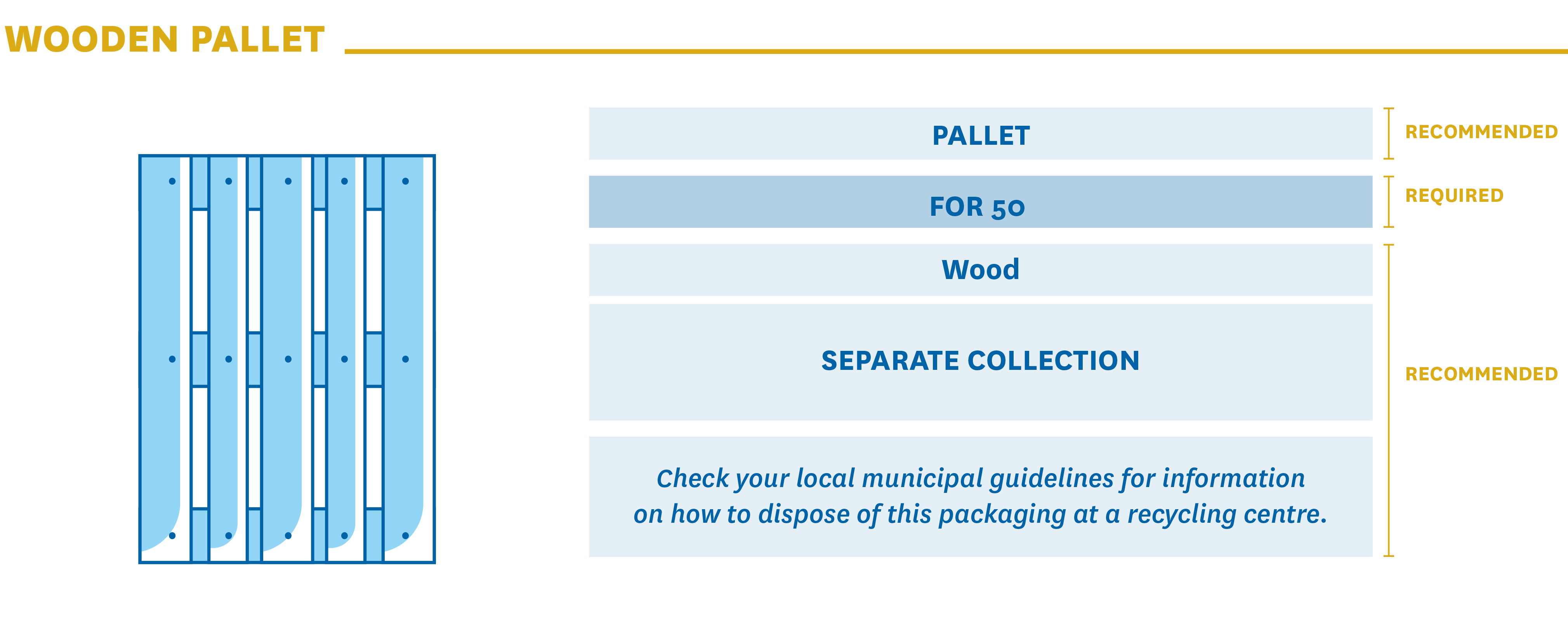
PLASTIC PACKAGING
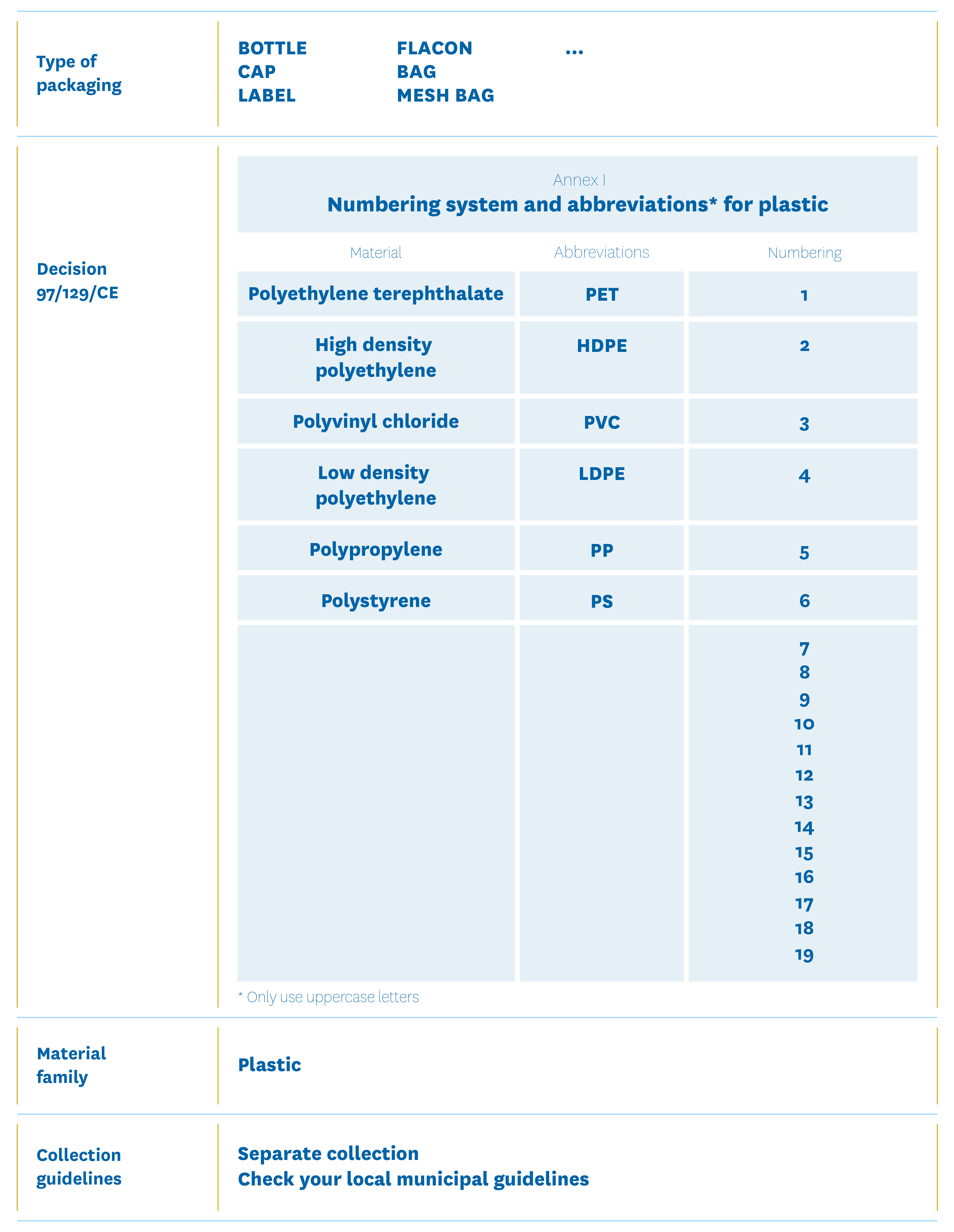
How can the polymer of plastic packaging be identified if it is not provided for in decision 129/97/EC?
Polymers for which no specific coding is provided for in Decision 129/97/EC
Decision 129/97/EC includes alphanumeric codes for the identification of just 6 different polymers. However, numerous polymers are used for the production of plastic packaging and this number is set to grow because this is a sector characterised by fast-evolving technology designed to satisfying many different needs.
So far, polymers other than those mentioned in Decision 129/97/EC have all been identified with the code “7”. In order to provide more accurate information on the composition of plastic packaging, and given the significant number of existing polymers identified by the single code “7”, we suggest accompanying the number “7” with:
- the abbreviation of the polymer’s name as per technical standard UNI EN 1043-1, where available.
For example, polyamide packaging may be identified as: PA 7 - the full name or acronym of the plastic material commonly used in market practice, in cases where no abbreviation exists.
For example, regenerated cellulose packaging may be identified as: Cellophane 7.
For example, packaging in modified PET such as PETG may be identified as: PETG 7 - Packaging made from biodegradable and compostable polymers, under UNI EN 13432, is a separate case as no coding is foreseen for such polymers, even in the UNI technical standards. In such cases, we recommend using the term “compostable plastic”.
For example, polylactic acid packaging may be identified as: Compostable plastic 7.
Multi-layer packaging consisting of different polymers
Packaging consisting structurally of two or more polymers are identified by the code “7” since, also in this case, Decision 129/97/EC does not include specific codes for these materials.
Anyone wishing to provide more accurate information on the composition of multilayer plastic packaging should follow the provisions of the UNI EN 11469 technical standard, according to which the abbreviations of polymers making up the packaging are written between the symbols “>” and “<”, with the sign “+” placed in between.
For example, multilayer packaging made from PET and HDPE may be identified as follows: >PET+HDPE< 7.
Examples
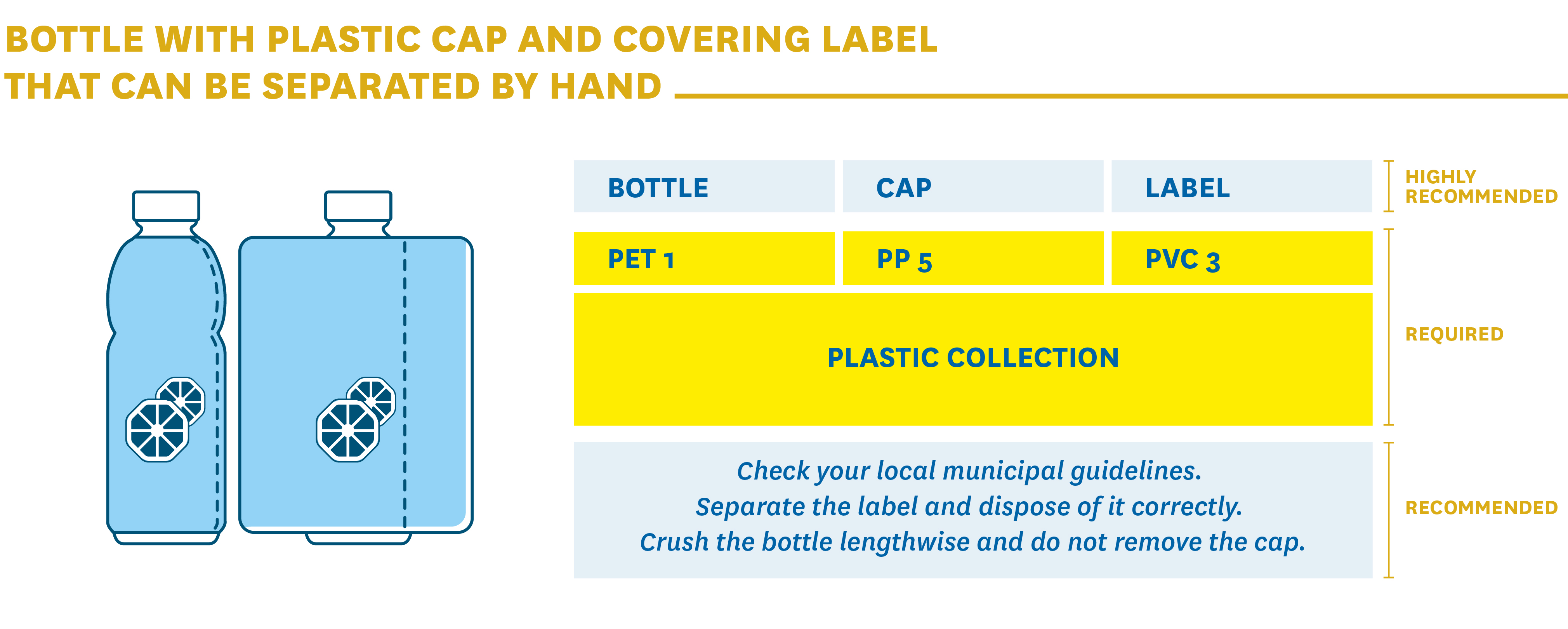
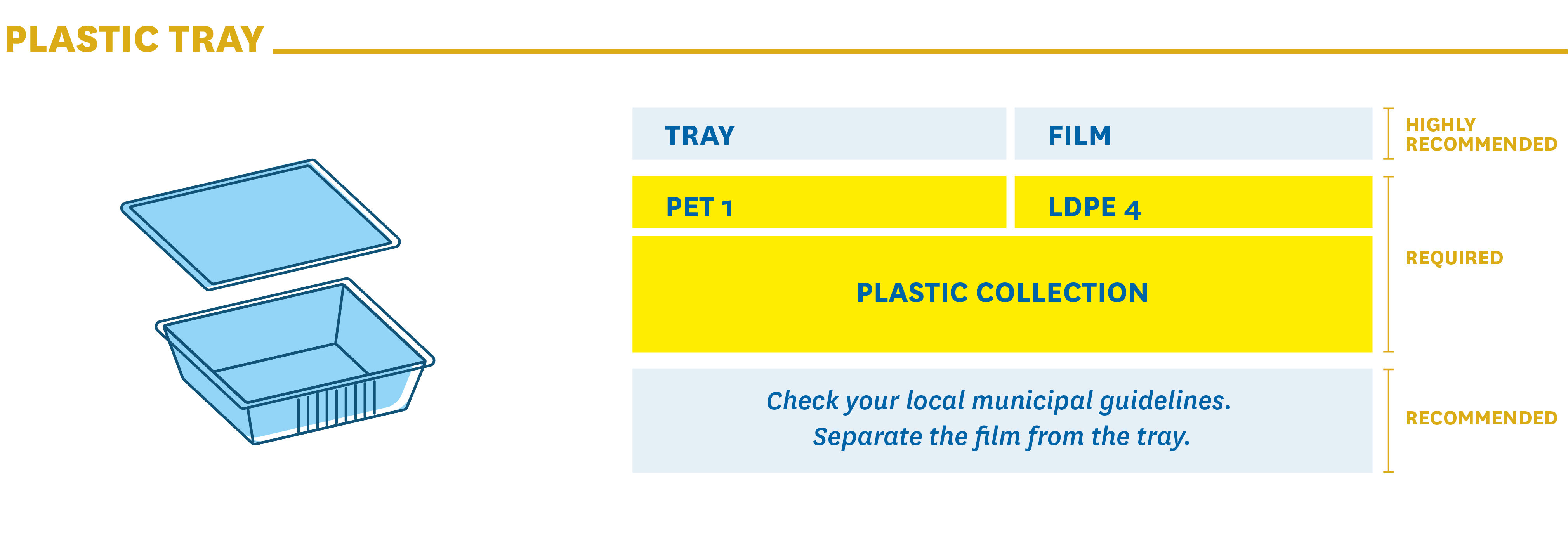
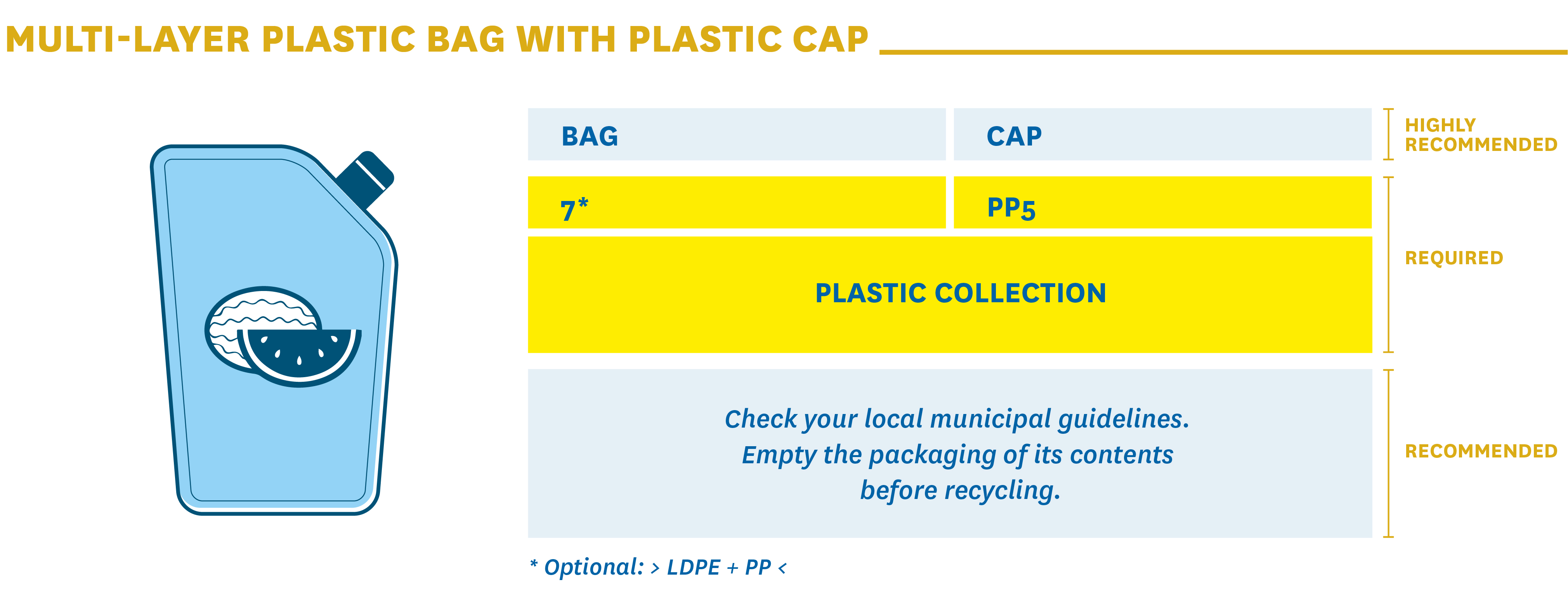
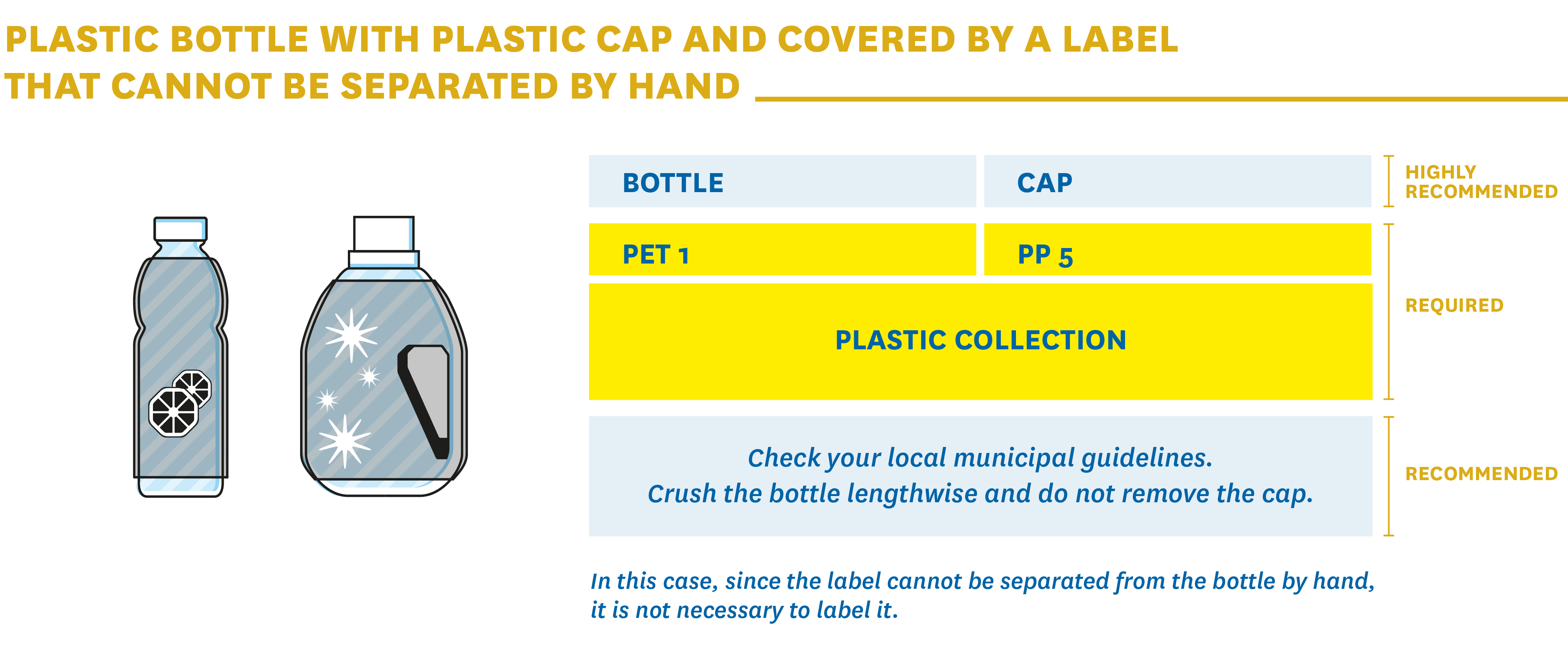
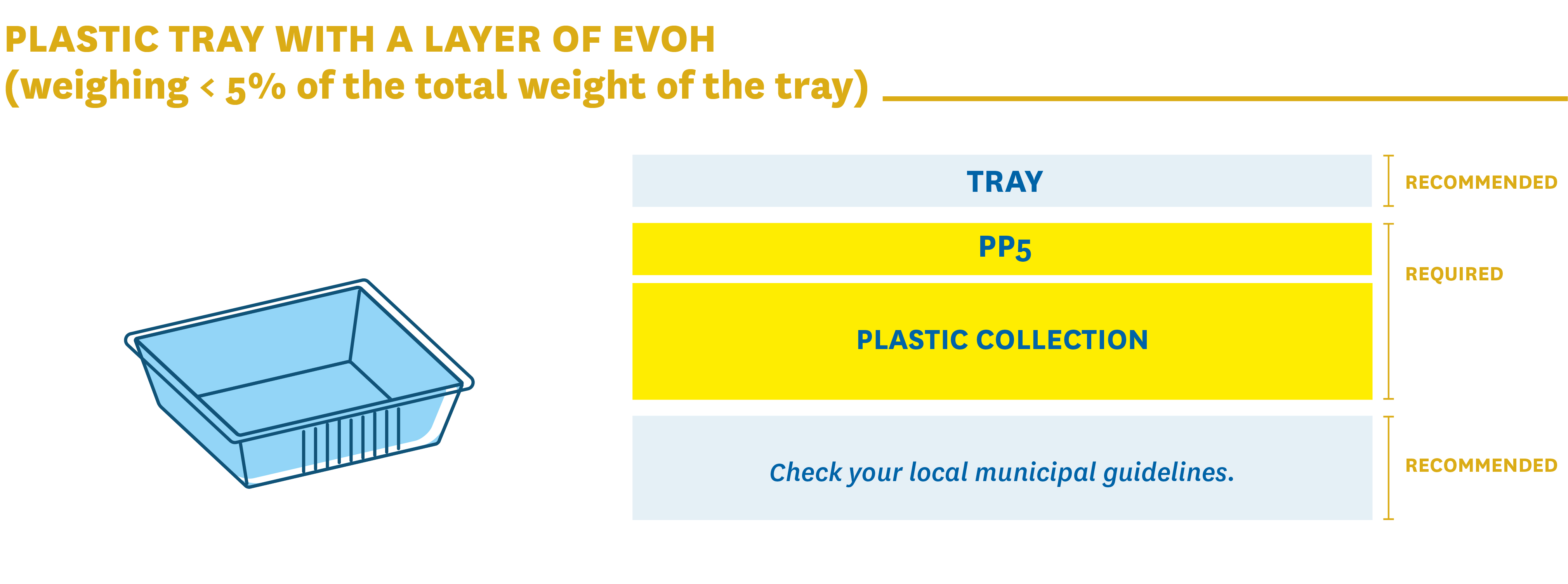
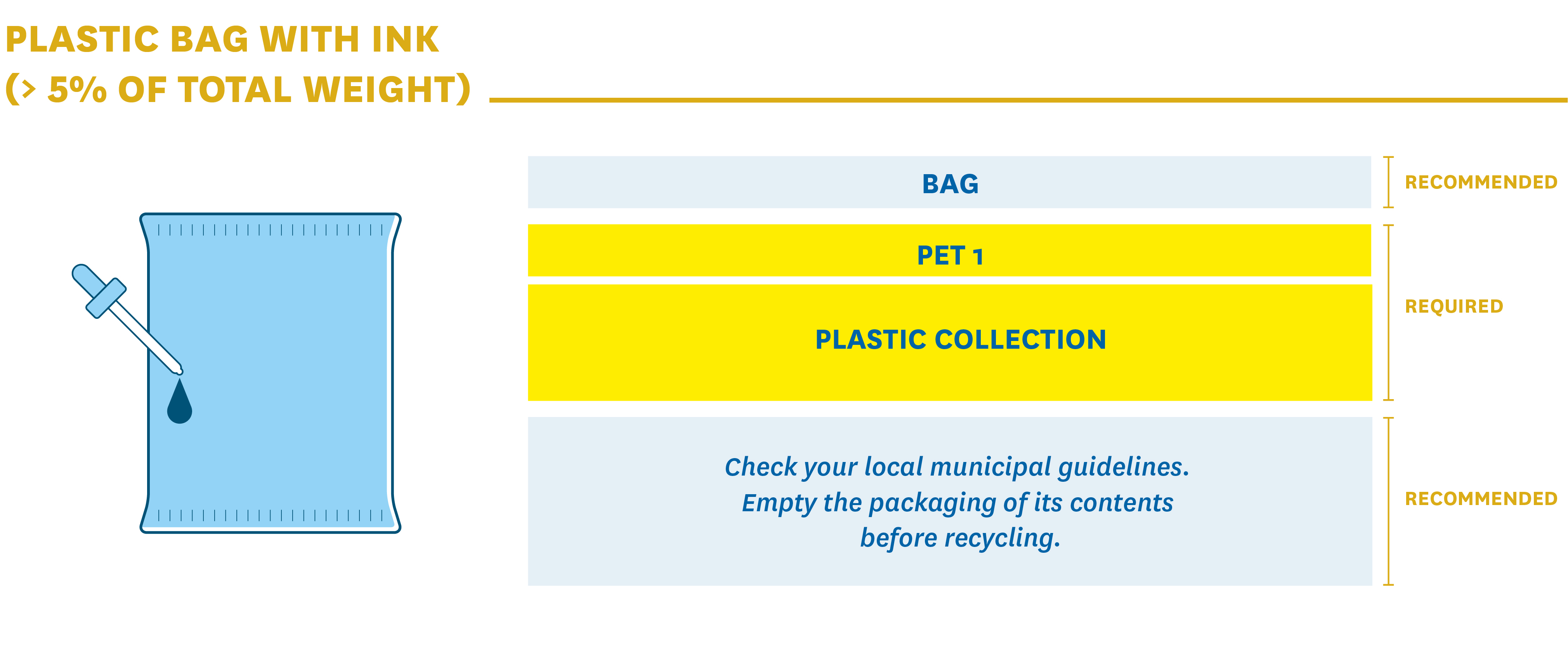
Legislative Decree 116/2020 amended Article 182-ter of Legislative Decree 152/2006 on organic waste, establishing that waste, including packaging waste with similar biodegradability and compostability properties to organic waste, must be collected and recycled together with the latter if:
- it is certified by accredited bodies as conforming to the European standard EN 13432 for packaging recoverable by composting or biodegradation;
- it is appropriately labelled and includes, in addition to the mention of compliance with the above European standards, identification of the producer and the certifier, well as appropriate instructions for consumers to deliver such waste to the circuit for the separate collection and recycling of organic waste;
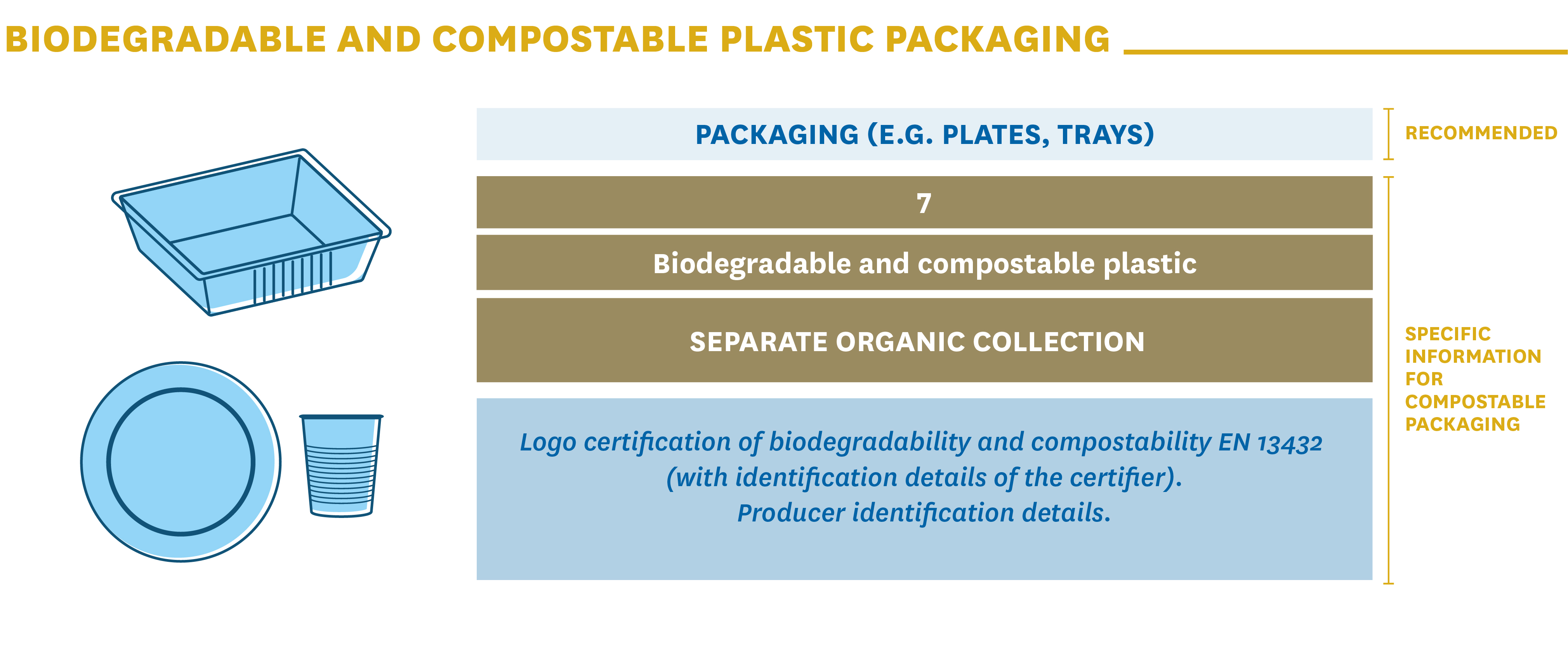
Environmental labelling of plastic shopping bags
In 2017 the law (Italian legislative decree 152/2006, Article 219, paragraph 3-bis) introduced specific requirements for the marketing and labelling of biodegradable and compostable shopping bags for carrying goods, for ultra-light biodegradable and compostable plastic bags for hygienic and/or bulk food purposes (e.g. fruit and vegetable bags), which include also the labelling requirements set out in decree 116, both in relation to the amendments made to Article 219, paragraph 5 on environmental labelling of packaging and what is provided for in the amendments to Article 182-ter of Italian legislative decree 152/2006 on organic waste.
In fact, plastic bags with the following requisites may be sold:
- Reusable plastic bags with specific characteristics in terms of thickness and recycled material content, depending on the goods sold, and may not be distributed free of charge.
- Biodegradable and compostable plastic bags certified to EN 13432, for transporting goods.
- Plastic bags in ultra-light material certified as biodegradable and compostable and with minimal renewable raw material content (from 1 January 2021 not below 60 per cent). Manufacturers of biodegradable and compostable plastic bags in ultra-light material must also certify the percentage of renewable raw material content in their products according to standard EN 16640:2017.
All plastic bags referred to above may not be supplied/distributed free of charge with the aim of avoiding waste (“pricing”) and must state the identification information manufacturer (Article 219, paragraph 3 of Law no. 152/2006).
Labelling requirements already stipulated for these packaging materials with regard to disclosing their environmental characteristics must be provided with these under the new decree, both with reference to the amendment of paragraph 5 of Article 219, on environmental labelling of packaging materials, and – with regard to compostable shopping bags – the amendments made to Article 182-ter of Italian legislative decree 152/2006 on organic waste.
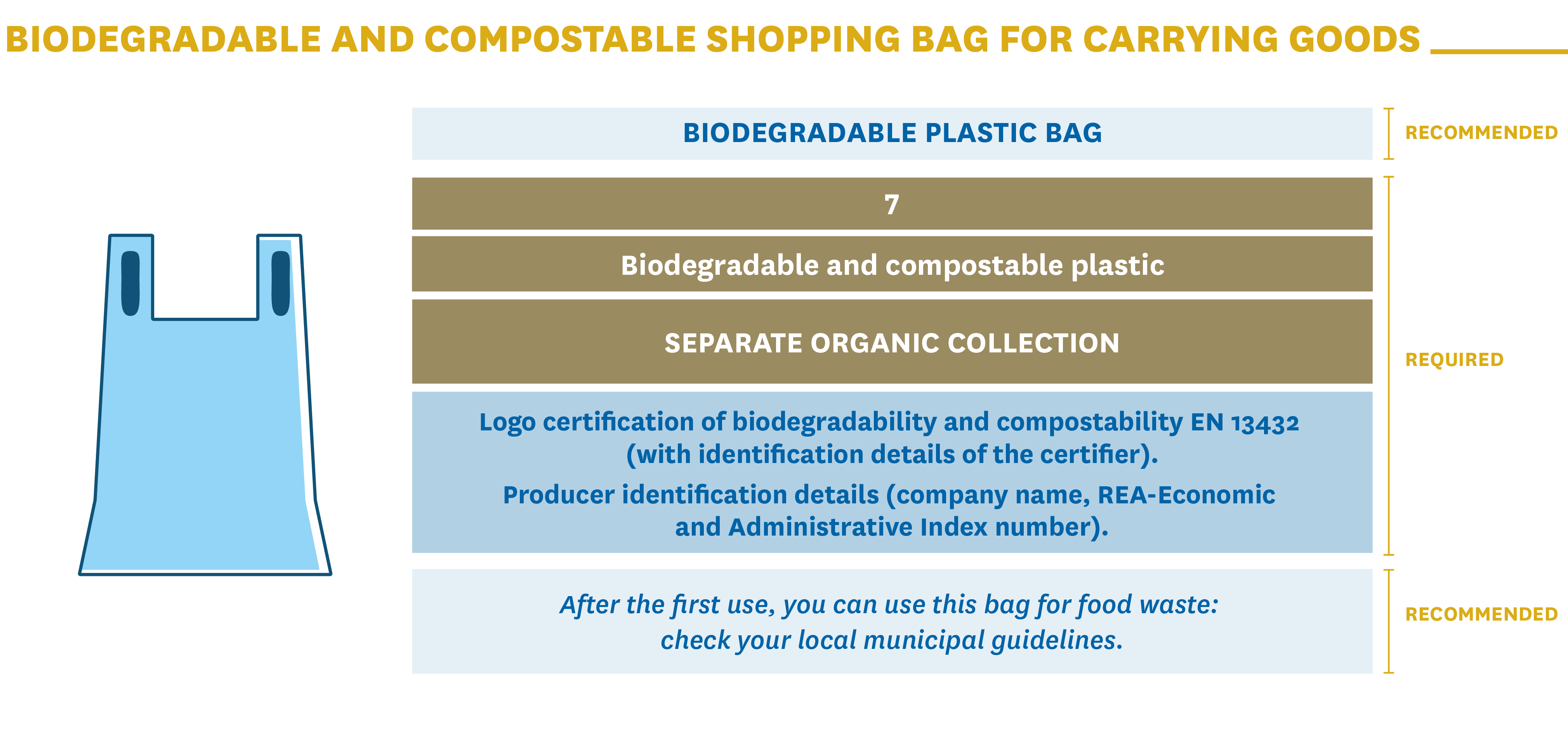
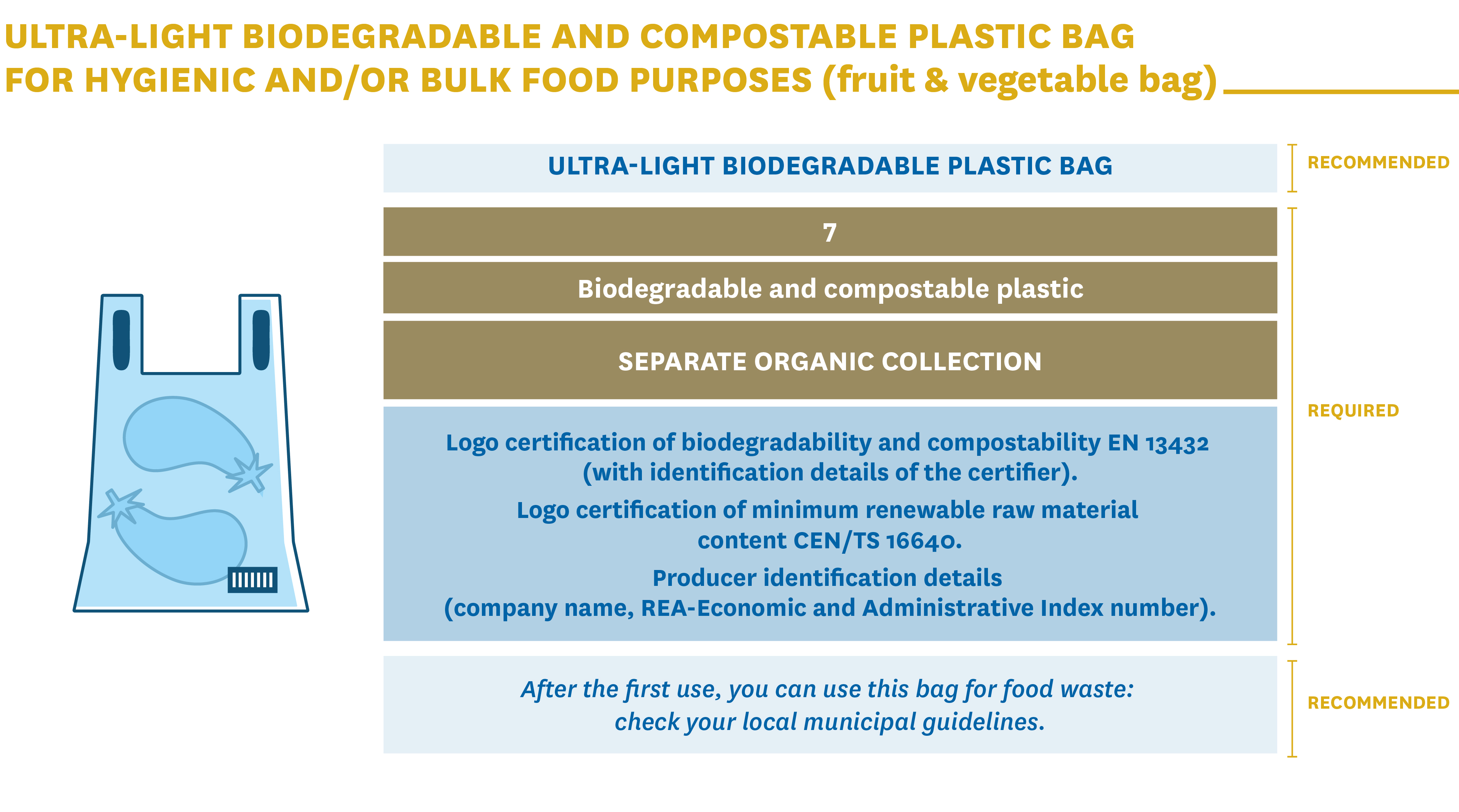
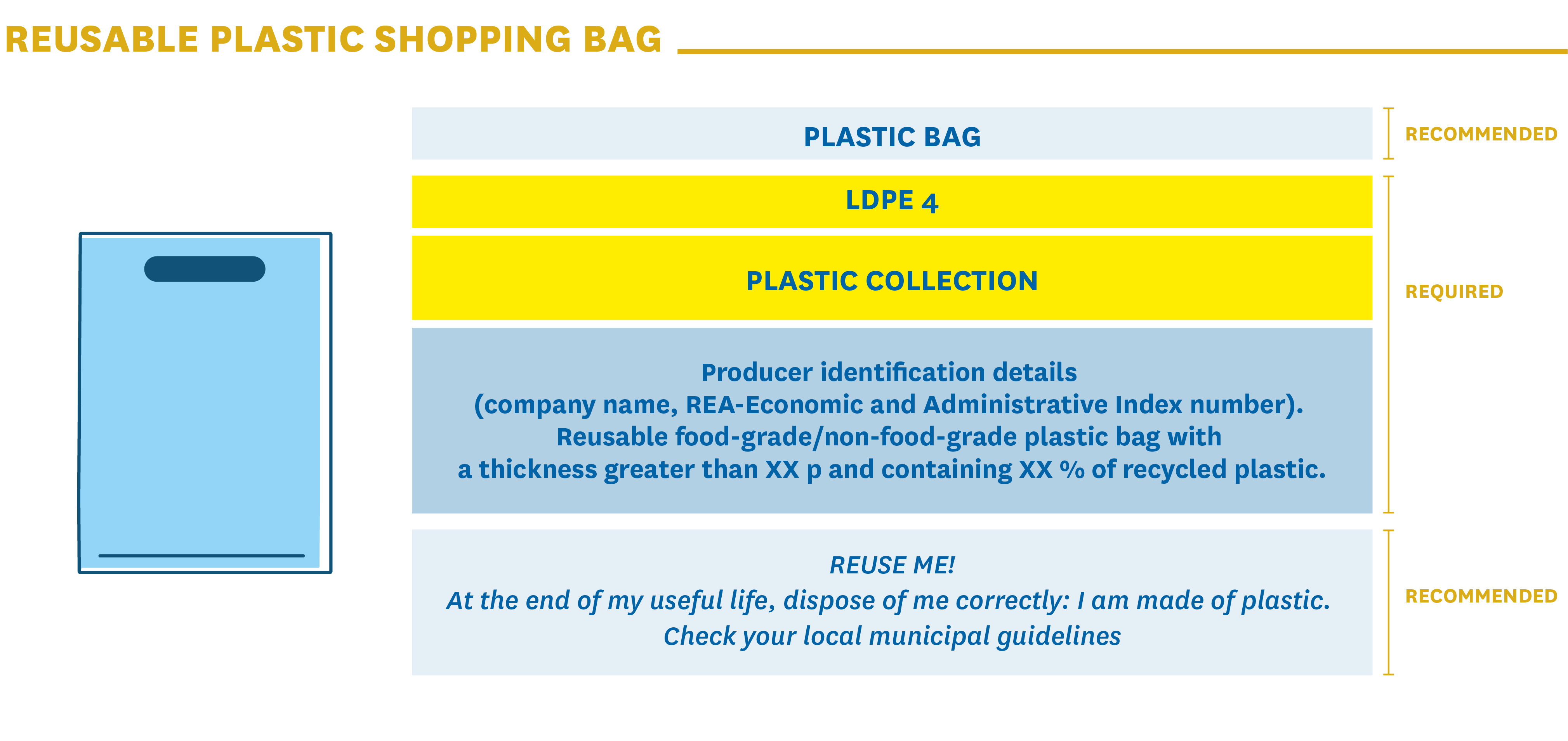
Mandatory labelling for beverage cups and glasses made partly or entirely of plastic
Directive (EU) 2019/904 “on the reduction of the impact of certain plastic products on the environment” established general marking requirements for certain single-use plastic products in order to inform and raise consumer awareness of the importance of their proper management.
Commission Implementing Regulation (EU) 2020/2151 of 17 December 2020 defined the harmonised marking specifications for such products.
Among these products, beverage cups and glasses made partly or entirely of plastic are also subject to specific marking requirements.
The following table summarises the main provisions of the Regulation
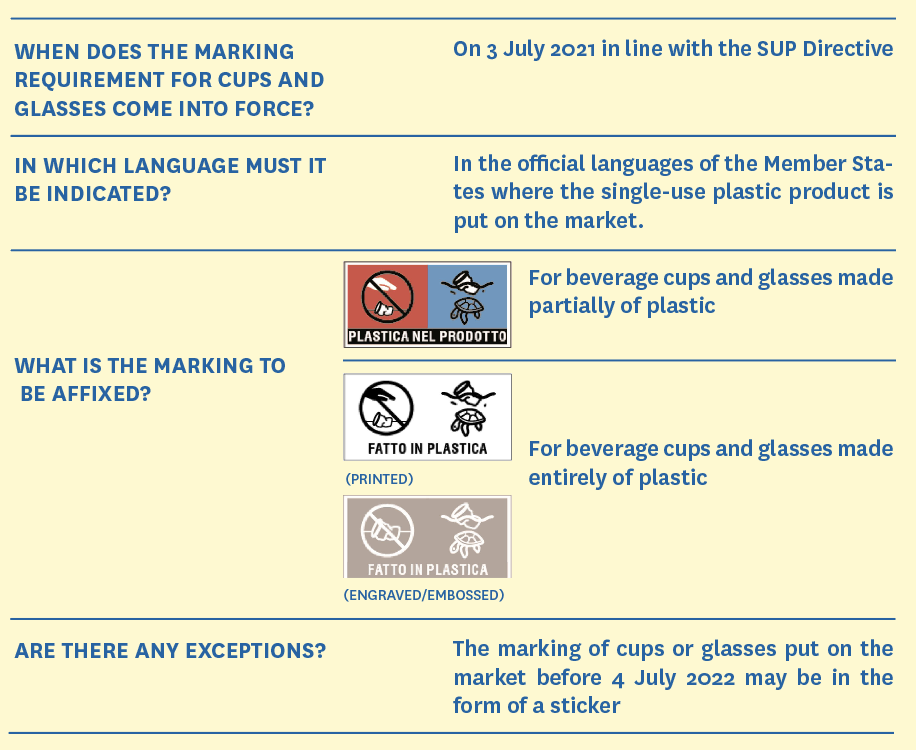
Die Verordnung beschreibt sehr genau die Merkmale der Kennzeichnung von Getränkebechern, die teilweise oder gänzlich aus Kunststoff bestehen, und zwar in Bezug auf:
- die Position der Kennzeichnung, die je nach Art des Getränkebechers (herkömmlicher Getränkebecher oder Getränkebecher in der Form von Wein- und Sektgläsern) unterschiedlich ist;
- die Größe der Kennzeichnung, die je nach Volumen des Getränkebechers (bis zu und über 500 ml) unterschiedlich ist;
- die grafische Gestaltung der Kennzeichnung, die je nach Volumen des Getränkebechers (bis zu und über 500 ml) unterschiedlich ist und gedruckt oder eine eingravierte/geprägte Aufschrift sein kann.
GLASS PACKAGING
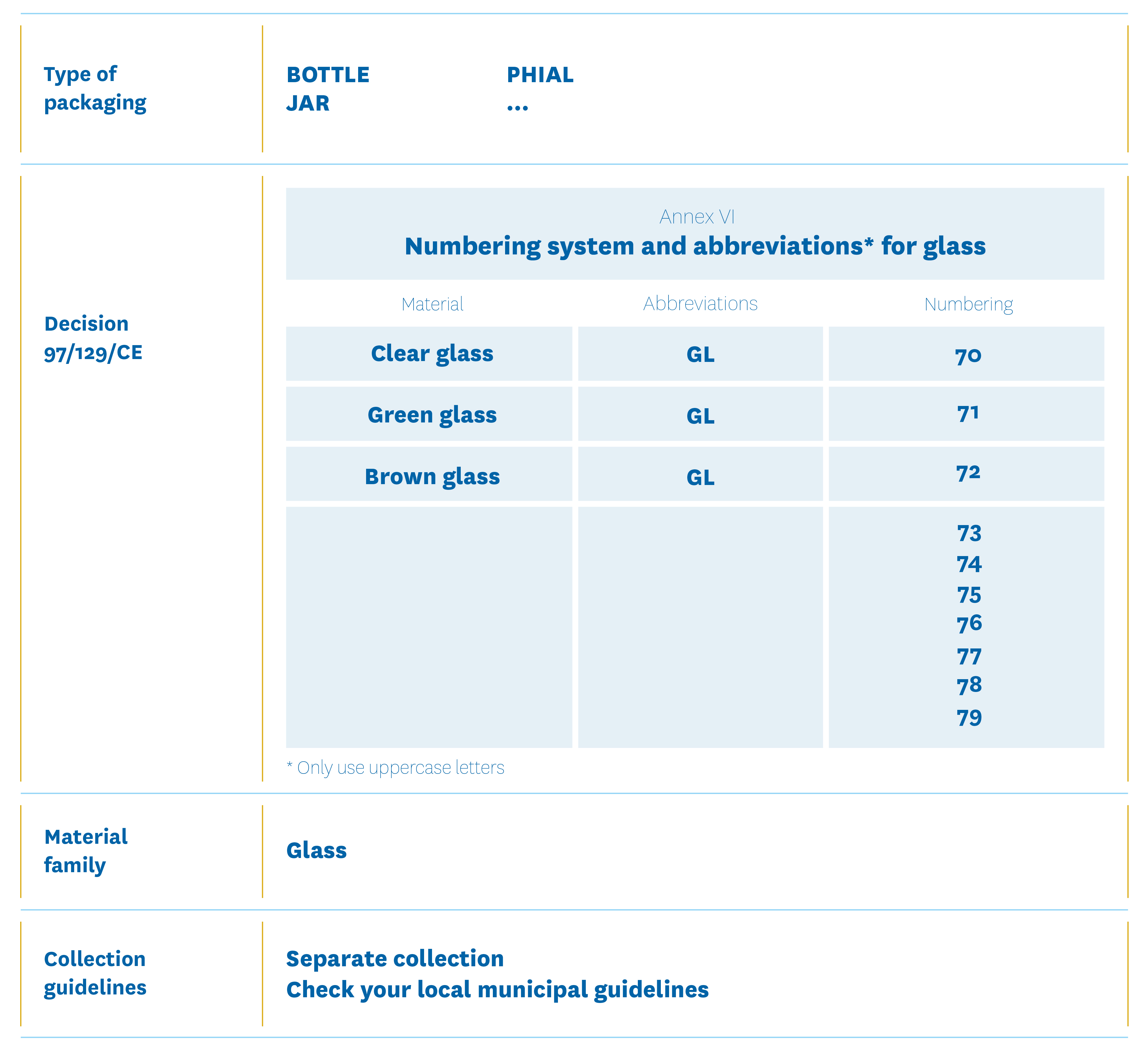
What if the colour of glass packaging is neither clear, green nor brown?
Annex VI, which sets out identification codes for glass packaging, provides for the identification of clear, green and brown glass.
For glass packaging in a colour other than those referred to in Annex VI, we recommend using GL 73, i.e. the first number to which no specific colour is associated and therefore “available” to be adopted in such cases.
Examples
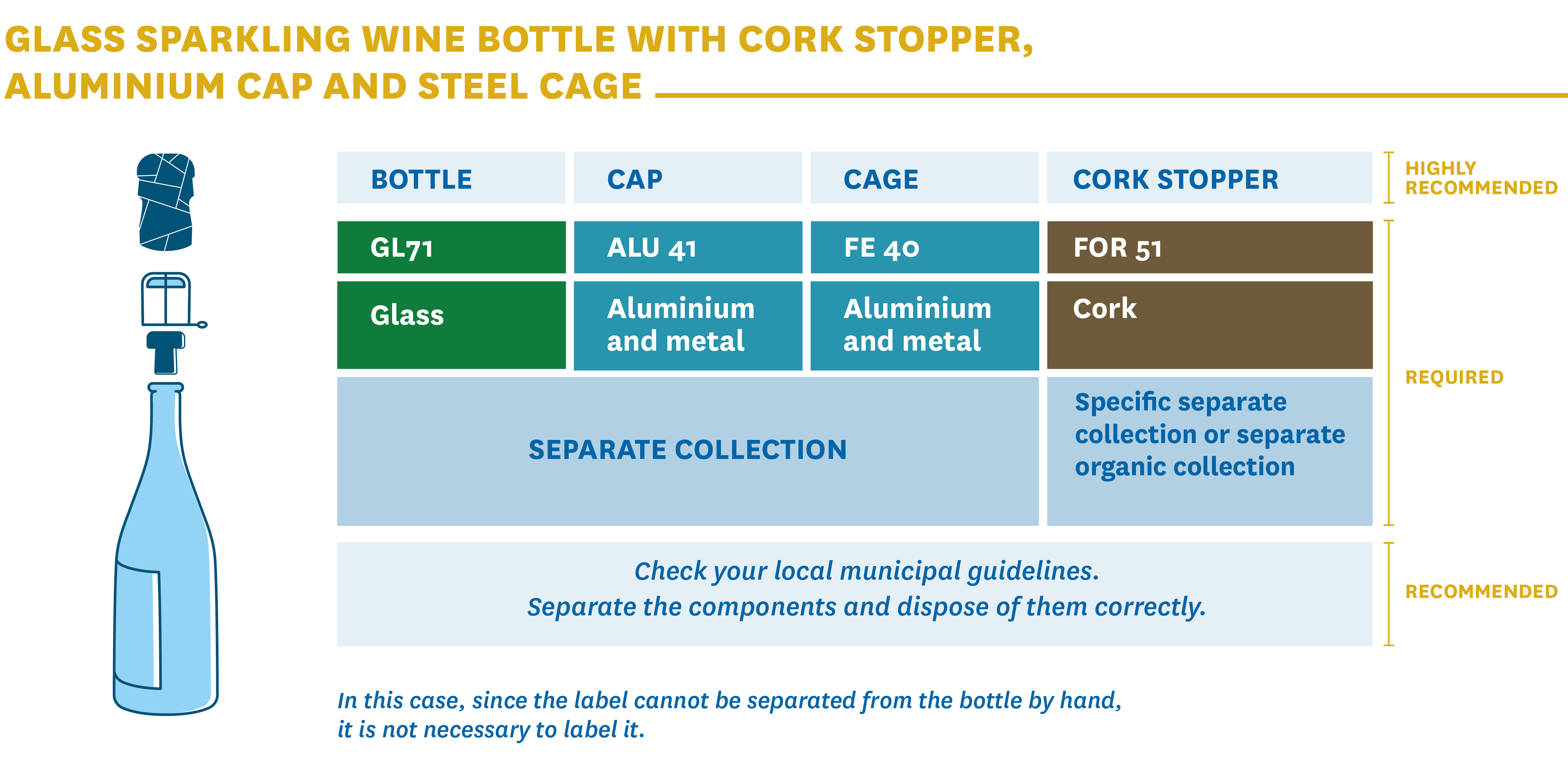
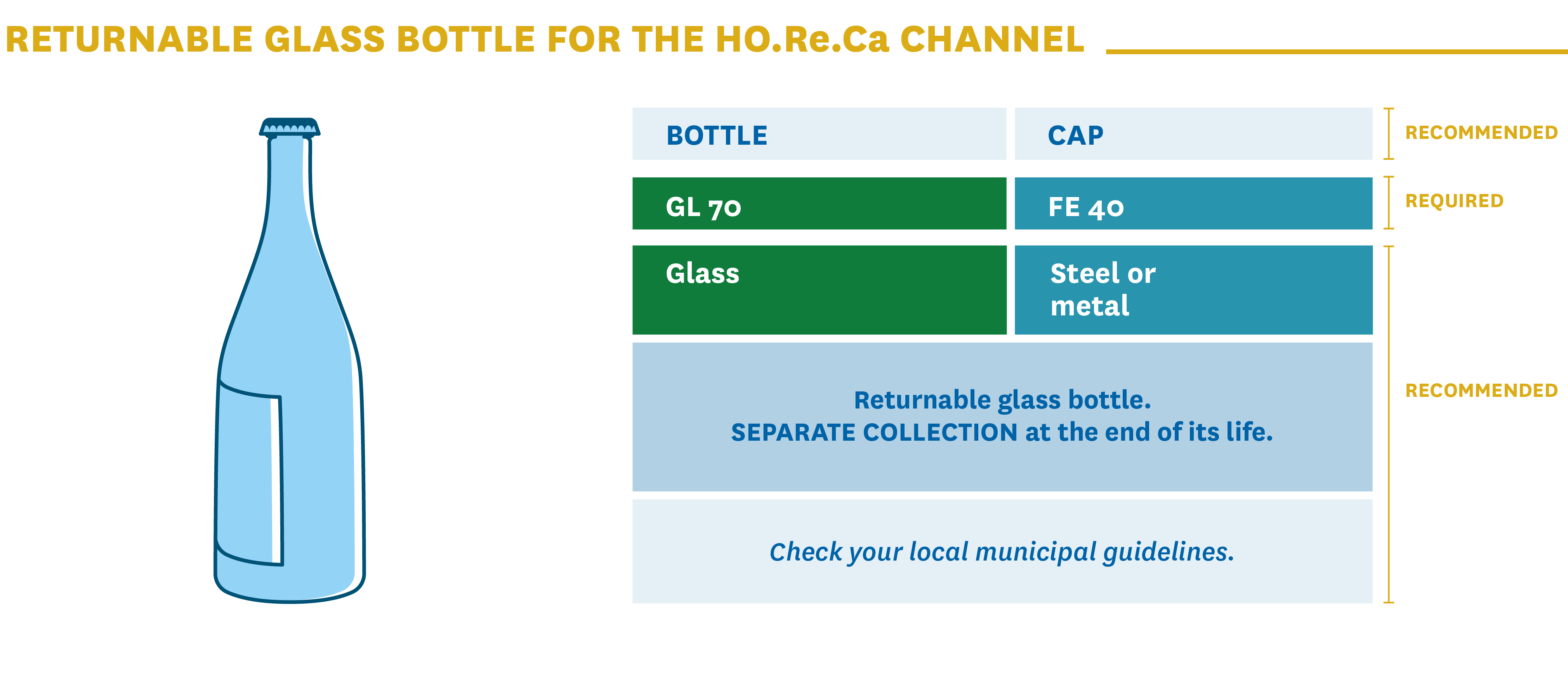
POLYLAMINATE OR COMPOSITE PACKAGING
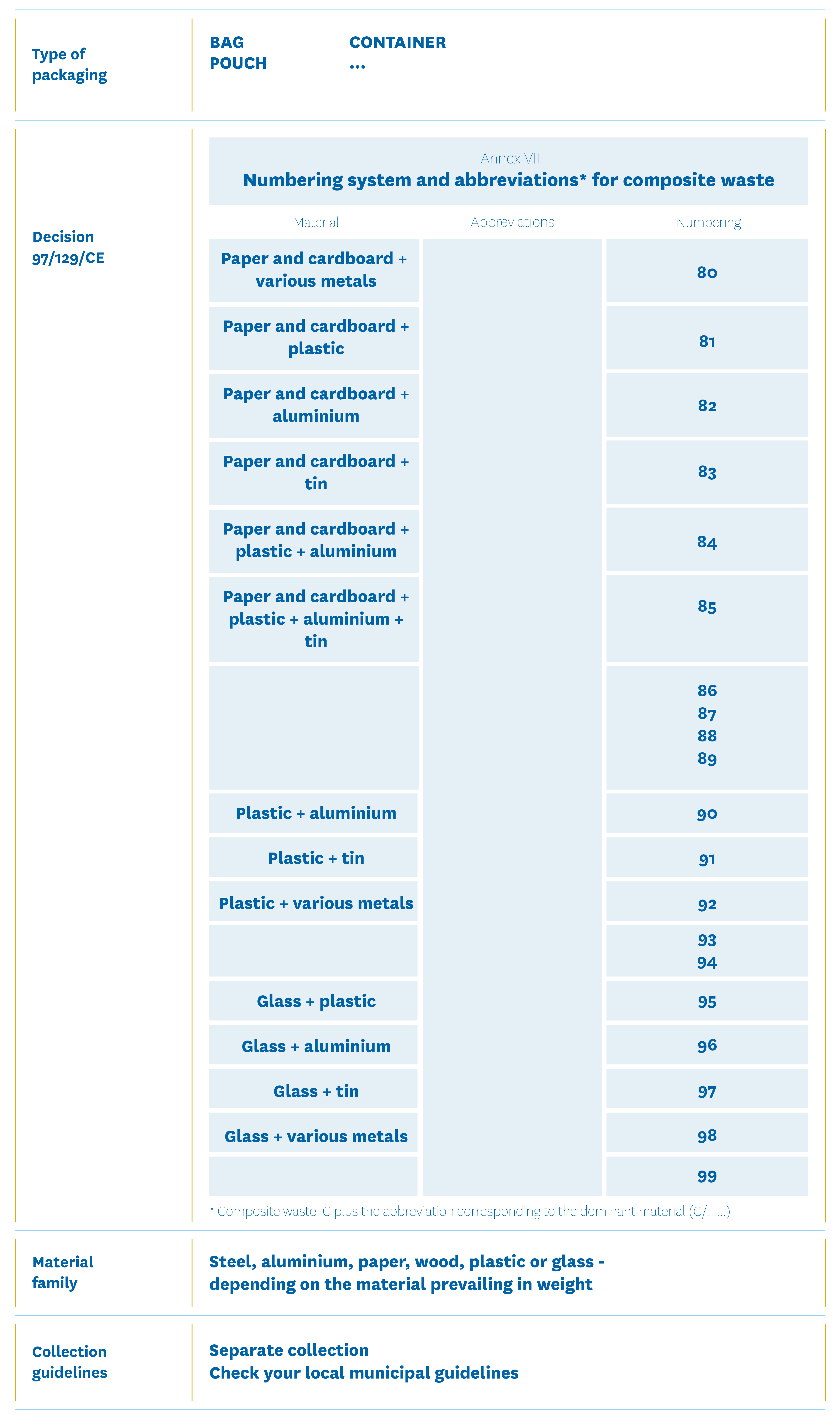
Examples
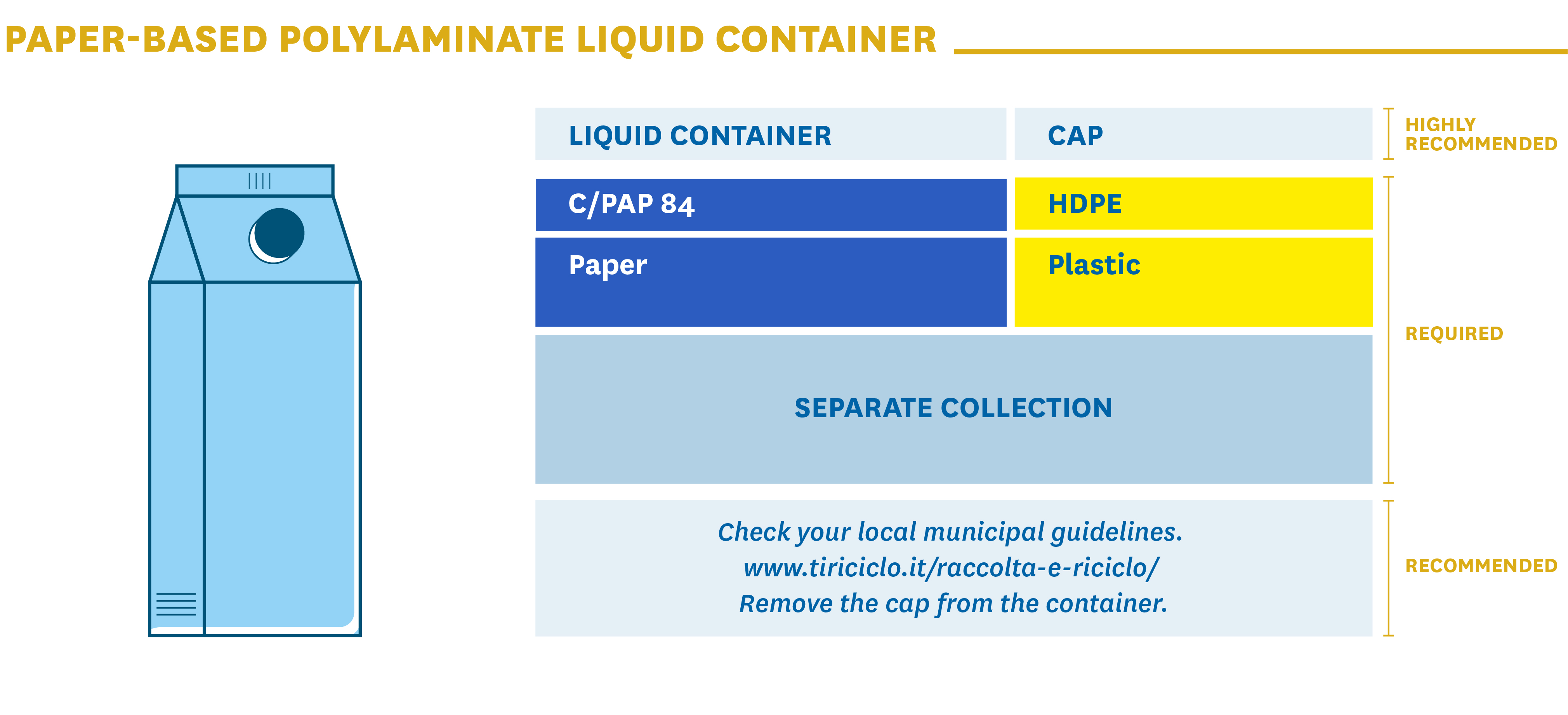
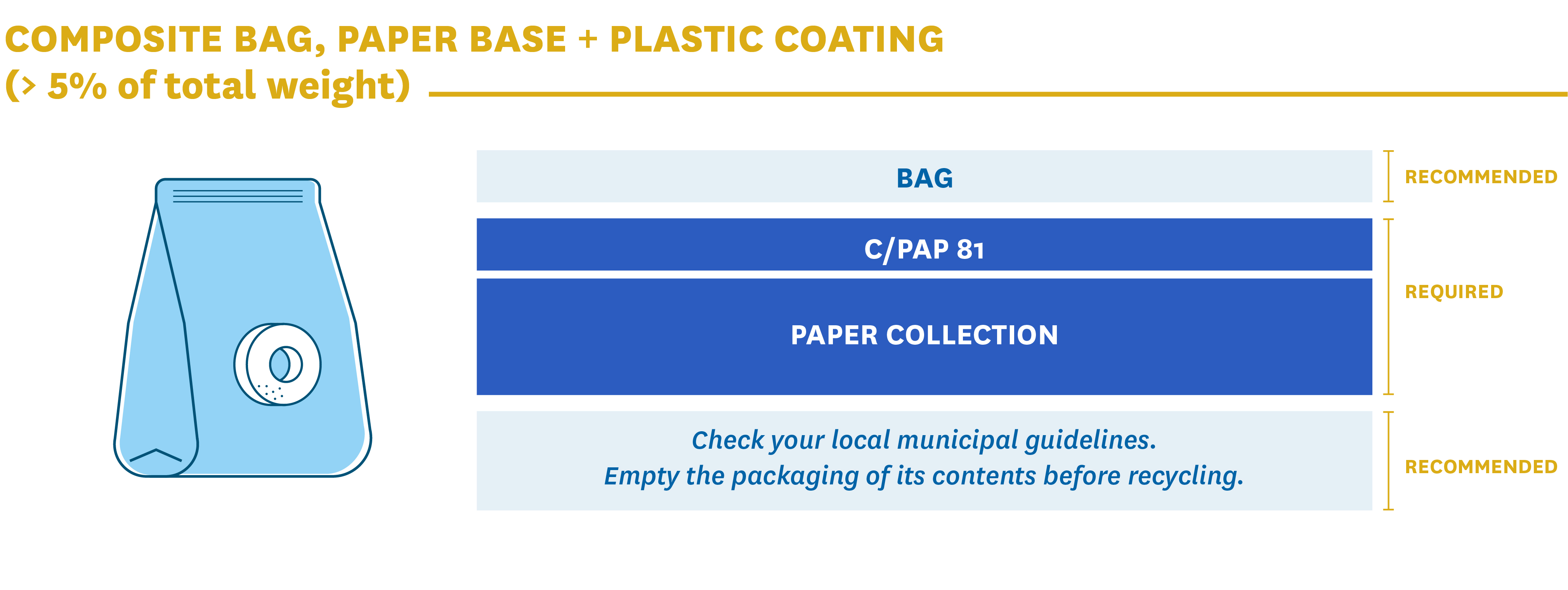
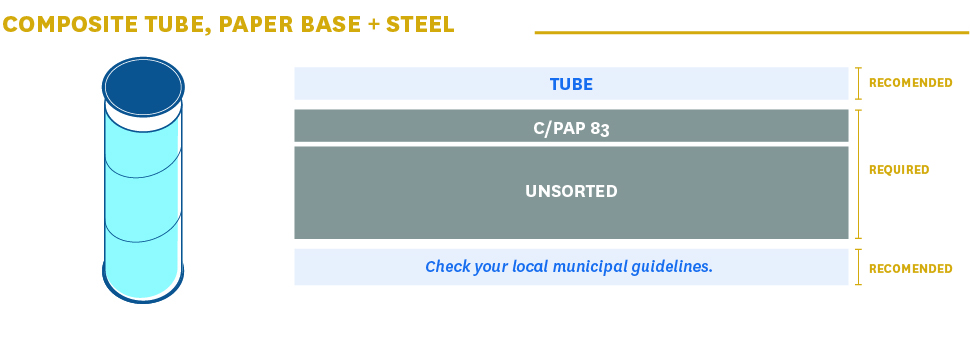
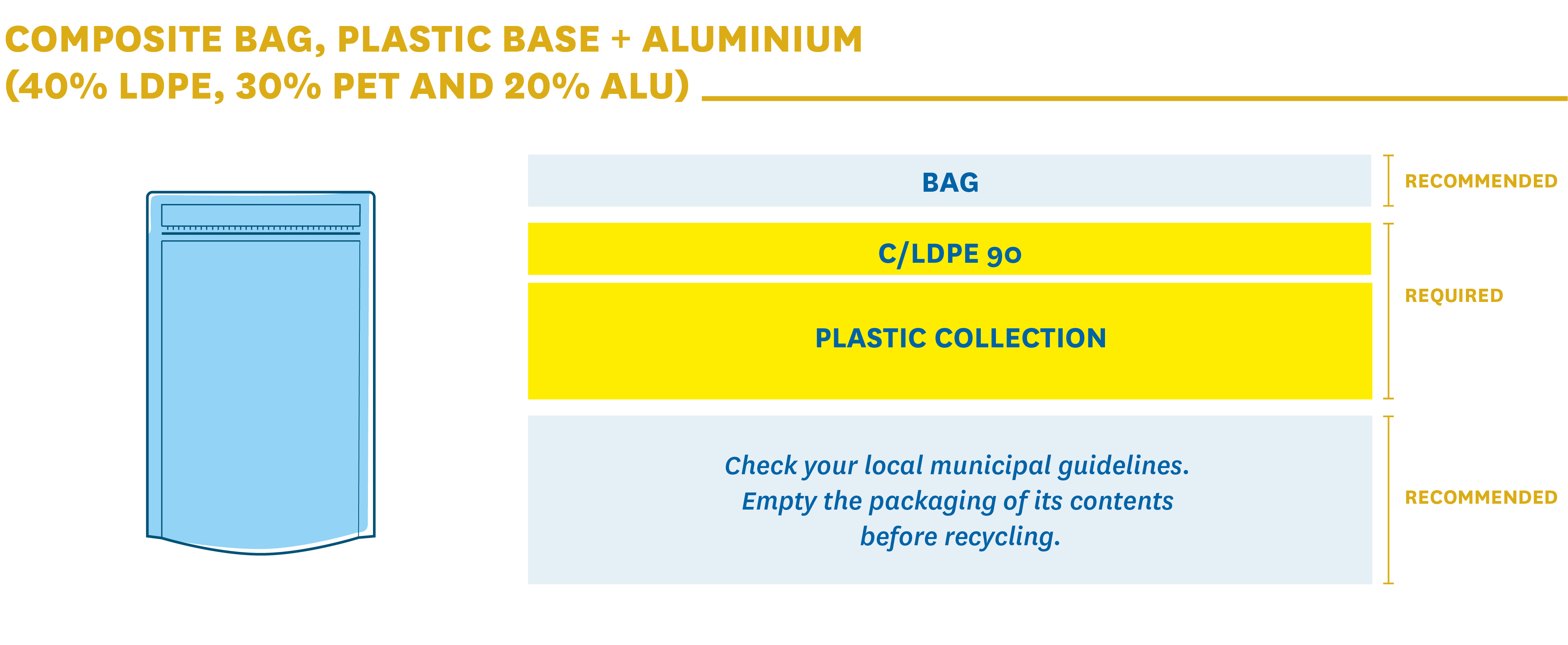
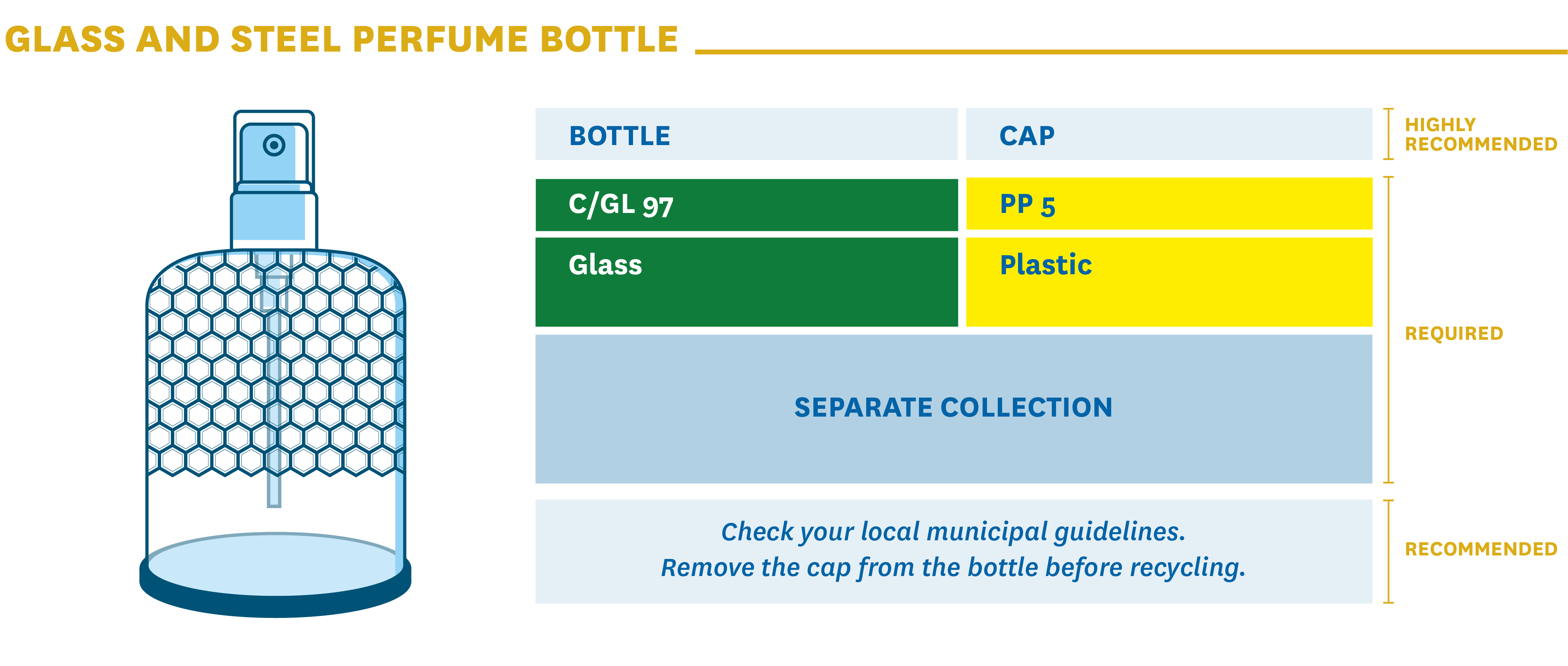
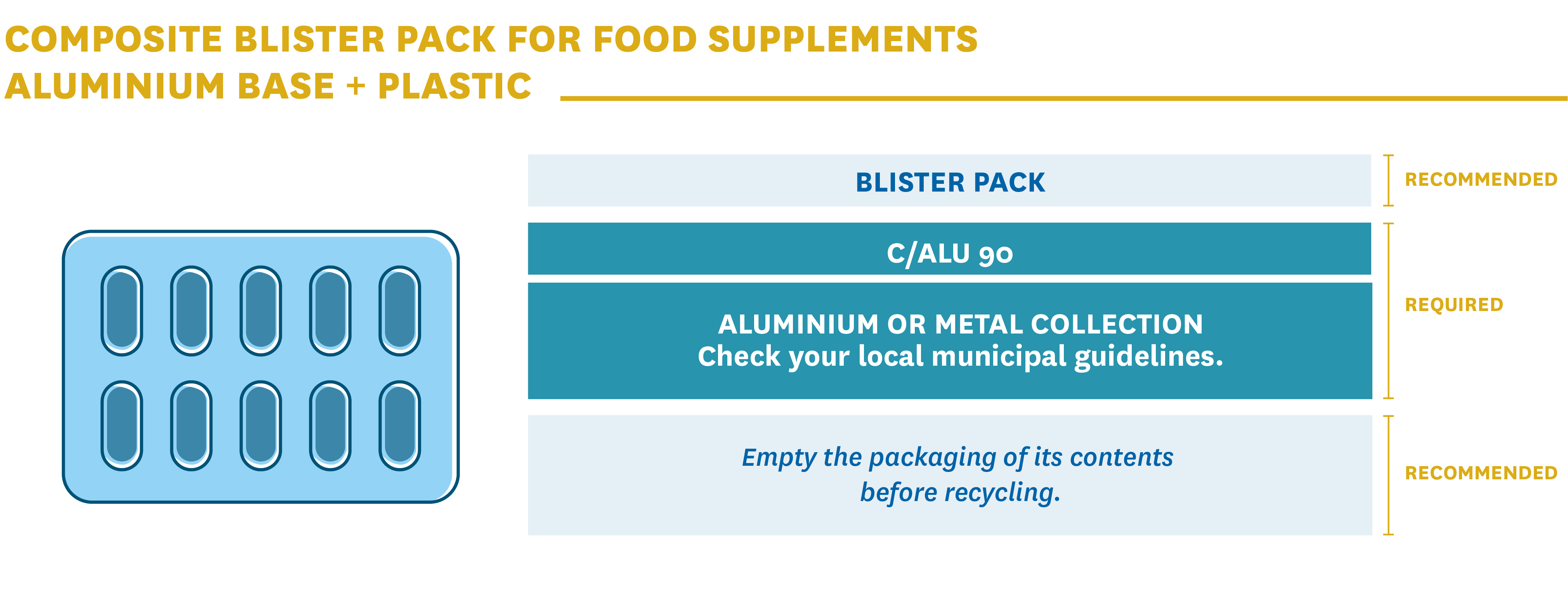
TEXTILE PACKAGING
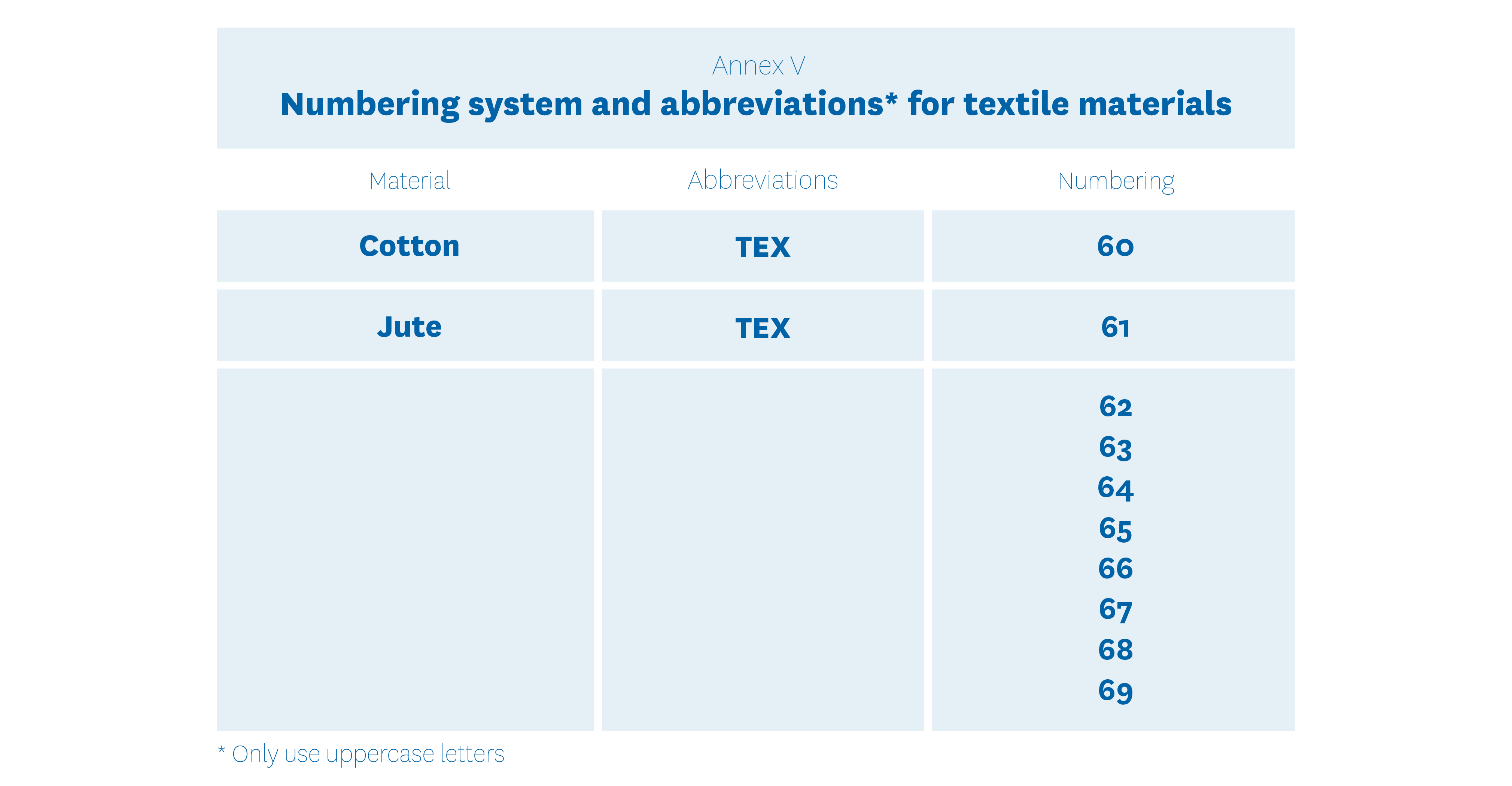
For textile packaging, reference is made to Annex V to Decision 129/97/EC.
For textile materials not provided for in this table, i.e. materials other than “cotton” and “jute”, we recommend using TEX 62, i.e. the first available number to which no specific material is associated.
Such packaging does not fall within the scope of domestic waste collection but of specific waste collections. Therefore, in addition to the code, it is good practice to indicate the full material “fabric” and to invite the consumer to check their local municipal guidelines.
FAQS
INTERPRETATION GUIDE
Below are our answers to the questions most frequently asked by companies regarding environmental labelling. In them, we provide our shared interpretations of various aspects of real interest to industry players seeking answers. The topics covered in these FAQs concern organisational aspects (such as the scope of the new requirement, responsibilities and time frames) as well as more practical ones (such as the methods, contents, and preferable features of environmental labels), and often make use of definitions that help to understand the approach to be adopted.
In separate boxes, we report certain issues - arising from our public consultation - that pose significant problems for many companies. These would deserve specific insights and measures currently not foreseen by the decree.
What is the scope of the environmental labelling requirement?
The environmental labelling requirement relates to packaging, i.e.: “products, consisting of materials of any kind, used to contain certain goods, from raw materials to finished products, to protect them, allow their handling and their delivery from the producer to the consumer or user, ensure their presentation, as well as disposable items used for the same purpose”.
Products other than packaging do not require an environmental label. For example, sausage casings, envelopes and cutlery are not packaging and are therefore not affected by the requirement.
To find out what constitutes packaging and what does not, please refer to the CONAI website.
At present, all the packaging placed on the market in Italy is covered by the new labelling requirement.
The Ministry of Ecological Transition (MITE) clarified in a note issued on 17 May 2021 that packaging intended for third countries (which must comply with the specific regulations of the destination country) is excluded from the labelling obligation. Packaging intended for third countries, in all pre-export logistics, must therefore be accompanied by appropriate documentation certifying its destination, or by transport documents and/or technical data sheets containing composition information.
Should small, multilingual and imported packaging also be labelled?
The legislation does not provide for any exemption for small packaging, and/or that with reduced printed space, or for multilingual or imported packaging.
Nevertheless, for these cases, there are often operational difficulties in providing for the physical affixing of environmental labelling on the packaging, particularly for small packaging, for which, if in a multipack, the way forward might be to affix the environmental labelling on the presentation packaging, but when sold separately, there may be physical limitations for affixing the environmental labelling, and/or difficulties regarding the visibility and legibility of the information.
In this regard, in a note dated 17 May 2021, the Ministry of Ecological Transition clarified that where actual physical and/or technological limitations to physically affixing environmental labelling to packaging are identified, such information may be conveyed through digital channels or, where this route is also not feasible, it must be made available through the company’s and/or reseller’s websites.
In order to make the mandatory environmental information on the composition and proper end-of-life management of packaging more easily available and consultable for the end consumer, it is suggested that clear indications be provided on the packaging or at the point of sale on how the consumer can search for this through digital tools or websites.
What is meant by small packaging?
The law stipulates an unambiguous definition of small packaging; however, the note issued on 17 May 2021 by the Ministry for Ecological Transition makes reference to the definitions of small packaging already used by law-makers regarding specific supply chains, such as those for food and hazardous substances. These regulations define small packaging as follows:
- Packaging with the largest surface less than 25 cm2 - a definition which is taken from EU Reg. No. 1169/2011, which indicates the requirement to state the nutrition information of the contents on food packaging and which provides for the possibility of exemption from the requirement for small packaging that meets this definition;
- Packaging with a capacity of up to 125 ml – a definition taken from the CLP Regulation (EC Regulation no. 1272/2008), Article 29, paragraph 2 and Point 1.5.2 of Part I of Annex I), which stipulates that substances classified as hazardous and contained inside packaging must be provided with a label listing specific elements, and considers certain exemptions to this requirement for small packaging that meets this definition.
Should neutral packaging also be labelled?
Neutral packaging means unprinted packaging featuring no graphics, symbols or information, sold as is by producers to customers.
The legislation does not exclude such packaging from the obligation. Nevertheless, for some of these cases, significant technological limitations have been noted that may not allow for the physical affixing of environmental labelling on packaging.
In this regard, in the clarification note issued by the Ministry of Ecological Transition on 17 May 2021, two particular cases were made explicit:
- Neutral packaging in general, with particular reference to transport packaging and/or possible semi-finished products.
In the note it is defined that, given both the economical and structural problems encountered by operators in meeting this obligation, it is necessary to consider a possible alternative to the traditional labelling to be affixed to the packaging itself. Therefore, for this packaging, which mostly belongs to the B2B channel, identification of the packaging material can be conveyed and communicated by the producer on the transport documents accompanying the goods, or on other external media, including digital media.
- Pre-wrapping and variable weight distribution packaging
Pre-wrapping is defined by Circular no. 165 of 31 March 2000 of the then Ministero dell’Industria, del Commercio e dell’Artigianato (Ministry for Industry, Trade and Crafts) published in the Official Journal no. 92 General Series of 19 April 2000, as variable weight packaging, often used at the fresh food or self-service counter which is finalised once it contains the food product.
Also for this type of packaging, there are objective difficulties in physically affixing the environmental label to the packaging. This could be packaging for fresh foodstuffs (e.g. fishery products) which cannot be printed or in other cases it could be packaging for which, at the time of production and sale, the intended use is not known with certainty (i.e. whether it will be packaging or products for household use) or, in other cases, it could be packaging prepared/cut to size at the point of sale (e.g. aluminium or plastic film) and therefore not able to be immediately printed.
With the aim of overcoming these problems, the Ministry of Ecological Transition clarified, with reference to the note circulated on 17 May 2021, that for these cases, the labelling obligation is considered fulfilled if the information on the composition of the packaging in accordance with Decision 129/97/EC and the information to support the consumer in the correct disposal of waste for collection, can be inferred from information sheets made available to end consumers at the point of sale (e.g., next to the information on allergens, or with special information sheets placed next to the counter), or through the provision of such information on websites with predefined standard forms.
To whom does the requirement apply?
The first sentence of paragraph 5 of Article 219 does not specify which parties are required to label all packaging according to the procedures established by the UNI technical standards for correct information for the end consumer. The second sentence of paragraph 5, on the other hand, clearly states that producers are required to state the nature of the packaging materials used.
In light of the aforementioned legislation, it is at least certain that “producers” must identify the alphanumeric coding required by Decision 97/129/EC, and they are defined by Legislative Decree 152/2006 as “suppliers of packaging materials, manufacturers, processors and importers of empty packaging and packaging materials”.
Packaging producers are required to ensure that information on packaging composition is conveyed throughout the supply chain – these are in fact the parties that know exactly what the composition of the packaging is.
In order to ensure the final definition of the composition of finished packaging, it is essential that each producer of items classifiable as finished or semi-finished packaging transfers information that is as complete as possible on its composition to the next entities in the chain.
For example, in the case of multilayer plastic packaging, i.e. consisting of several polymers, it is essential that the producer provides its customer with details of the packaging composition. This is because, for example, that packaging might be coupled with another material and, in defining the identification coding of the finished packaging, that kind of detail becomes essential.
Nevertheless, it should be borne in mind that most packaging is put on the market, and in particular delivered to the end consumer through pre-packed products. It is well known that the labelling of these sales units is often decided and defined by the user of the packaging, who chooses the contents and form, and who approves the layout to be printed and/or reproduced on the packaging.
In addition, it should be considered that both national and European legislation establish the need for shared responsibility for packaging and packaging waste management:
- one of the recitals of Directive 94/62/EC states that “(..) the development and implementation of the measures provided for in this Directive should involve and require the close cooperation of all the partners, where appropriate, within a spirit of shared responsibility”;
- Article 217, paragraph 2, of Legislative Decree 152/2006 affirms that “The operators of the respective packaging chains as a whole should, according to the principle of shared responsibility, ensure that the environmental impact of packaging and packaging waste is reduced as far as possible throughout its life cycle”.
It is therefore inevitable that the affixing of environmental labelling becomes an activity shared between packaging supplier and user, which operators may find necessary to regulate and formalise through agreements between the various parties involved.
It should also be noted that, with regard to sanctions, Article 261, paragraph 3 states: “anyone putting packaging on the domestic market without the requirements” envisaged for its labelling, “will be subject to an administrative fine of between 5,200 and 40,000 euros”.
The legislation therefore includes, among those potentially liable to sanctions (“anyone”), any industry operator that puts such packaging on the market. The following categories could be included among such operators:
- suppliers of packaging materials, manufacturers, processors and importers of empty packaging and packaging materials;
- traders, distributors, fillers, users of packaging, and importers of filled packaging.
Therefore, the packaging producer is required to identify the content of the environmental labelling of the packaging, in particular with reference to the alphanumeric coding of Decision 129/97 indicating the composition material, and is in any case required to ensure that this information is made available in the manner agreed with the customer(s).
The physical affixing of the labelling on the packaging, based on what is mandatorily made available by the producer(s), is a shared responsibility, which can be regulated through agreed commercial and contractual agreements, through which the point in the chain where one of the parties involved takes on this burden is defined and made explicit.
These considerations become even more relevant for those cases in which there are obvious physical or technological limitations that make it difficult, if not impossible, to physically affix the environmental label directly on the packaging. In these cases (with specific reference to the cases set out in the clarification note circulated by the Ministry for Ecological Transition on 17 May 2021), if the system for communicating the mandatory information is done through external media such as digital channels, websites, documents accompanying the packaging or external labels, it becomes even more important, through an agreement, to formalise the commitments and obligations of each party in the supply chain, making explicit what alternative solutions are to be pursued to fulfil the labelling obligation.
When does the labelling requirement come into force?
On 21 May 2021, Law no. 69 converting Decree Law no. 41 of 22 March 2021, the "DL Sostegni" (Support Decree), was published in the Official Journal.
The amendments made during the conversion of the decree also include suspension of the obligation of environmental labelling of packaging until 31 December 2021, as well as the possibility for industry operators to sell products that do not meet the new environmental labelling requirements that have already been put on the market or already have a label while stocks last.
In particular, article 39 of the decree now includes paragraph 1-ter, which states that “Until 31 December 2021, the application of Article 219, paragraph 5, of Legislative Decree no. 152 of 3 April 2006 is suspended. Products that do not meet the requirements set forth therein and have already been sold or labelled as of 1 January 2022, may be sold while stocks last”.
Therefore, for all packaging, suspension of the labelling obligation (the obligation to identify packaging materials according to Decision 129/97/EC, and to stipulate the correct end-of-life management of packaging intended for the end consumer), is extended until 31 December 2021. In addition, industry companies will be able to sell products without the environmental labelling requirements that are already on the market or that are already labelled as of 1 January 2022, while stocks last.
Effective date of the requirement: timeline of provisions
Following the entry into force of the environmental labelling requirement for packaging on 26 September 2020, Confindustria and many other associations proposed as a matter of urgency a transition arrangement of eighteen months to allow manufacturers and users of packaging to adapt their production and management processes to the new requirements specified by the law. This requirement was also reported in CONAI’s Guidelines for environmental labelling .
On 31 December 2020 Decree Law no. 183 of 3 December 2020, known as “Milleproroghe 2021”, was published in the Official Journal. Paragraph 6 of Article 15 of this provided for the withdrawal of the requirement to affix instructions for correct disposal in separate waste collection on packaging destined for the B2C chain until 31 December 2021, while the withdrawal of the requirement to affix the alphanumeric code identifying the material as per Decision 129/97/EC (which was already in force from 26 September 2020) on packaging was not provided for.
The companies and associations in the industry, together with CONAI, immediately reiterated the need for the suspension of the entire labelling obligation, as the issue of warehouse stocks was very relevant for companies, both in financial and environmental terms, as the large quantities of obsolete packaging could not have been sold as it did not comply with the standard.
The institutions’ response came with the publishing in the Official Journal of Law no. 69 converting Decree Law no. 41 of 22 March 2021, the "DL Sostegni" (Support Decree), on 21 March 2021.
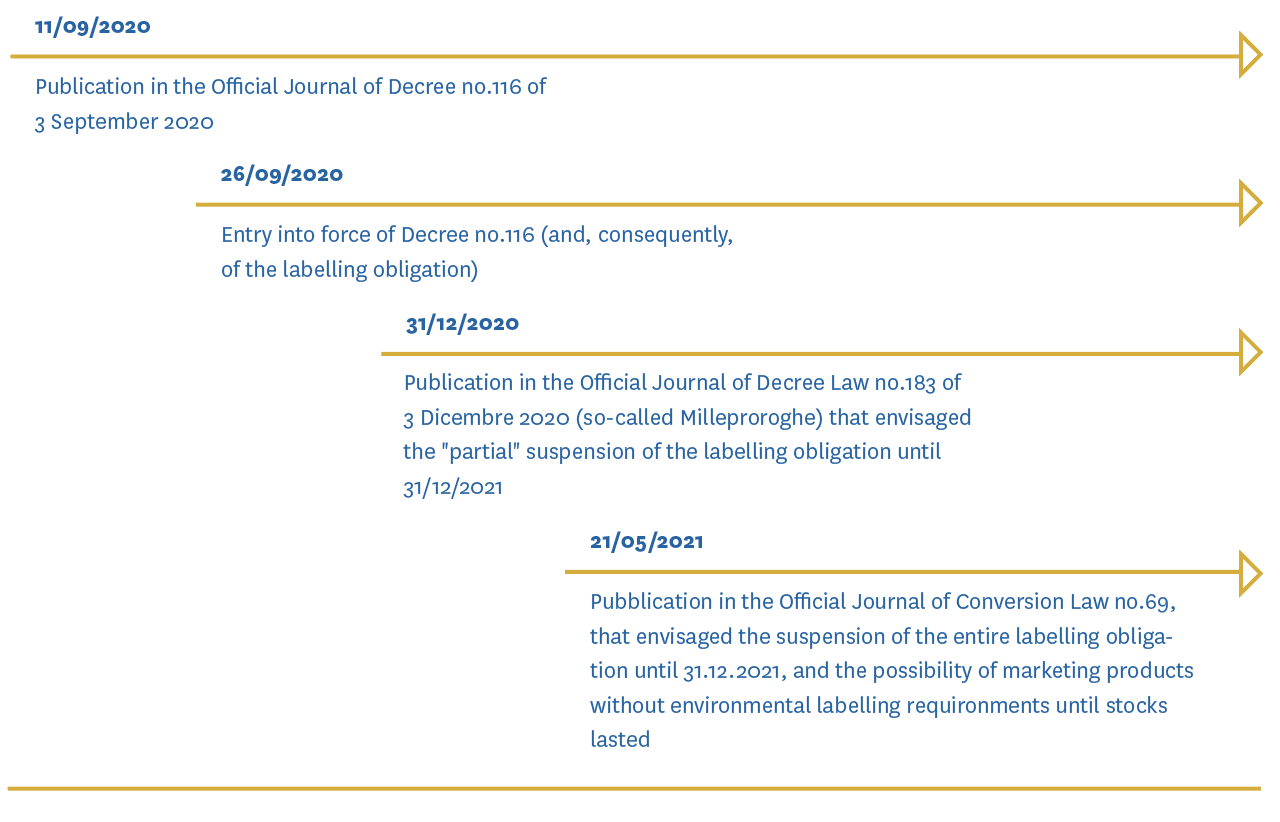
Does the content of the environmental label need to be printed directly on the packaging or can it be placed on a medium (e.g. a separate label)?
The content of the environmental label may be applied/printed/embossed directly on the packaging or placed on a separate medium if this is made possible by the packaging system in question.
How should multi-component packaging be labelled? Must the environmental label be placed on every component of a single sales unit?
The approach taken by CONAI is that set out in the “Etichetta per il cittadino” handbook: we do not believe it is necessary to label components that cannot be separated by hand, whereas labelling every component that can be separated by hand is in fact mandatory.
Therefore, environmental labels (at least the alphanumeric codes set forth in Decision 129/97/EC) should be affixed to each of the various components making up the sales unit that can be separated by hand.
Where this is not possible, they may be affixed either to the main body of the packaging, or to another label or any other component that makes the information easily visible to the end consumer.
The same applies in the case of multipacks, where it is always preferable to affix the label to each packaging component, but when this is not possible, the label may be affixed to the sales unit (i.e. on the multipack).
For example, in the diagram below, the ideal choice is to place the label, at least the one identifying the material, on each component, i.e. individually on the tray and film. If this is not possible, then you can place the label of the tray and film on one of the two components.
The same goes for single-portion chocolates (thin sheet): if it is not possible to place the label on the individual single-portion packaging, the relevant information may be included on one of the components of the sales unit.
If the product is sold with a leaflet (e.g. food supplements) or with instructions for use, and it is not possible to place the environmental label on the packaging due to a lack of space or other technological constraints, the content of the environmental label may be stated on such media.
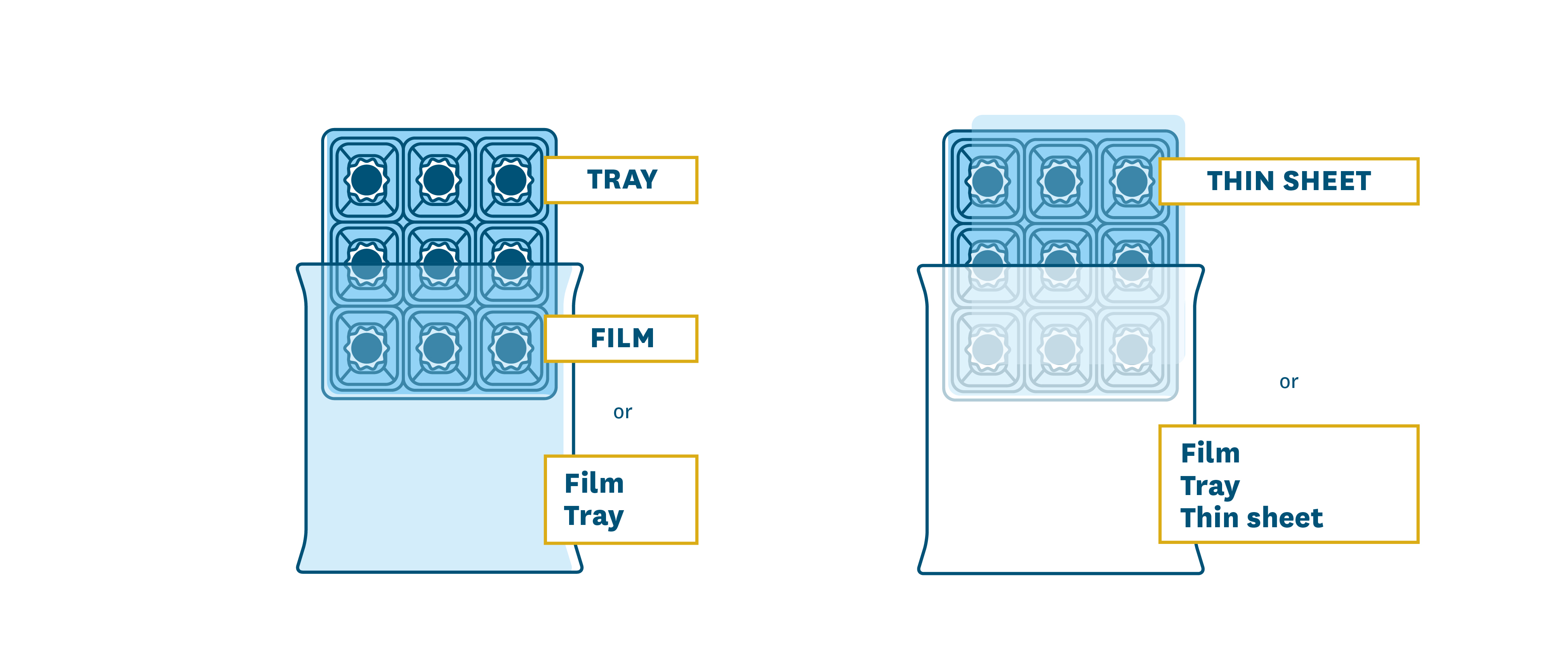
Should non-packaging accessories enabling use of the product (e.g. straws, cutlery) be labelled?
As such accessories are not packaging, they are not subject to the labelling requirement, but the packaging containing them is.
When is packaging defined as composite? How should it be labelled?
Packaging is defined as composite when it is made up of different packaging materials which cannot be separated by hand.
For the purpose of identifying the packaging material, the codes under Annex VII to Decision 129/97 are only affixed on composite packaging when the secondary packaging material exceeds 5% of the total weight of the packaging; otherwise, the code to be used is not that provided for in Annex VII but that of single-material packaging, based on the material prevailing in weight.
In particular, the coding of composite packaging envisages: C/ main material abbreviation and number associated with that specific coupling.
How should paper-based composite packaging (and/or with non-manually separable components of different materials) destined for the end consumer be labelled?
Without prejudice to the C/PAP… alphanumeric coding, which unambiguously identifies packaging composed primarily of paper, under Annex VII to Decision 129/97/EC further information on waste collection should be stated as follows:
- Paper-based composite packaging (and/or with non-manually separable components of different materials) with percentage of the cellulose part between 60 and 95% of the total weight of the packaging
- Stipulate that the consumer should dispose of the packaging in the separate collection for paper packaging;
- paper-based composite packaging (and/or with non-manually separable components of different materials) with percentage of the cellulose part less than 60% of the total weight of the packaging
-
Stipulate that the consumer should dispose of the packaging in the mixed waste collection.
In fact, it should be noted that such packaging, which to date is not recyclable, if put in separate collection and managed in the recycling flow of paper packaging, would have a significant effect on the generation of waste in the recycling process, even involving a greater environmental impact and increased management difficulties, also to the detriment of the overall quality of the secondary raw material generated by the recycling process.
In the recycling process, in fact, 100 kg of this packaging produces more than 85 kg of dry waste and almost 150 kg of wet waste to be disposed of in landfills, after consuming water and electricity. Therefore, since this packaging is not recyclable with paper and cardboard, the companies that produce and use it are asked to advise on the labelling that it is put in the mixed waste collection, in order to minimise the environmental impact linked to its end-of-life management.
-
- containers suitable for containing liquids
- Stipulate that the packaging should be included in separate waste collection, optionally accompanying the specification with the link to the website http://www.tiriciclo.it/raccolta-e-riciclo/, where there is a guide, for the consumer, on where to put cartons suitable for containing liquids, for each Italian municipality.
Can the symbol represented by three arrows in the shape of a triangle, containing an alphanumeric code as per Decision 97/129/EC, or another such symbol be used as to identify the packaging material?
Over the years, the identification of packaging material - not a legal requirement before 26 September 2020 - has been widely adopted by companies, in the different manners laid down by various rules and regulations. For example, many packages have been labelled with symbols that refer to the CEN/CR 14311 report (i.e. the Alu symbol inside circular arrows, the icon of a magnet to identify steel packages, or plastic polymer codes inside arrows in the shape of a triangle); plastic packaging made of one or more polymers not covered by Decision 129/97/EC has often been identified with the symbol “7” or “07 other”, sometimes placed within three arrows in the shape of a triangle.
Although these solutions have become consolidated market practice for the identification of such packaging materials, it should be noted that the regulation clearly states that packaging materials should be identified based on the provisions of Decision 129/97/EC and adopting applicable UNI standards, not other existing regulations or common practices.
Is it true that only recyclable packaging can be separated?
Please note that all packaging can be separated, whether or not it is recyclable using existing technologies, provided it is separated efficiently (e.g. always empty the packaging of its contents, reduce its volume when possible). Through CONAI’s Packaging Supply Chain Consortia, packaging will either be recycled or destined for energy recovery.
An evaluation of the packaging's recyclability is one of the additional pieces of information that a company may choose to display on the packaging, but this is independent of the information regarding the correct disposal of the packaging.
The only exception to this rule concerns mainly paper-based composite packaging (and/or with non-manually separable components of different materials), with a percentage of cellulose material less than 60% of the total weight, a percentage that compromises the recyclability of the packaging, making it impossible, with obvious consequences in terms of environmental impact. In the recycling process, in fact, 100 kg of this packaging produces more than 85 kg of dry waste and almost 150 kg of wet waste to be disposed of in landfills, after consuming water and electricity. Therefore, since this packaging is not recyclable with paper and cardboard, the companies that produce and use it are asked to advise on the labelling that it is put in the mixed waste collection, in order to minimise the environmental impact linked to its end-of-life management.
When is it possible to voluntarily claim the recyclability of packaging using the Mobius loop?

The producer can claim the recyclability of packaging using the Mobius loop, in accordance with UNI EN ISO 14021, when the packaging is recyclable under technical standard UNI EN ISO 13430:2005.
The UNI EN ISO 13430 technical standard
Packaging considered recyclable in accordance with the technical standard UNI EN ISO 13430 meets the criteria of eligibility for existing recycling technologies, namely:
- existence of an efficient recycling technology for the type of packaging;
- existence of a critical mass so that an efficient recycling process may be managed;
- existence of a market for recycled materials.
These criteria must be assessed via specific surveys and studies.
For more information, see the CONAI guidelines “Requirements defined by Directive 94/62/EC on packaging and packaging waste” available at the following link.
The UNI EN 11743:2019 technical standard
Companies wishing to assess the recyclability of their paper packaging may ask a laboratory to perform a recyclability test, which simulates the main steps of the industrial paper recycling process, in accordance with the procedure defined by UNI 11743:2019.
When can the biodegradability and compostability of packaging be claimed?
In order to be able to also put the biodegradable and compostable packaging waste (and other items) into organic waste collection, Legislative Decree 116/2020 amended Article 182-ter of Legislative Decree 152/2006 (organic waste): in particular, paragraph 6 of the aforementioned article establishes that waste, including packaging waste, having similar biodegradability and compostability properties to organic waste, must be collected and recycled together with the latter if:
- it is certified by accredited bodies as compliant with European standard EN 13432 for packaging recoverable through composting or biodegradation, or with European standard EN 14995 for other non-packaging items;
- it is appropriately labelled and includes, in addition to the mention of compliance with the above European standards, identification of the producer and the certifier, as well as appropriate instructions for consumers to send such waste to the circuit for the separate collection and recycling of organic waste;
- by 31 December 2023, it will be designed in such a way that it can be distinguished and separated from conventional plastics in common waste sorting plants and organic recycling plants,
This new measure, as well as providing incentives for the recycling of organic waste, also introduces important innovations in terms of the labelling of compostable packaging (and other items), since this, in addition to the information required by Article 219, paragraph 5 of Legislative Decree 152/2006, must also include the following elements on the label:
- indication of compliance of the packaging with European standards;
- identification details of the producer and certifier;
- appropriate instructions for consumers to put such waste in the separate collection circuit and in organic waste recycling.
It is therefore clear that, for the purposes of collection and recycling of compostable items in organic household waste, all biodegradable and compostable packaging must be certified in accordance with UNI EN 13432 (Requirements for packaging recoverable through composting and biodegradation).
Certification is an act of formal recognition of compliance with a technical standard of reference, which is issued by a certification body which, in turn, has been accredited by Accredia, a recognised association that operates on a non-profit basis under the supervision of the Ministry of Economic Development. Once accredited, bodies and laboratories can issue certificates of conformity and calibration, declarations of verification, test, analysis and inspection reports on the market with the "Accredia" accreditation mark.
Through the certification issued by the third-party accredited body, the producer or supplier can demonstrate to the market its ability to obtain and maintain the conformity of the products manufactured or services provided. To this end, the conformity mark is used, which is affixed to the product packaging or other external supports (the term “mark” refers exclusively to a graphic symbol that is affixed to the packaging in order to distinguish products that have obtained a certain certification. In essence, following the positive outcome of the audit and with the issue of certification, the third party grants the use of a logo/mark of conformity for a designated period of time). The mark, which certifies that the certification has been obtained, usually contains the licensee code, i.e. an alphanumeric code which makes it possible to trace the party that obtained the certification and the certified product.
In the specific case of the technical standard UNI EN 13432, being a product certification, the certification service can be issued only by product certification bodies that have been accredited according to ISO/IEC 17065. On the Accredia website it is possible to consult a database (https://www.accredia.it/banche-dati/) in which the accredited bodies and laboratories for issuing these certifications of compliance are listed.
These bodies or laboratories, in order to issue the conformity certificate, verify that the packaging in question possesses the characteristics established by the standard, i.e.:
- to biodegrade at least 90% in 6 months (i.e., at least 90% of the organic carbon constituting the material must be converted into carbon dioxide);
- if in contact with organic materials for three months, the mass of the material must consist of at least 90% of fragments smaller than 2 mm (to be verified according to EN 14045);
- the material must not have negative effects on the composting process;
- low concentration of heavy metals added to the material;
- pH values, salt content, volatile solids concentrations, and contractions of nitrogen, phosphorus, magnesium, and potassium must be below established limits.
How can the secondary raw material content of packaging be communicated voluntarily?
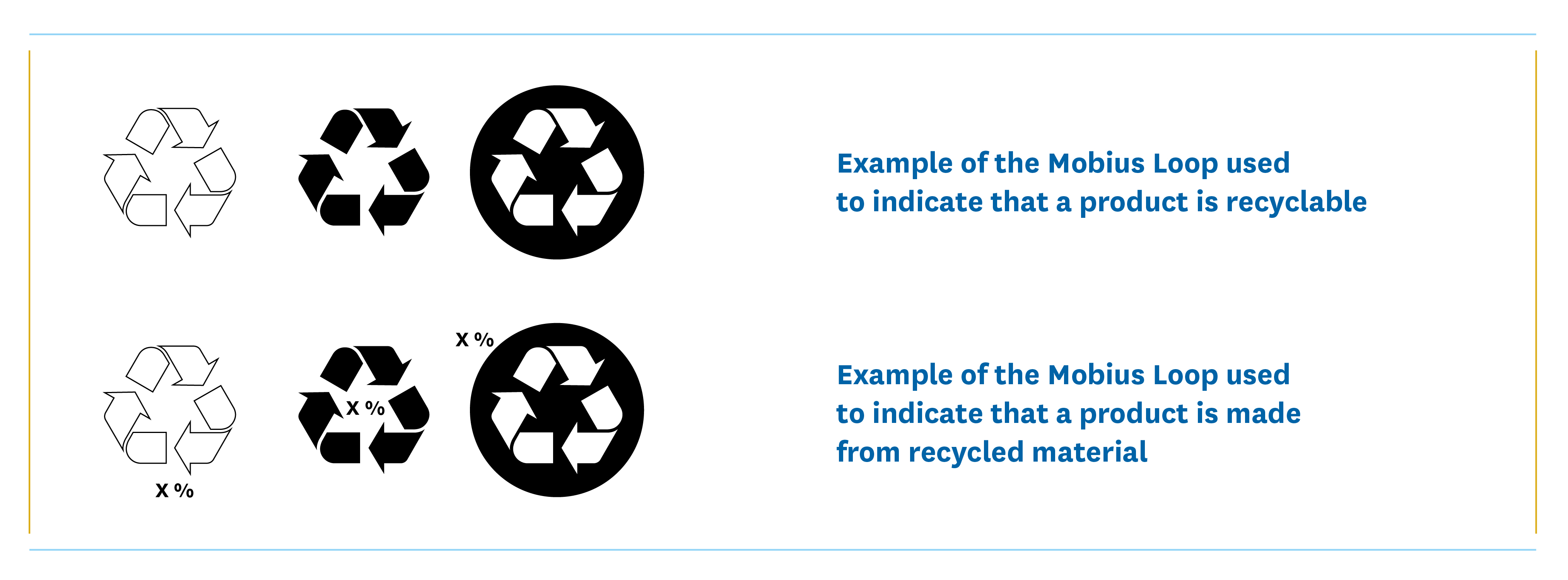
The secondary raw material content of packaging may be communicated using the Mobius loop containing a percentage value indicating the percentage weight of the recycled material.
Must the label be affixed to the packaging or can the information also be conveyed to the end consumer via digital channels (e.g. specific Apps, QR codes, etc.)?
For certain types of packaging, it may be extremely difficult, if not impossible, to affix full environmental labelling (e.g., small packaging or that with limited space, that for which the manufacturer may have technological difficulties in affixing material identification coding on the packaging, multilingual packaging, or imported packaging).
For some of these cases, the Ministry of Ecological Transition clarified, in a note issued on 17 May 2021, that, given the objective critical issues underlying the physical affixing of environmental labelling on packaging, the obligation is considered fulfilled if the mandatory information required by paragraph 5 of Article 219 of the TUA (Consolidated Environmental Act) is conveyed and communicated through digital channels (such as Apps, QR codes, bar codes, etc.), and if it is not possible through these tools, to make it available through websites.
The note also clarifies that, in general, it is allowed to give priority to the use of digital tools in order to fulfil the obligation of environmental labelling of packaging (e.g. App, QR code, websites), in line with the process of technological innovation and simplification, which is also a fundamental aspect foreseen within the National Recovery and Resilience Plan (PNRR).
In order to make the mandatory environmental information on the composition and - in the case of packaging intended for the end consumer - proper end-of-life management of packaging more easily available and consultable, it is suggested that clear indications be provided on the packaging or at the point of sale on how the consumer can search for it through digital tools or websites.
Is the producer bound by a specific graphic design for its environmental labels?
The graphic designer is free to choose the style, shape and colours of the environmental label: the regulations don’t specify these aspects, but they do recommend that packaging be appropriately labelled in such a way as to achieving the required goal.
Of course, in addition to being clear, not misleading and easy to understand by any consumer, the label must also be clearly legible. We therefore suggest referring to the provisions already laid down, in the food sector, by art. 13 of Regulation (EU) 1169/2011, which states that said information should be displayed on the packing in characters using a font size where the x-height is equal to or greater than 1.2 mm.
If, instead, the largest surface of the packaging has an area of less than 80 cm2, the x-height of the font size shall be equal to or greater than 0.9 mm.
From the point of view of design and colour, there are no mandatory provisions to be followed. Environmental labels may be designed in a single colour.
For coloured environmental labels, in order to provide citizens with consistent, standardised indications, CONAI suggests basing the colours used on the UNI 11686 standard on Waste Visual Elements, which prescribes the following colour codes:
- blue for paper,
- brown for food waste,
- yellow for plastic,
- turquoise for metals,
- green for glass,
- grey for unsorted waste.
Should the environmental label include the pictogram of a man throwing the packaging into a bin?

This pictogram is an invitation not to release the packaging to the environment. Its design has not been laid down by law, but the lawmakers have requested the use of a pictogram, freely designed, to invite citizens/consumers to adopt a suitable environmental behaviour. The pictogram was introduced in Ministerial Decree dated 28 June 1989, later repealed by art. 36 of Law no. 14 dated 3 February 2003 (later also repealed by the current Legislative Decree 152/2006).
How is infringement of art. 219, paragraph 5 punished?
Pursuant to article 261, paragraph 3, a financial penalty of EUR 5,200 to EUR 40,000 shall be applied to any party who places on the market packaging not bearing the required environmental label.
Environmental labelling in a nutshell
The table below summarises the contents of these Guidelines with a breakdown of the issues of greatest interest: the contents of the label, split by mandatory and recommended; the position and format, which are suggestions but not binding; and the timing.
This information applies to all packages with the exception of medicinal products, which AIFA (the Italian Medicines Agency) has communicated is exempt from this requirement.
However, it is worth noting that in some cases - especially with regard to neutral or small packaging (see the observations to FAQ 1) - certain technological limitations could make it impossible or disproportionately burdensome, from an organisational and logistical point of view, to affix the environmental label to packaging.
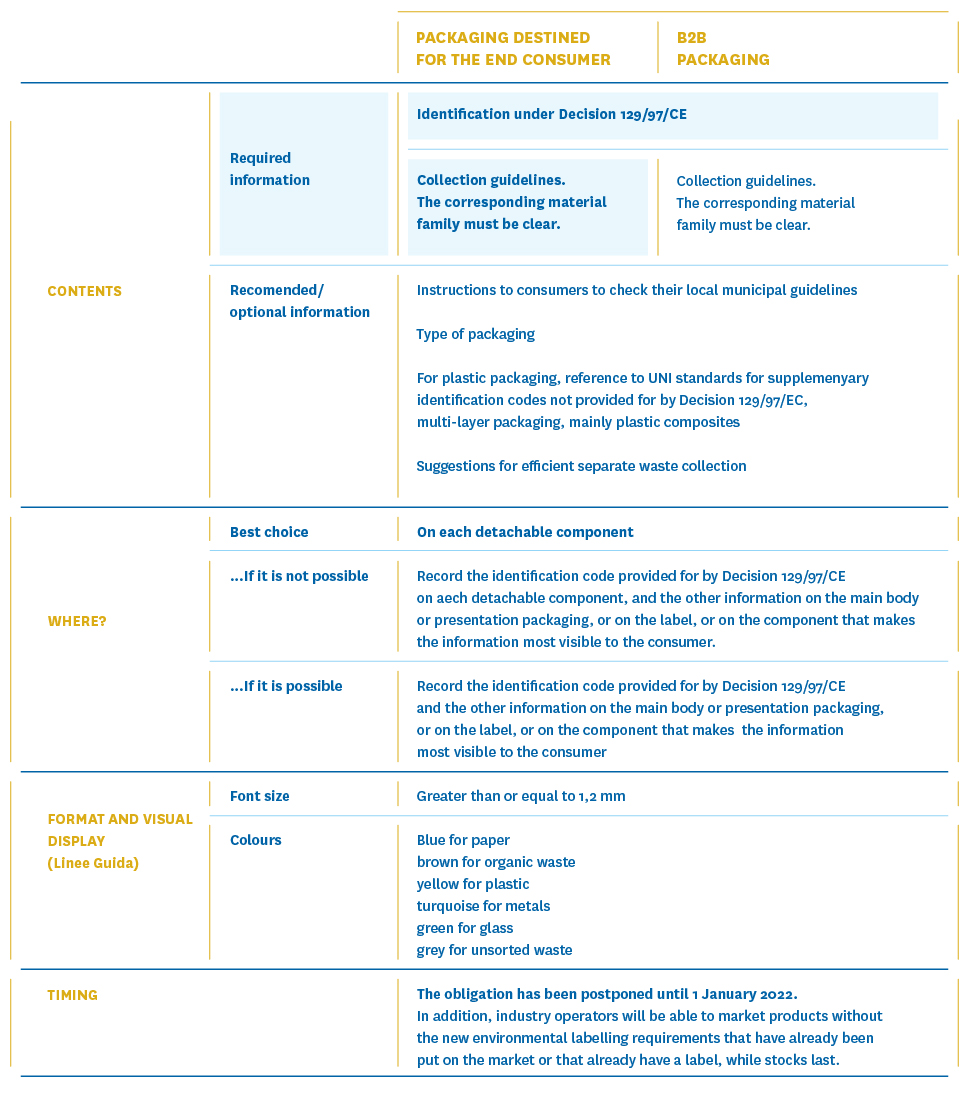
e-tichetta: the environmental labelling TOOL
Given the growing interest of companies in environmental labelling, CONAI has been working for a few months now on a special online tool (e-tichetta) designed to help companies create their environmental labels independently.
The aim of this tool is to guide companies step-by-step towards adopting a suitable, standard labelling system that complies with the law and provides end consumers with useful information and guidance.
e-tichetta is based on CONAI's Guidelines for the environmental labelling of packaging and is available either at CONAI or directly at e-tichetta.conai.org
HOW DOES THE TOOL WORK?
- Select the type of packaging
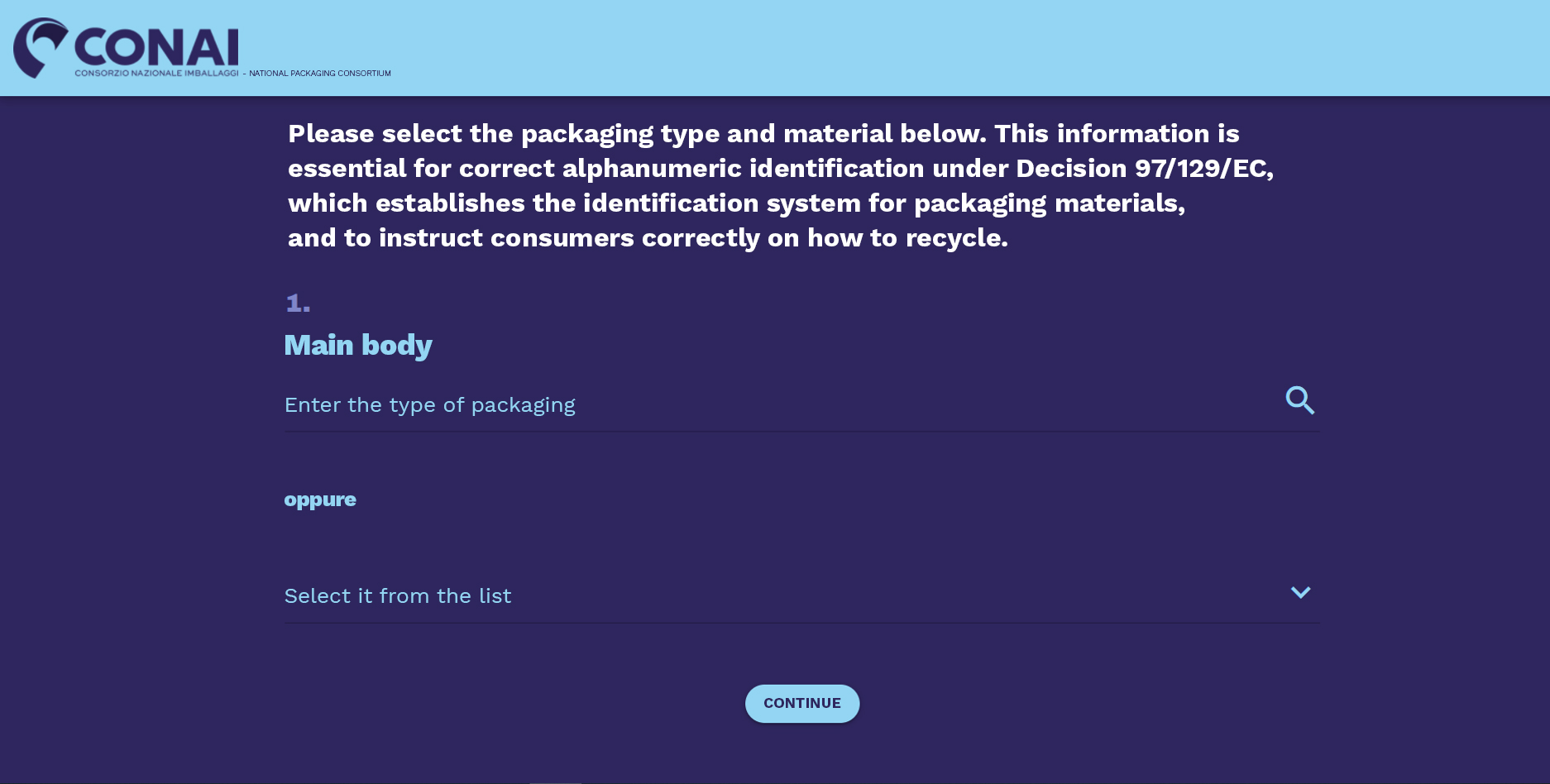
- Select whether it is single-material or composite packaging
- Select the material (or prevalent material) family
- Select the specific material
- If it is composite packaging, select the other secondary material(s)
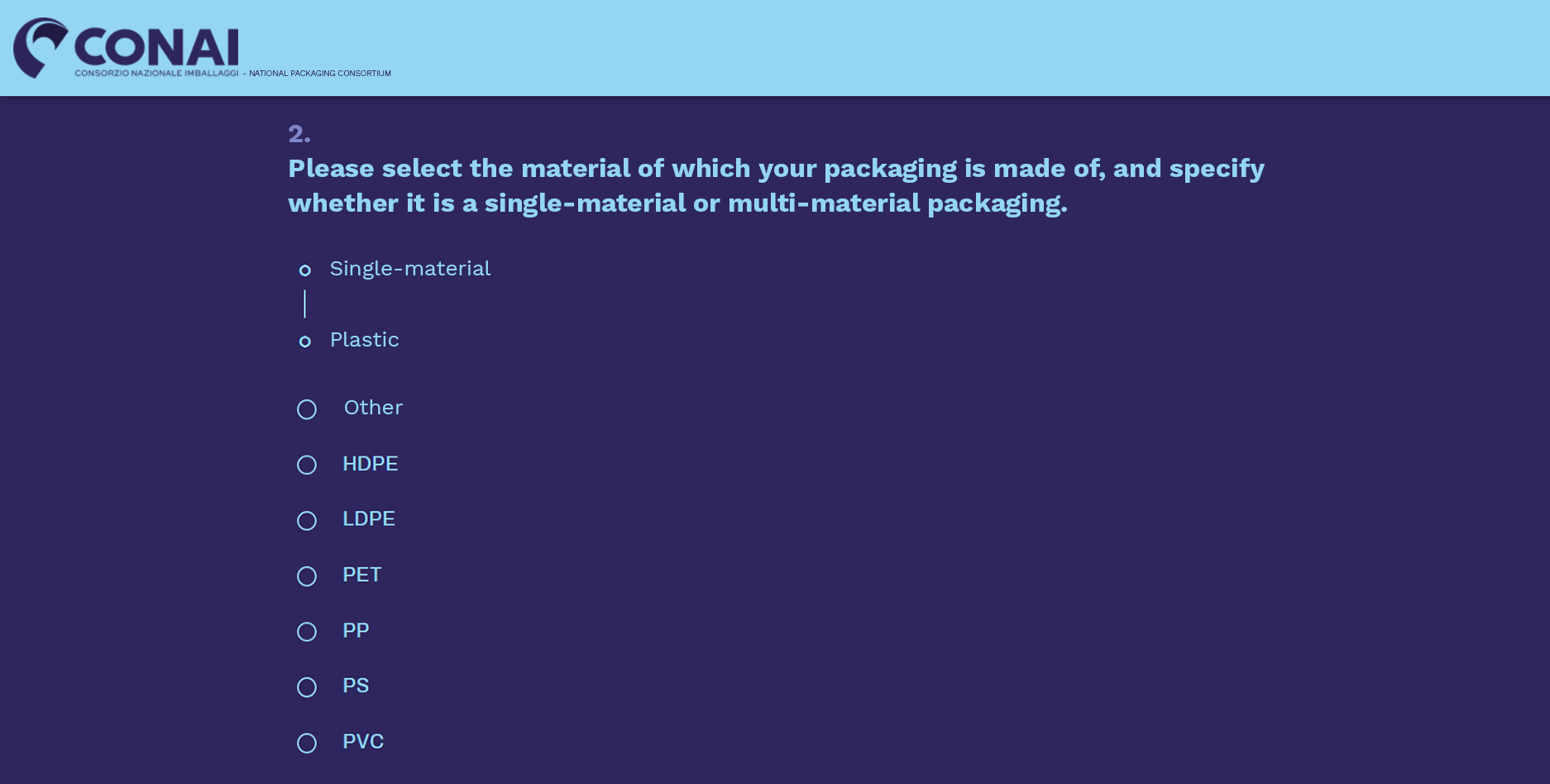
- Answer any additional questions that may help you obtain additional environmental information to be communicated to the end consumer
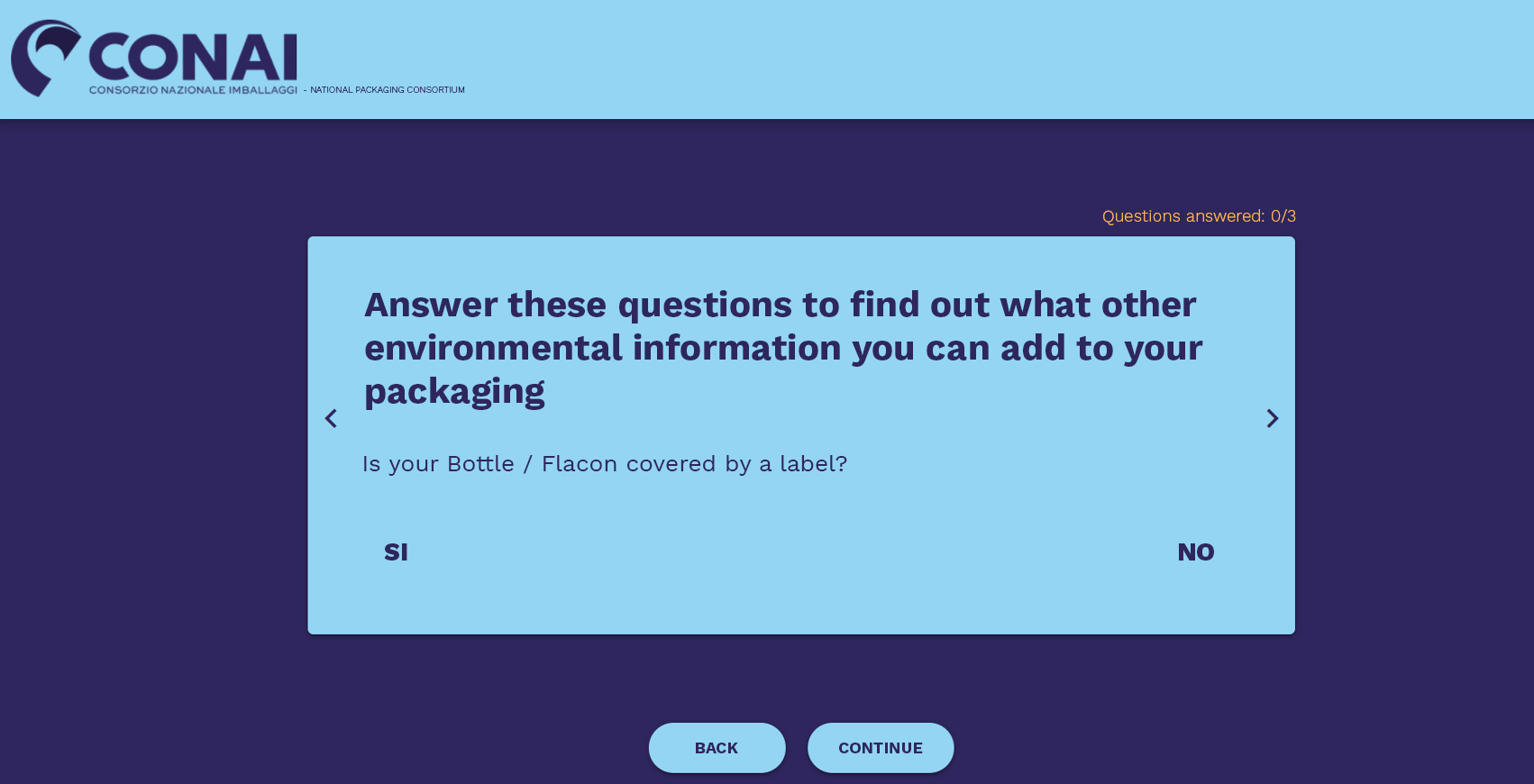
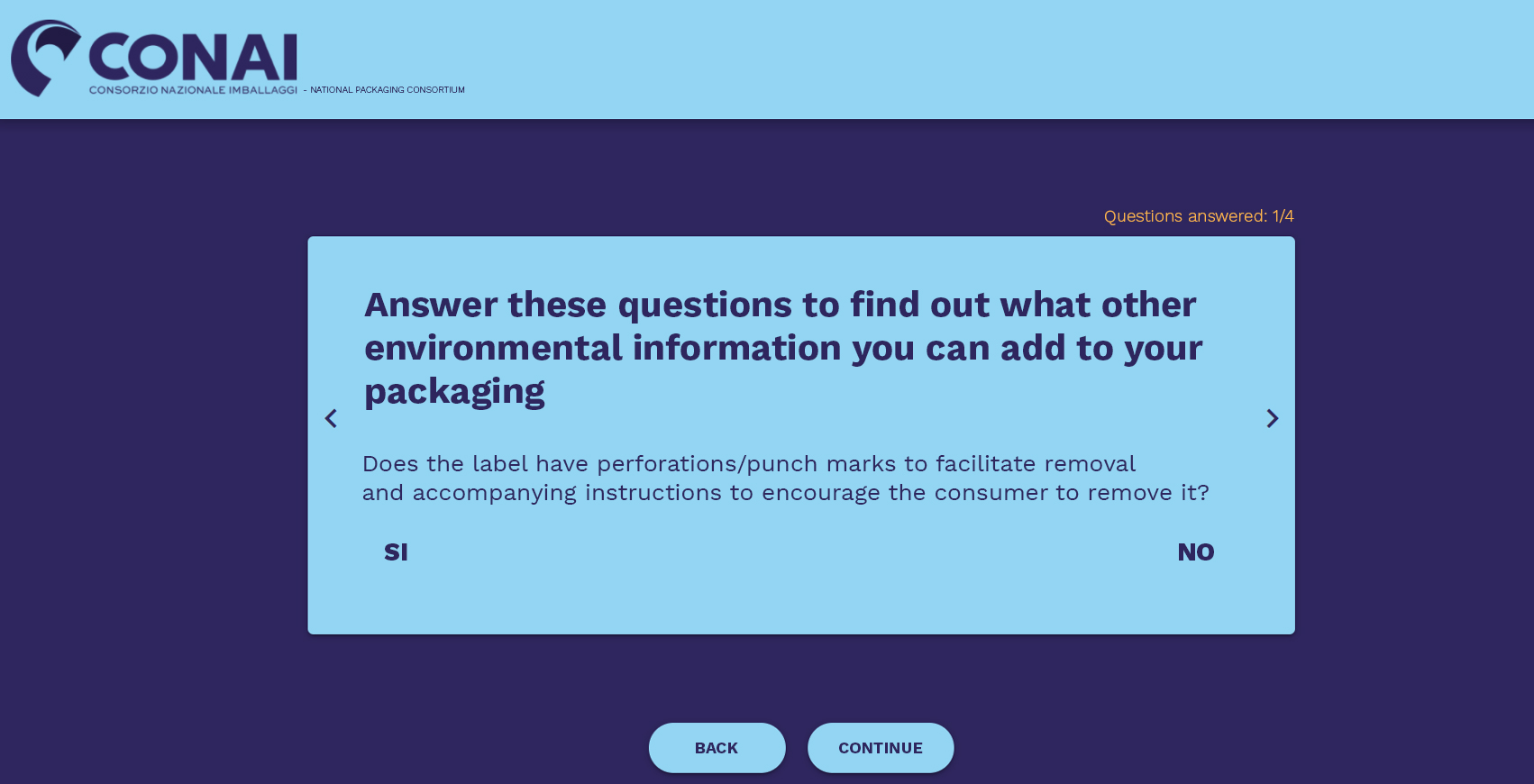
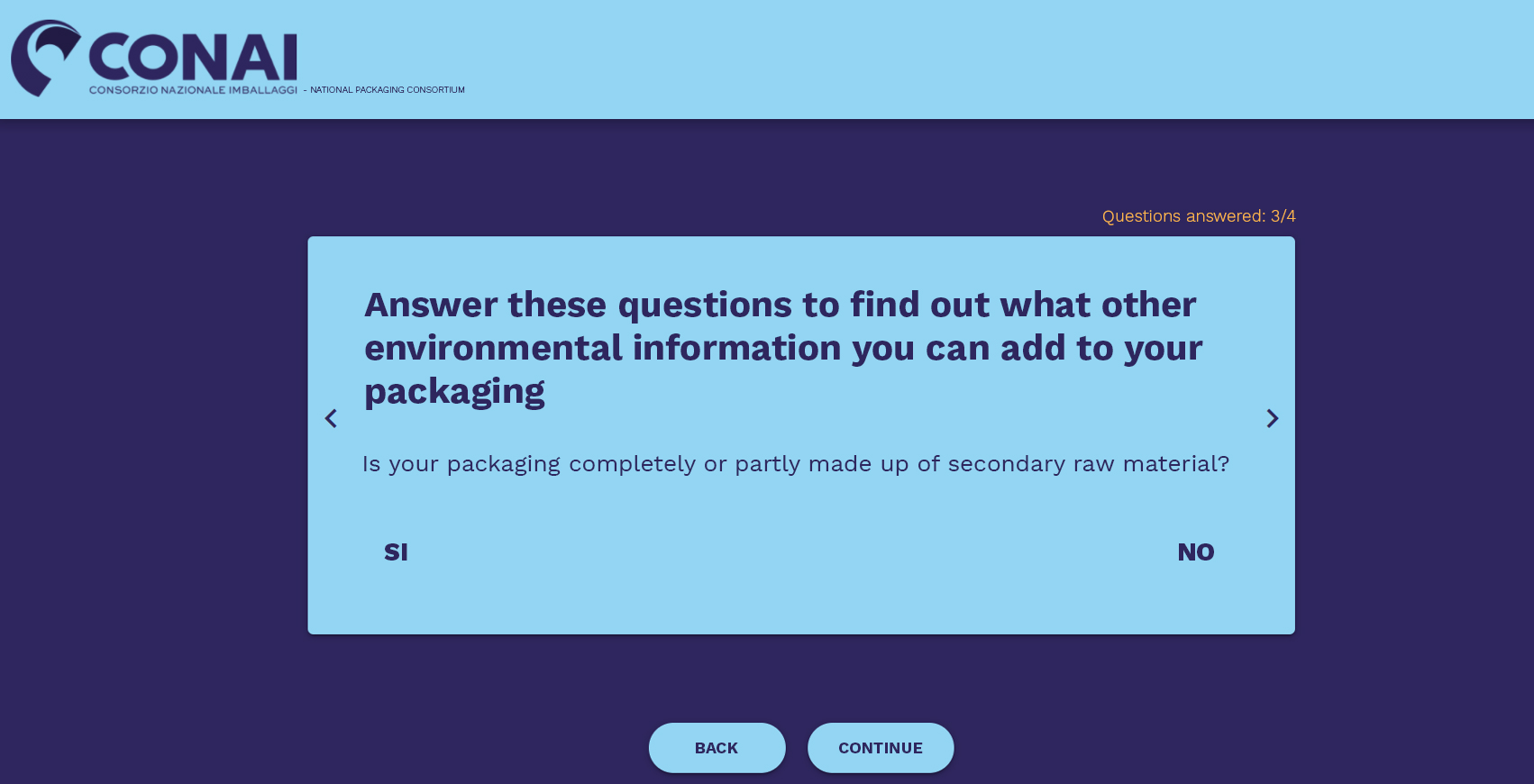
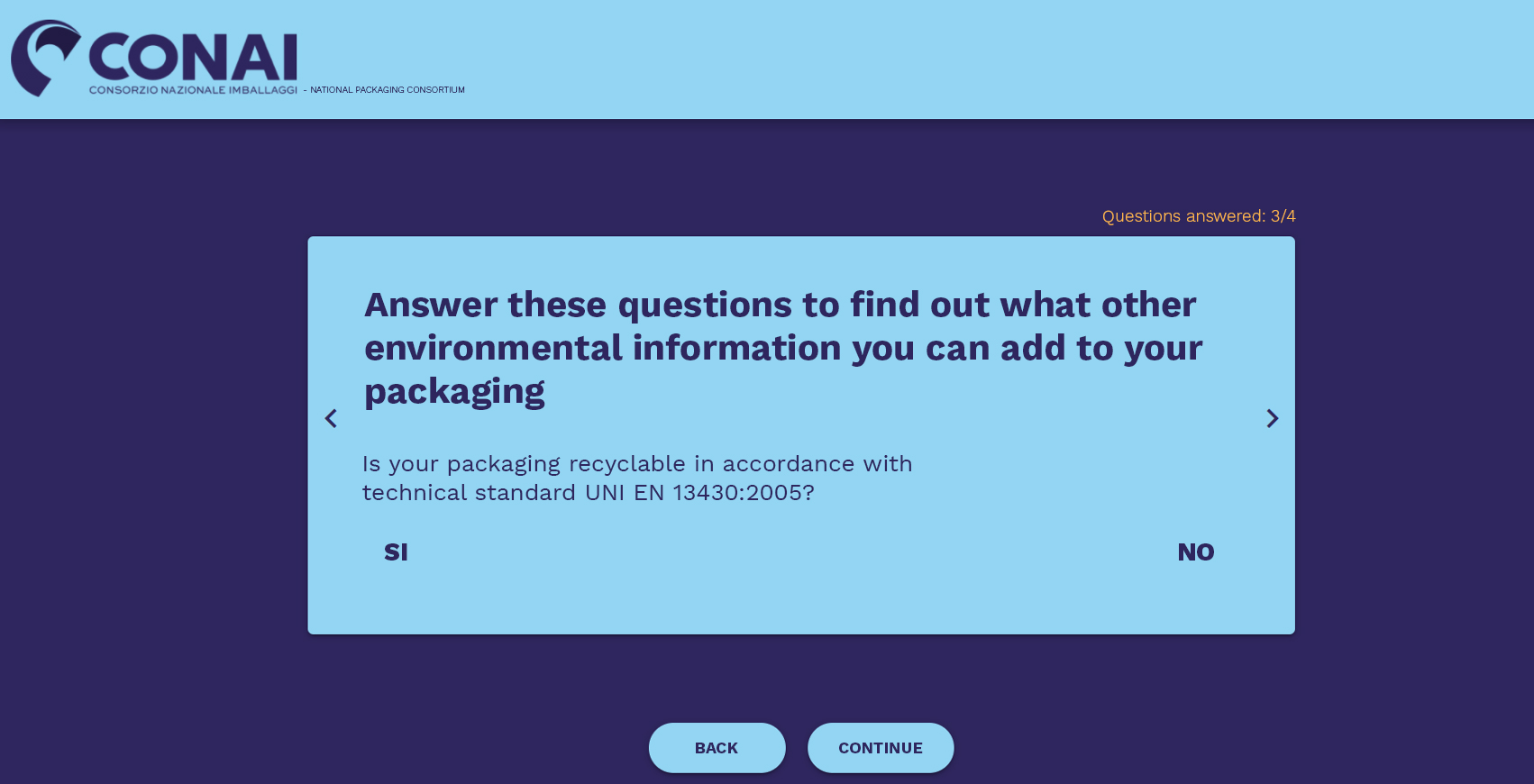
The tool outputs a series of information to be placed on the environmental label, including:
- Mandatory information:
- Type of packaging (1)
- Identification code of the packaging material (under Decision 129/97/EC or CEN/CR 14311:2002 in the case of steel, aluminium or plastic) (2)
- The material family in full so as to help the consumer correctly identify the packaging material, which is not always clearly recognisable from the alphanumeric code (3)
- Information on the type of separate waste collection and an invitation to consumers to check their local municipal guidelines (4)
- Voluntary information that may help the consumer separate waste efficiently (5).
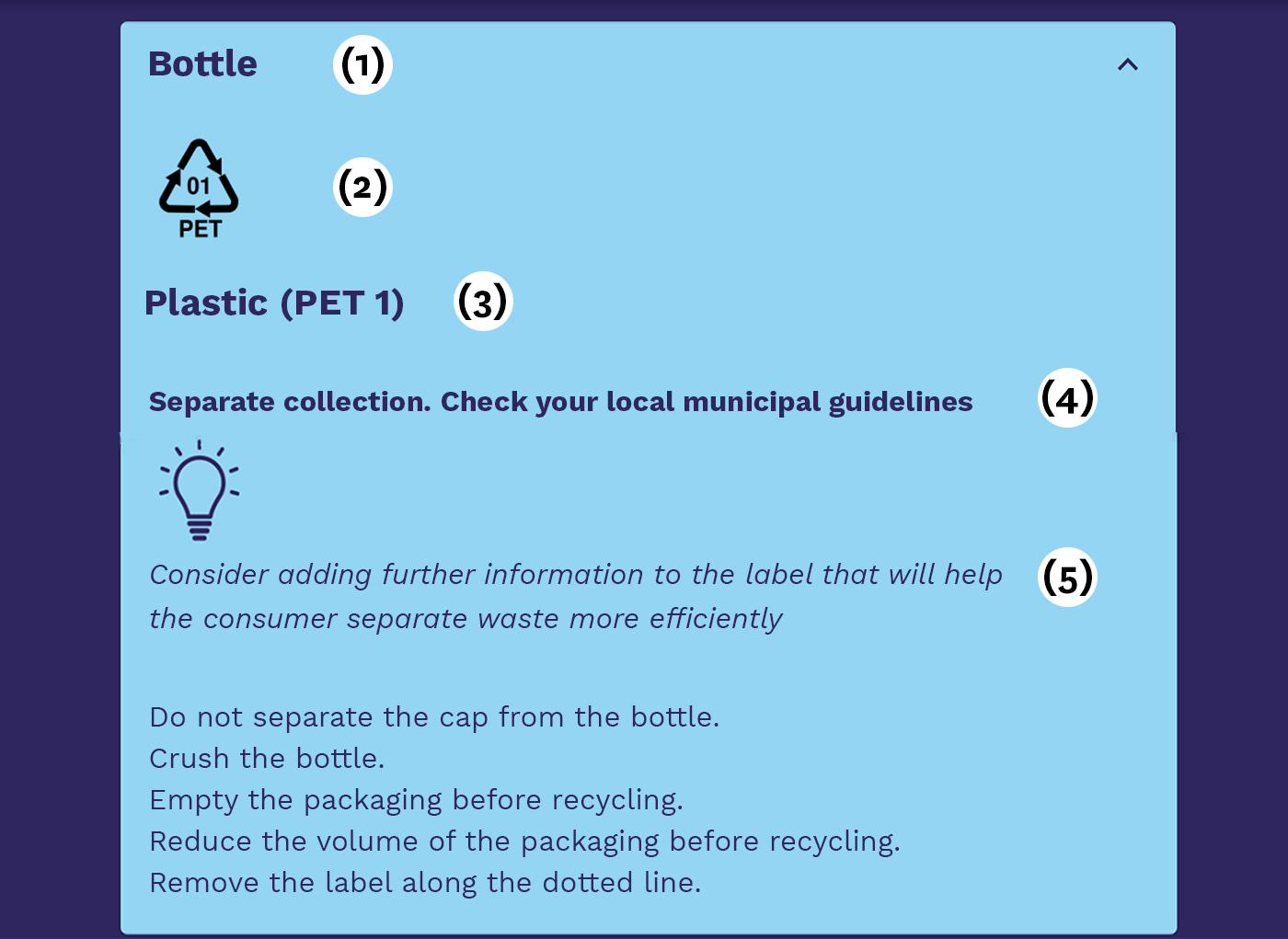
- Voluntary information on any further environmental characteristics of the packaging (recyclability and recycled content of each component) and on its compliance with the CONAI system through use of the consortium’s specific trademark (6).
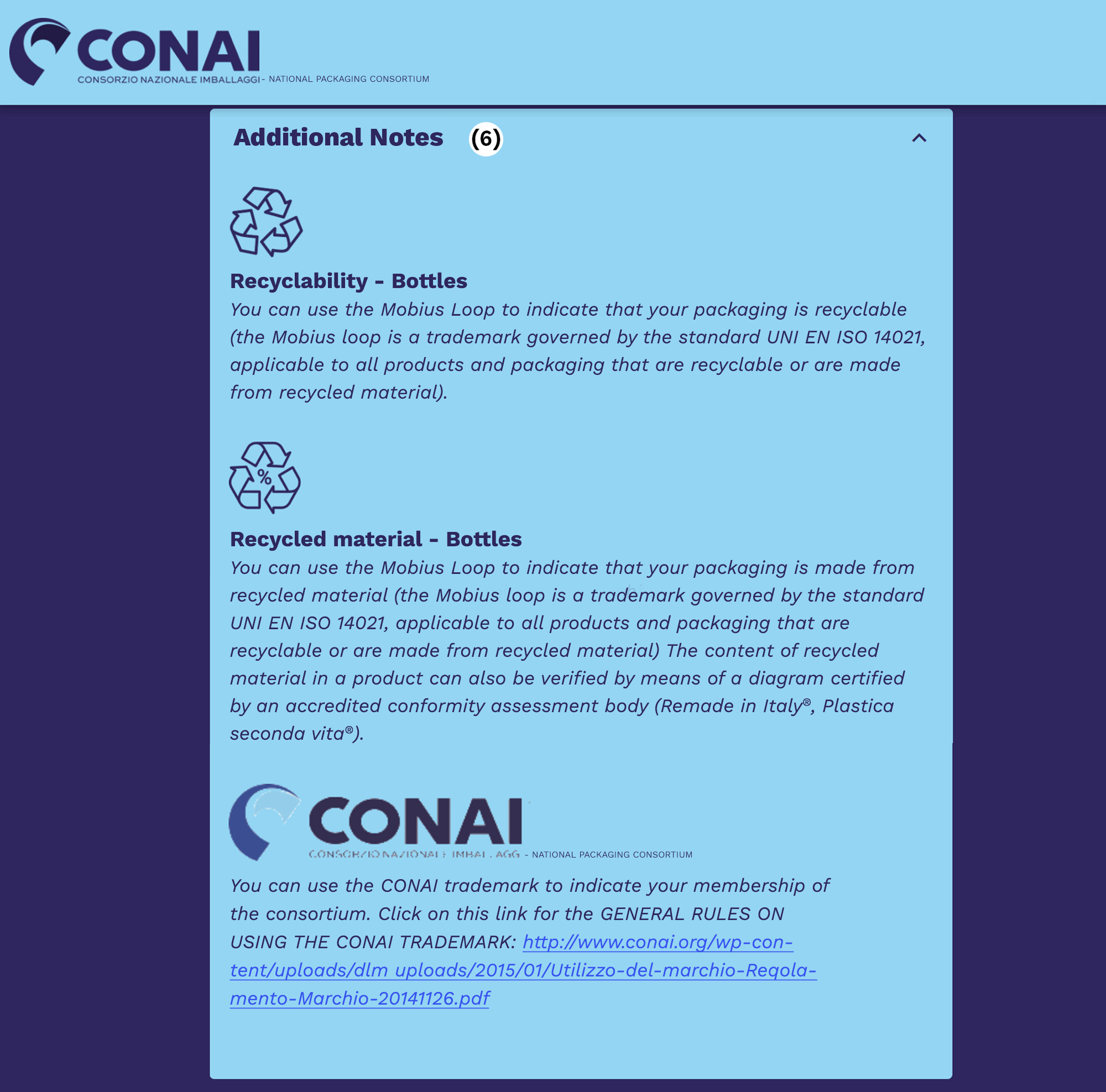
Glossary
SELF-PRODUCER
(CONAI (n.d.). Glossary. Available in the Glossary CONAI)
“Self-producers” are defined as any parties that purchase raw materials and packaging materials in order to manufacture/repair packaging for their own products (which are different from the packaging). For all intents and purposes, self-producers are considered users, also with reference to the raw material involved in repairing their own packaging.
BIODEGRADATION
(Greene, J.P. (2014). Sustainable Plastics: Environmental Assessments of Biobased, Biodegradable, and Recycled Plastics. (1st Ed). John Wiley & Sons.)
Biodegradation is a thermochemical process that takes place in a specified time frame and under specific environmental conditions. During biodegradation, the materials/products are converted to biomass, water and carbon dioxide.
COMPOSTABILITY
(Greene, J.P. (2014). Sustainable Plastics: Environmental Assessments of Biobased, Biodegradable, and Recycled Plastics. (1st Ed). John Wiley & Sons.)
Compostability is the property of a material to generate compost (biomass) through the composting process, namely an aerobic biological process that takes place under externally imposed environmental conditions. In industrial composting plants, the temperatures used usually range from 50 °C to 60 °C, with a moisture content in the 45% to 55% range.
The technical standard UNI EN 13432 states the requirements for packaging recoverable through composting:
- Packaging shall be designed, produced and commercialised in such a way as to permit its reuse or recovery, including recycling, and to minimise its impact on the environment when packaging waste or residues from packaging waste management operations are disposed of;
- Packaging waste processed for the purpose of composting shall be of such a biodegradable nature that it should not hinder the separate collection and the composting process or activity into which it is introduced;
- Biodegradable packaging waste shall be of such a nature that it is capable of undergoing physical, chemical, thermal or biological decomposition such that most of the finished compost ultimately decomposes into carbon dioxide, biomass and water.
PACKAGING SUPPLY CHAIN CONSORTIA
(CONAI (2020). Guide to membership and to the application of the Environmental Contribution (Volume 1). Available from CONAI)
According to art. 223 of Italian Legislative Decree 152/06, packaging producers are required to join together in a Consortium for each packaging material (steel, aluminium, paper, wood, plastic and glass). The six Packaging Supply Chain Consortia are as follows:
Ricrea – National Consortium for the Recycling and Recovery of Steel Packaging;
Cial – National Aluminium Packaging Consortium;
Comieco – National Consortium for the Recovery and Recycling of Paper-Based Packaging;
Rilegno – National Consortium for the Collection, Recovery and Recycling of Wooden Packaging;
Corepla – National Consortium for the Collection, Recycling and Recovery of Plastic Packaging;
Coreve – Glass Recovery Consortium.
Instead of joining the Packaging Supply Chain Consortia, producers can opt instead, pursuant to art. 221, paragraph 3, of the same Decree: “a) to organise the management of their own packaging waste autonomously - even collectively - throughout the country; [...] c) to certify, under their sole responsibility, that a take-back scheme has been put in place for the return of their packaging, supported by suitable documentation demonstrating the scheme's self-sufficiency [...].”
CONSUMER
(CONAI (n.d.). Glossary. Available in CONAI Glossary)
Packaging consumers are individuals who purchase or import packaging or packaged items or goods for their own use, and not for the purpose of carrying out their business.
WASTE MANAGEMENT
(CONAI (n.d.). Glossary. Available in the CONAI Glossary)
According to art. 183, paragraph 1, letter n) of Italian Legislative Decree 152/06, waste management refers to: “the collection, transport, recovery and disposal of waste, including the control of said operations and work following the closure of disposal sites, as well as operations carried out as traders or brokers.”
PACKAGING
(Legislative Decree 152/06, Article 218 (3 April 2006). Available from the Italian Chamber of Deputies)
According to Italian Legislative Decree 152/06, Art. 218, packaging means “the product, consisting of materials of any kind, used to contain certain goods, from raw materials to finished products, to protect them, allow their handling and their delivery from the producer to the consumer or user, ensure their presentation, as well as disposable items used for the same purpose.”
COMPOSITE PACKAGING
(Decision 129/97/EC EUR-Lex)
“Composite” packaging is defined as packaging made up of different materials, which cannot be separated by hand.
MULTI-MATERIAL PACKAGING
(CONAI (2020). Guide to membership and to the application of the Environmental Contribution (Volume 1). Available from CONAI)
This term is used to mean packaging consisting of a number of independent parts made from different materials. Unlike composite packaging, in this case the various materials making up the packaging can be separated. For example, the following qualify as multi-material packaging: chocolate box (paper for the box, plastic for the shaped insert), sweet bag (plastic for the bag, paper for the individual sweet wrappers), coffee tin (aluminium for the tin, plastic for the lid), etc...
FULL PACKAGING
(CONAI (n.d.). Glossary. Available in the CONAI Glossary)
The term “full packaging” means any packaged goods and, in particular, the packaging of these goods. For example, for an importer of cans of beer, “full packaging” means the aluminium in the cans as well as any other secondary and tertiary packaging used.
PRIMARY PACKAGING (OR SALES PACKAGING)
(CONAI (n.d.). Glossary. Available in the CONAI Glossary)
In art. 218, letter b) of Italian Legislative Decree no. 152/06, primary packaging is defined as “packaging conceived so as to constitute a sales unit to the end user or consumer at the point of purchase”. Generally speaking, primary packaging is used for an individual product ready for consumption.
SECONDARY PACKAGING (OR GROUPED PACKAGING)
(CONAI (n.d.). Glossary. Available in the CONAI Glossary)
In art. 218, letter c) of Italian Legislative Decree 152/06, secondary packaging is defined as “packaging conceived so as to constitute, at the point of sale, a grouping of a certain number of sales units, whether the latter is sold as such to the end user or consumer, or whether it serves only as a means to replenish the shelves at the point of sale. It can be removed from the product without affecting its characteristics”. Generally speaking, secondary packaging is used to group a certain number of individual products ready for consumption. Once removed from the secondary packaging, the product is unaltered and ready for use in its primary packaging.
TERTIARY PACKAGING (OR TRANSPORT PACKAGING)
(CONAI (n.d.). Glossary. Available in the CONAI Glossary)
In art. 218, letter d) of Italian Legislative Decree 152/06, tertiary packaging is defined as “packaging conceived so as to facilitate handling and transportation of goods, from raw materials to finished products, or of a certain number of sales units or grouped packaging to prevent physical handling and transport damage, excluding containers for road, rail, sea and air transport”. Generally speaking, tertiary packaging is used to protect and facilitate the handling of goods during transportation.
SECONDARY RAW MATERIAL (SRM)
(Italian Legislative Decree 205/10, Article 184-ter of 3 December 2010.
Available from the Italian Chamber of Deputies)
Set of waste that ceases to be such if it is subject to recovery operations, including recycling, and if it meets specific criteria.
UNI STANDARDS
(UNI (n.d.). About us. Available from UNI)
The letters UNI identify “voluntary regulatory documents (UNI standards, technical specifications, technical reports and reference practices) in all industrial, business and tertiary sectors.”
Technical standards are standards - compliance with which is voluntary - approved and published by an international, European or national standardisation body; they are basically regarded as “best practices”.
Compliance with same is not mandatory, and alternative, equivalent solutions are possible, provided they are proven to be effective.
PACKAGING PRODUCER
(CONAI (n.d.). Glossary. Available in the CONAI Glossary)
Based on art. 218, paragraph 1, letter r) of Italian Legislative Decree 152/06, packaging producers are “suppliers of packaging materials, manufacturers, processors and importers of empty packaging and packaging materials”.
SEPARATE WASTE COLLECTION
(Italian Legislative Decree 152/06, Article 183, paragraph 1, letter f) of 3 April 2006. Available from the Italian Chamber of Deputies)
Separation - performed according to cost-effectiveness, efficacy, transparency and efficiency criteria - designed to sort municipal waste into like fractions at source, when the waste is collected or, for the food waste organic fraction, even at the processing stage, and to separate packaging waste from other municipal waste, on condition that all the above-mentioned waste is actually sent for recovery.
RECOVERY OF PACKAGING WASTE
(Italian Directive 2008/98/EC, Article 3, paragraph 15 of 19 November 2008. Available from EUR-Lex)
The recovery of generated waste means any operation whose main result is to allow waste to serve a useful purpose by replacing other materials that would otherwise have been used to fulfil a particular function, or to prepare waste to fulfil that function, in the plant or in the wider economy.
ENERGY RECOVERY (WASTE-TO-ENERGY)
(CONAI (2020). Guide to membership and to the application of the Environmental Contribution (Volume 1). Available from CONAI)
According to art. 218, paragraph 1, letter n) of Italian Legislative Decree 152/06, energy recovery from packaging waste is achieved where said packaging waste is combustible and is used to produce energy by means of waste-to-energy plants (with or without other types of waste).
PACKAGING RECYCLING
(Directive 2008/98/EC, Article 3, paragraph 17 of 19 November 2008. Available from EUR-Lex)
Any recovery operation by which waste materials are reprocessed into products, materials or substances whether for the original or other purposes. It includes the reprocessing of organic material but does not include energy recovery and the reprocessing into materials that are to be used as fuels or for backfilling operations.
PACKAGING WASTE
(Directive 2008/98/EC, Article 3, paragraph 1 of 19 November 2008.
Available from EUR-Lex)
Any substance or object which the holder discards or intends or is required to discard.
PACKAGING USER
According to art. 218, paragraph 1, letter s) of Italian Legislative Decree 152/06, users are “traders, distributors, fillers, users of packaging, and importers of filled packaging.”
Appendix
Environmental labelling
(This information can also be found in the Guidelines for the environmental labelling of packaging )
The different types of environmental label may be broken down according to their purpose, namely:
- Identification of the packaging’s composition material: Decision 129/97/EC (mandatory for all packaging);
- Instructions for the consumer to dispose of in the separate waste collection (mandatory for all packaging intended for the B2C channel);
- Voluntary environmental labelling.
Identification of the packaging’s composition material: Decision 129/97/EC
Directive 94/62/EC, addressed to packaging producers and users, and covering all packaging placed on the market, required Member States to:
4) achieve recycling and recovery goals;
5) comply with essential requirements;
6) identify the packaging material by means of identification codes to facilitate collection, reuse and recovery, also through recycling, on the basis of Decision 129/97/EC.
Since 1997, the labelling of packaging had remained voluntary, but the mandatory regulatory framework to be taken into account for the identification of packaging materials was already Decision 129/97/EC.
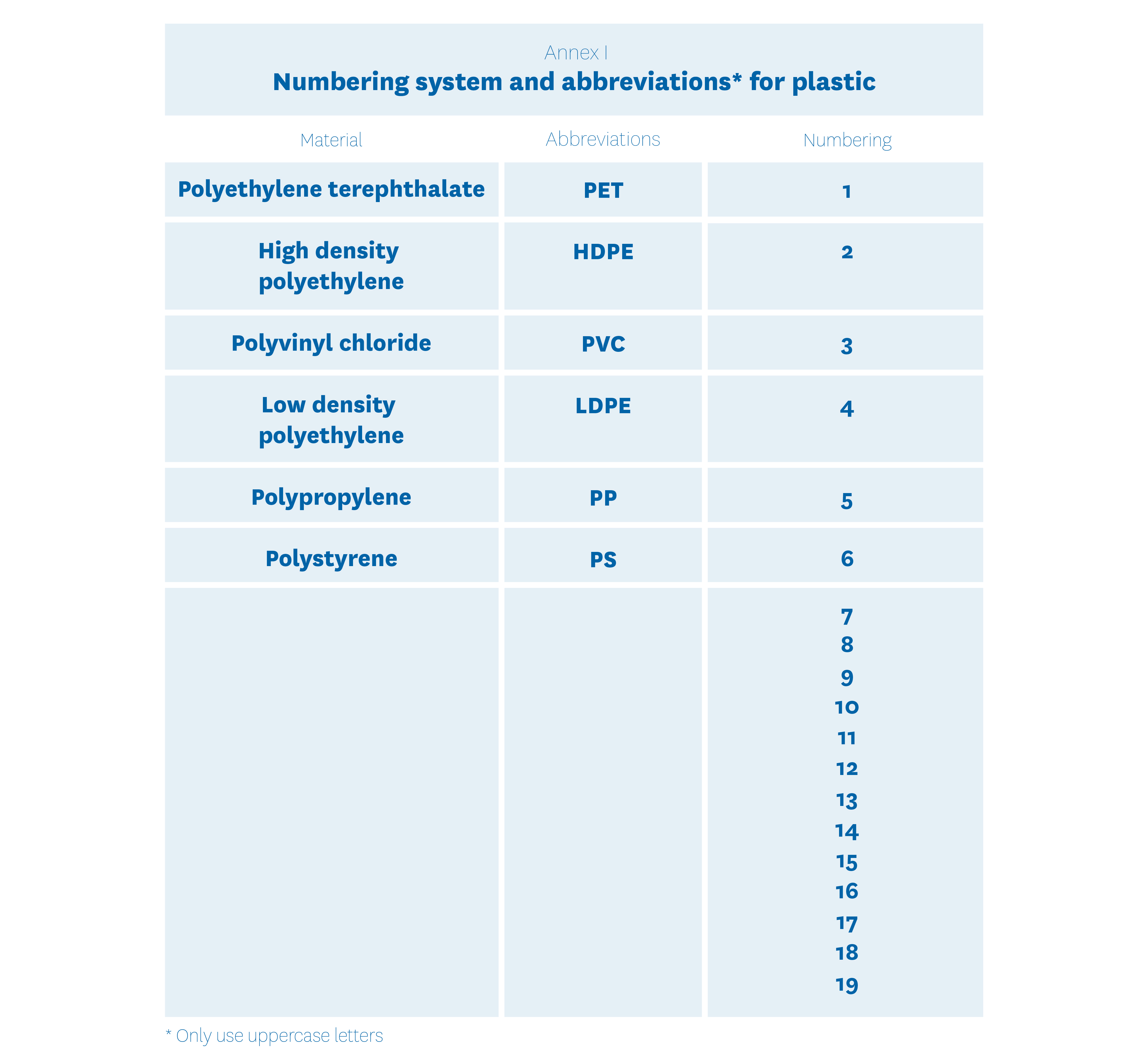
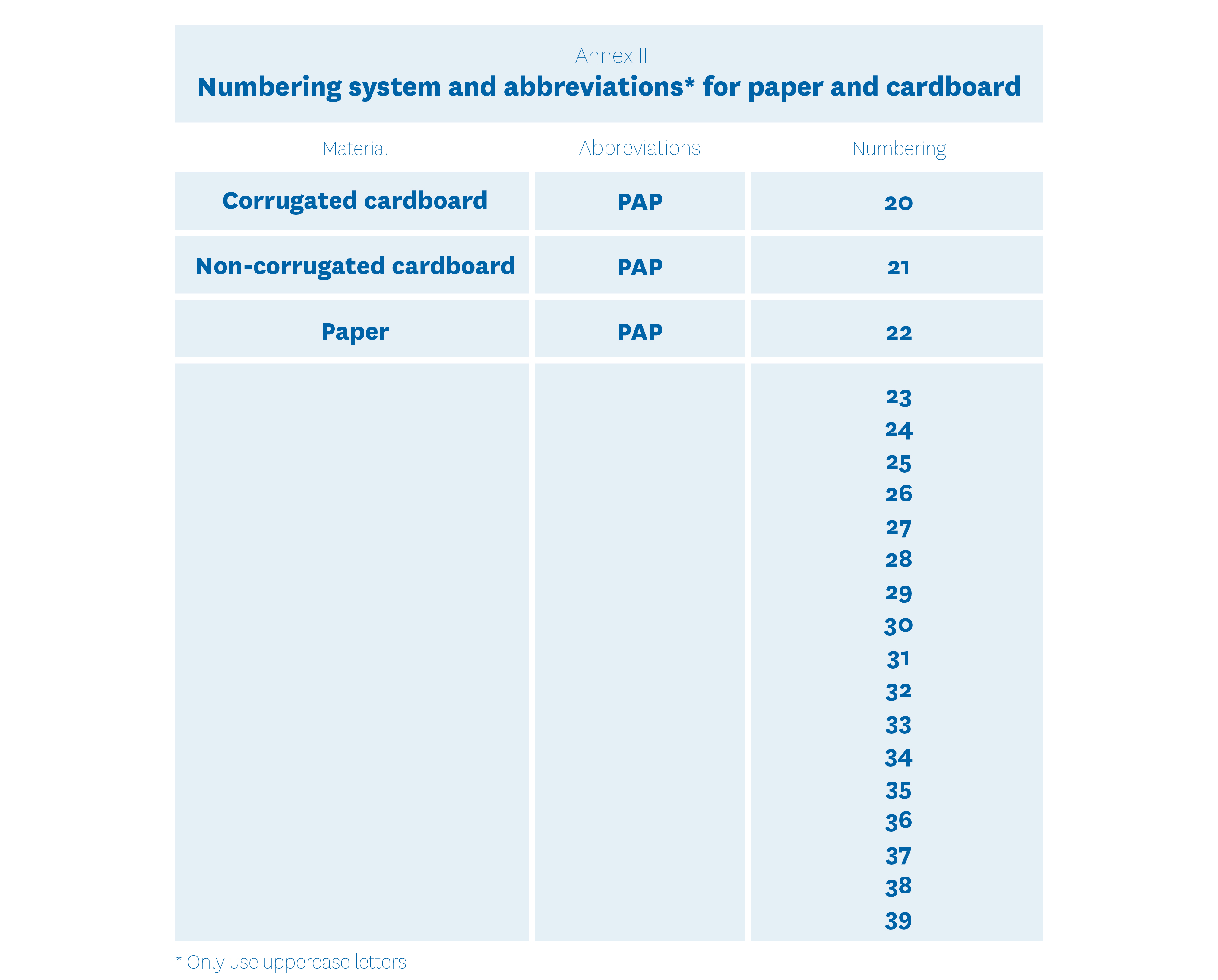
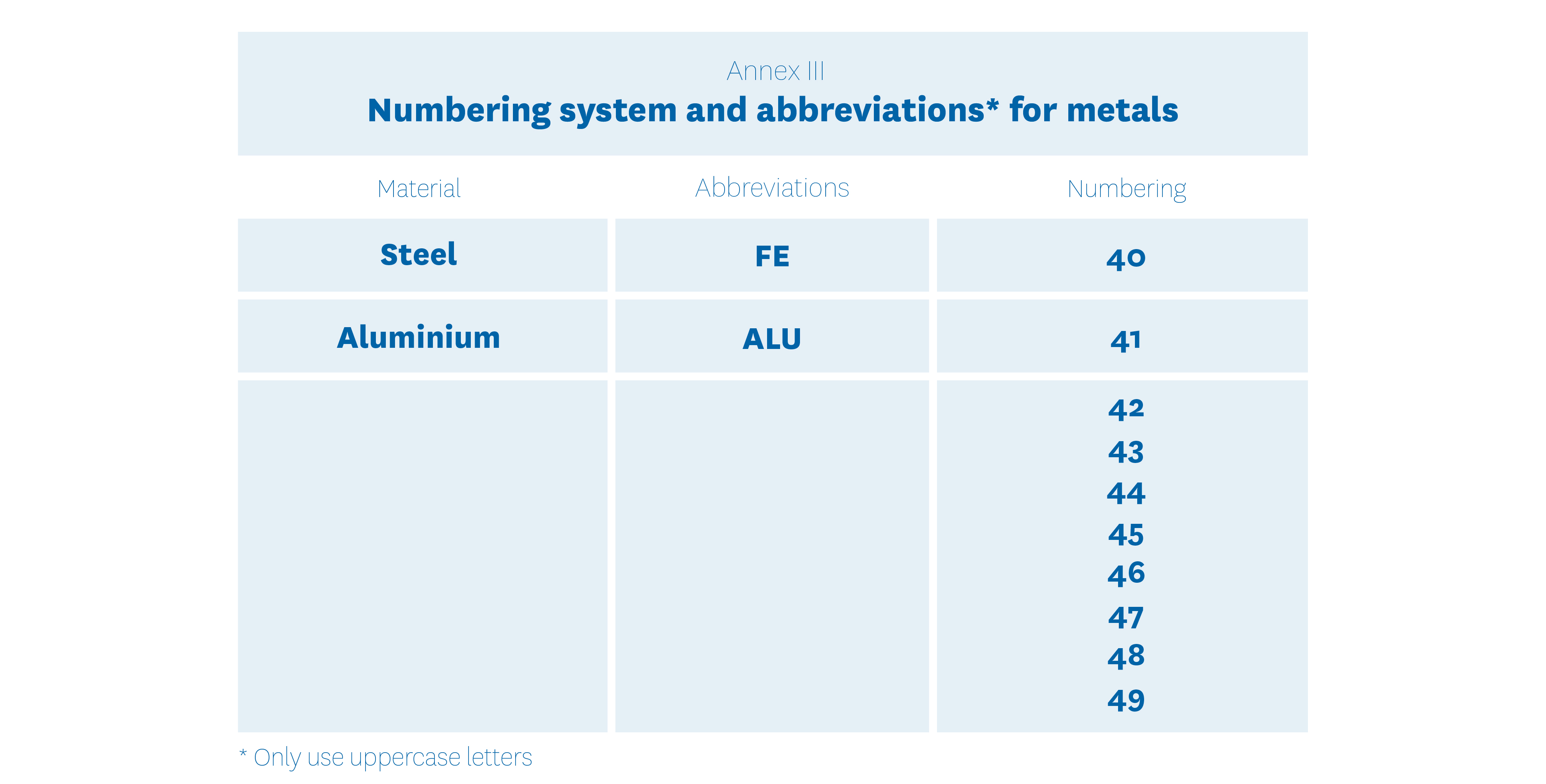
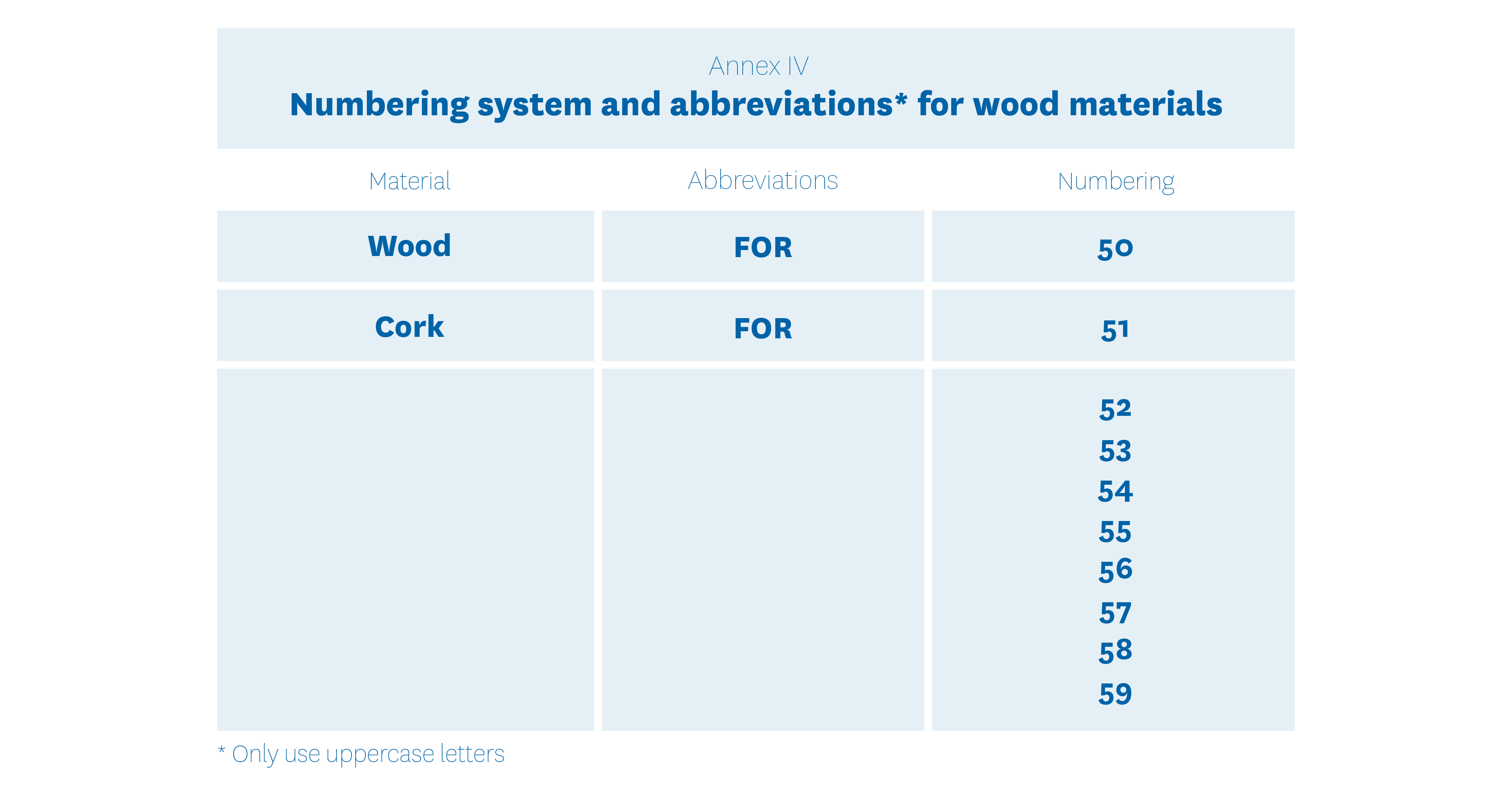

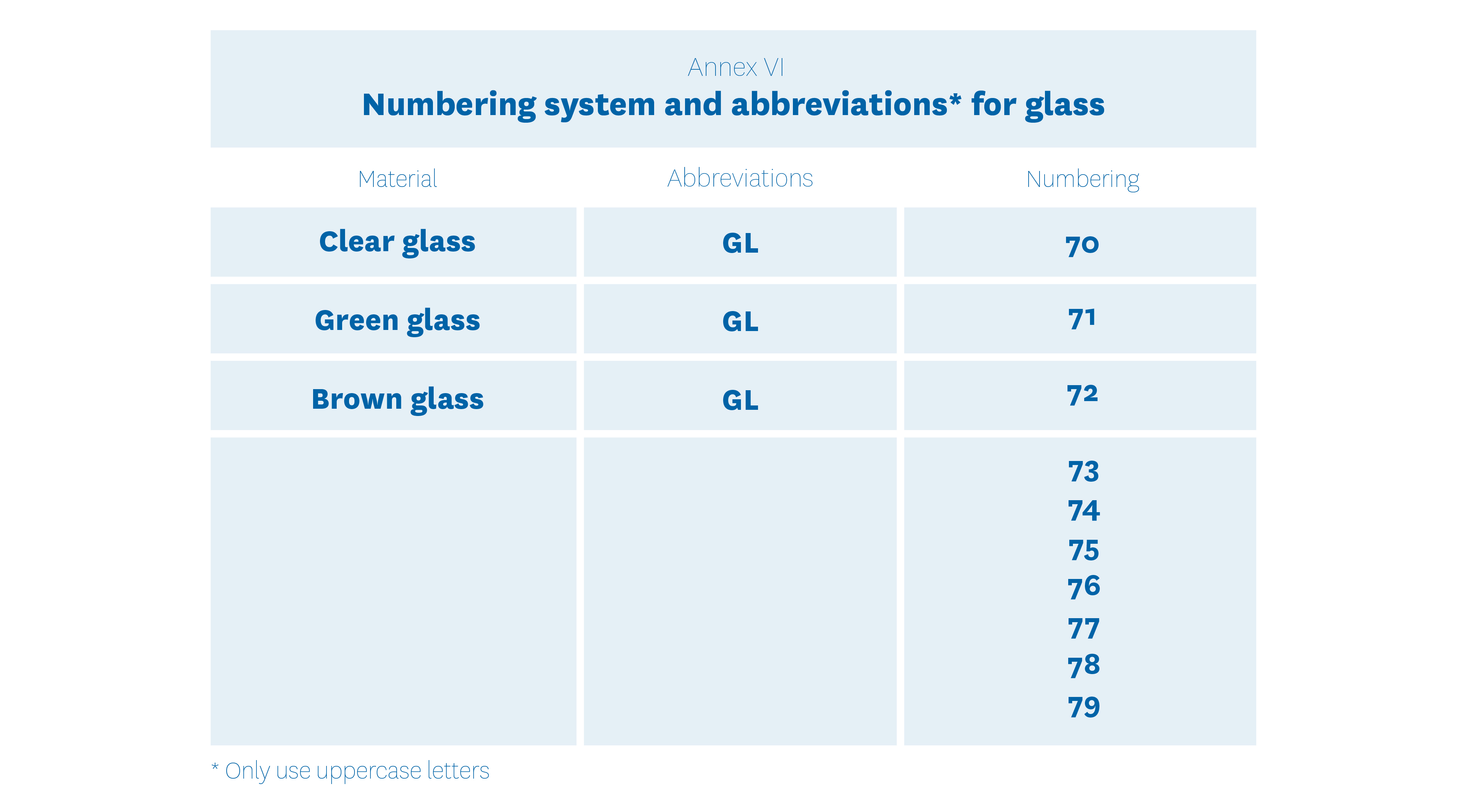
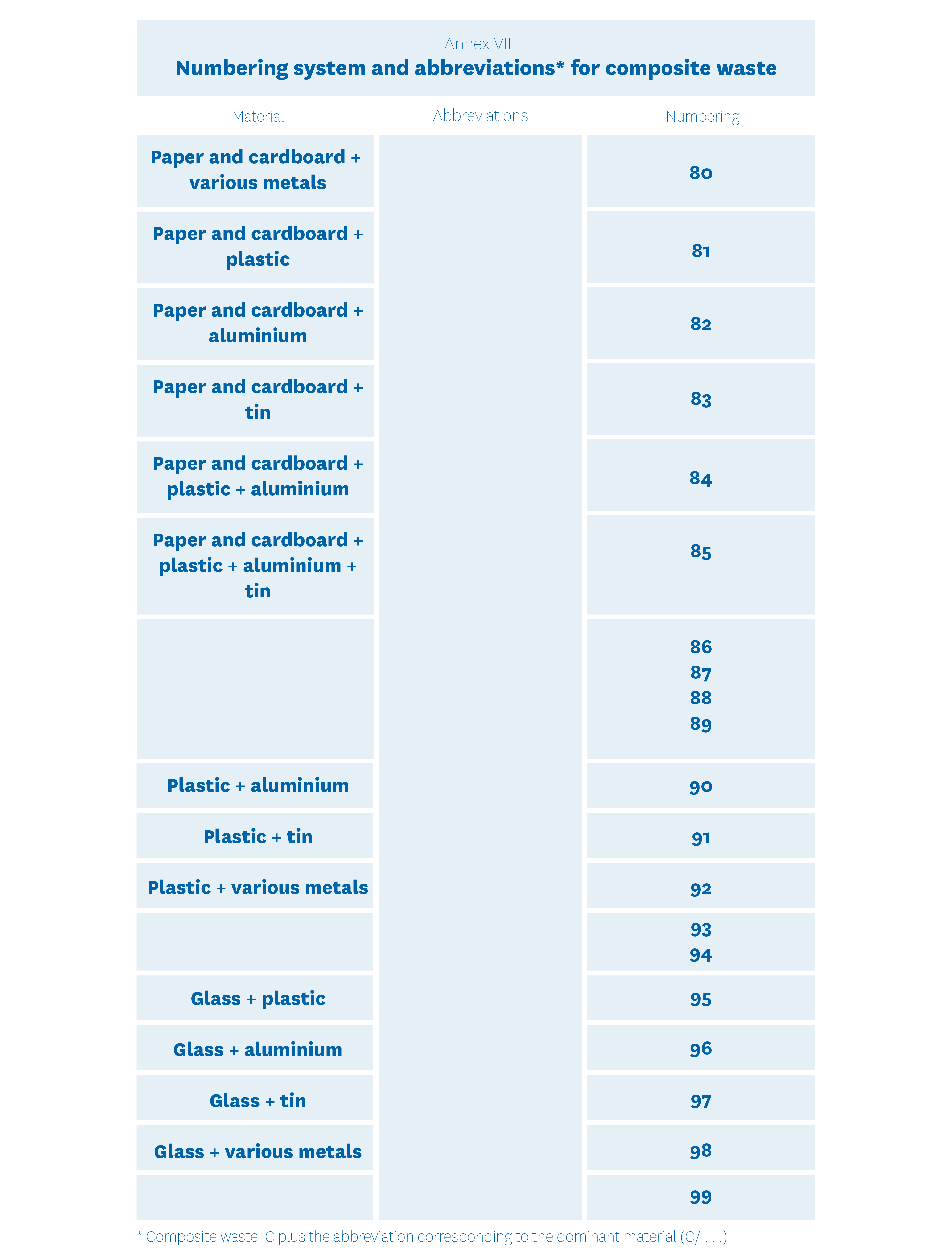
OTHER REGULATORY REFERENCES FOR THE IDENTIFICATION OF PACKAGING MATERIALS (for plastic packaging)
- UNI EN ISO 1043-1, Plastics — Symbols and abbreviated terms — Part 1: Basic polymers and their special characteristics.
This standard confirms the identification system of Decision 129/97/EC for plastic packaging. - UNI EN ISO 11469 Plastics — Generic identification and marking of plastics products
This standard is applicable in general to plastic products, in order to facilitate recognition in end-of-life recovery operations. The material’s identification code should be placed between the two symbols “>” and “<”; in the presence of more than one polymer or of additives and adjuvants, the characters “+” or “-” are placed respectively in between the abbreviations.
Consumer instructions for separate waste collection
(This information can also be found in the Handbook on voluntary environmental labelling guiding citizens in the separate collection of packaging waste)
In order to standardise and clarify information addressed to consumers and help companies guide end consumers towards correct disposal of packaging, in 2014 CONAI drafted the document entitled “Label for citizens – Handbook on voluntary environmental labelling guiding citizens in the separate collection of packaging waste”.
Although environmental labelling was not yet a legal requirement, over the years the method proposed by CONAI was applied by many companies, who considered it important to integrate legally required environmental information with additional indications providing concrete support for the management of packaging waste.
Originally, the aim of the project was to identify the minimum environmental information to be reported on the packaging in order to guide consumers towards effective waste separation.
This basic information answers the following questions:
- What is it? →It is important to specify which component you are referring to, especially in the case of multi-component packaging, in order to provide relevant information and not create confusion. It should also be made clear that the product in question is packaging and can therefore be collected separately.
- What material is it made from? →The type of material is expressed using the alphanumeric codes under Decision 129/97/EC. These codes may not always be clear or fully explanatory; therefore, it is important to state the material family of the packaging component, in order to remove all doubt and help the consumer recognise the packaging materials.
- Where does it go? → Stating the correct waste stream for that particular type of packaging is key to getting the consumer to dispose of it adequately. It is worth noting that different municipalities adopt different separate waste collection methods, but that these are always referable to the nature of the materials. In any case, given the variety of collection systems in existence throughout Italy, it is always worth reminding citizens to check their local municipal guidelines.
Voluntary environmental labelling
CONAI has drawn up Guidelines for voluntary environmental labelling of packaging, which you can consult and download at the following link: https://www.etichetta-conai.com/documenti/lg-etichettatura-volontaria/.
